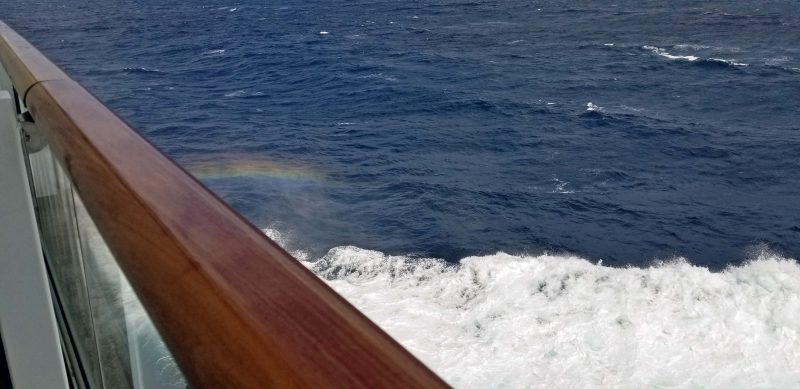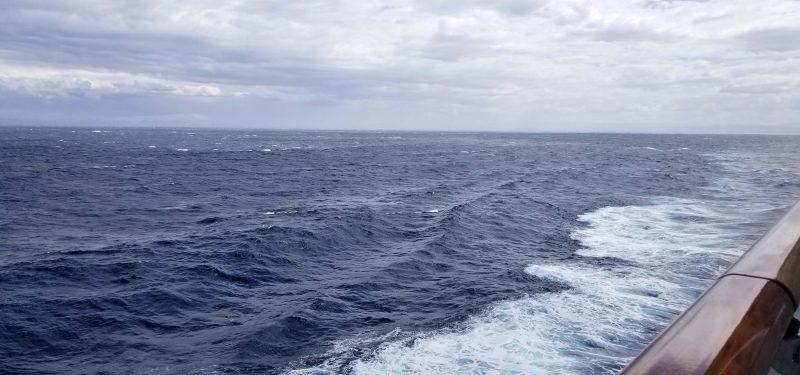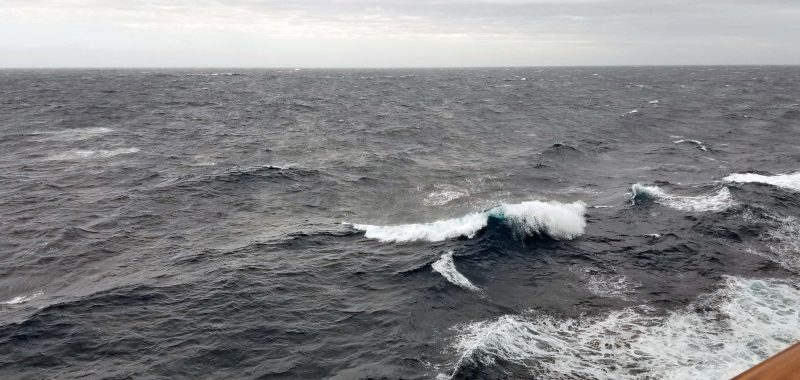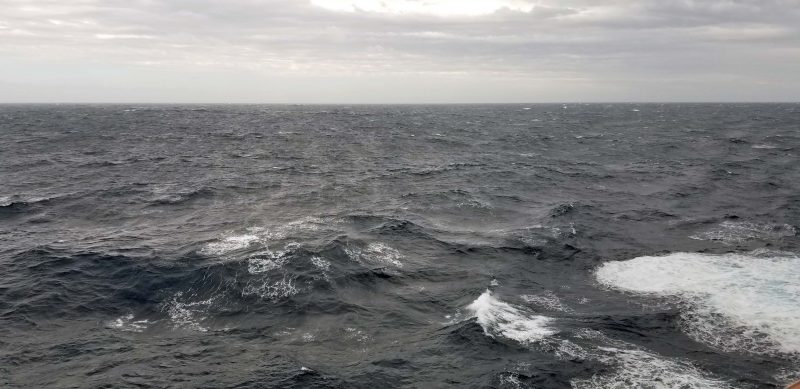
Decisions, decisions. . .


There is a worldwide shortage of condoms. Many condoms and contraceptives are manufactured in Asia–China, India, Malaysia, and Thailand–where COVID-19 has resulted in lockdowns of factories. Karex Bhd’s three factories in Malaysia make one of every five condoms in the world (10 million condoms per day) and the factories have been closed for 10 days, resulting in 100 million fewer condoms from that company alone.
A condom shortage could critically affect Africa’s fight against HIV, which would be serious. On the positive side, Dr. Mehmet Oz recommends having lots of sex while we’re quarantined. In his words, “You’ll live longer, get rid of tension, . . . [and] maybe you’ll make some babies.”
Birth rates often spike after cataclysmic events and natural disasters, so don’t be surprised if there’s a coronavirus baby boom in December.
In 2018, I was excited to see anonymously planted irises on a common ground near our house; in 2019, I designated an unusual redbud tree as a special sign of spring. This year, the designated “Dr. D Spring Award” goes to the fullest, pink cherry tree I’ve ever seen. Beautiful!
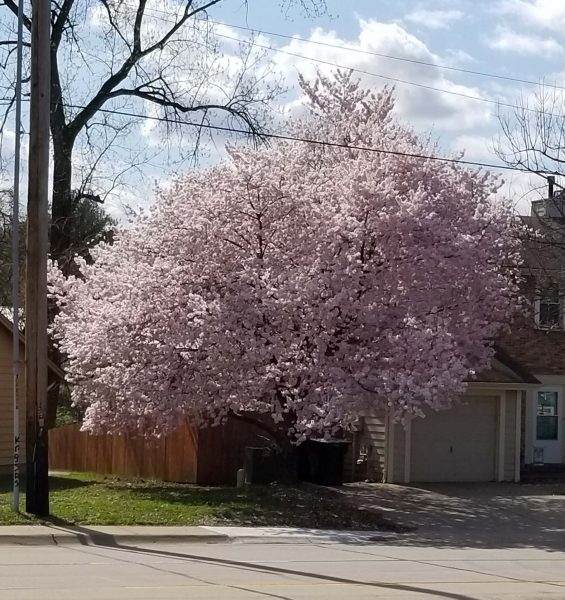
Kathy and Annette came for an overnight visit to celebrate my birthday. Luckily, I was going to count their visit day as my “official” birthday, because on my real birthday, everything went wrong. Nothing I did all day turned out right–it either took much longer than it should have because of interruptions and challenges, or it totally flopped. After Kathy and Annette arrived, however, everything was good. Even my traditional birthday Vienna Torte was a success. Kathy and Annette brought good vibes to my birthday weekend.
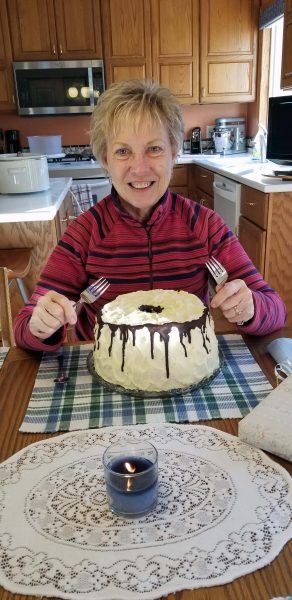
Before Kathy and Annette arrived, my birthday gift from Ted was delivered by FedEx. It came from Hana, Maui.
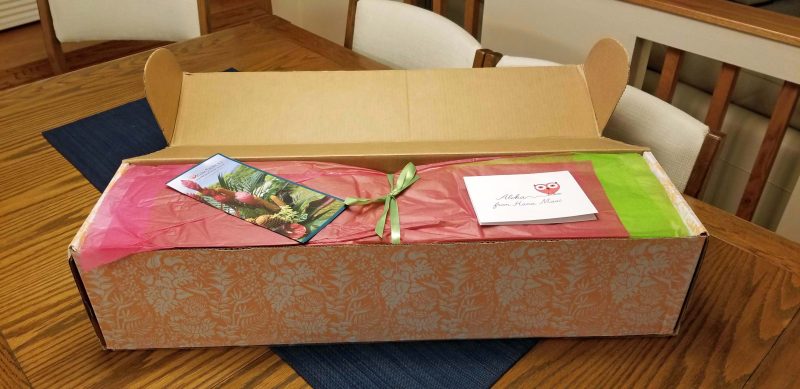
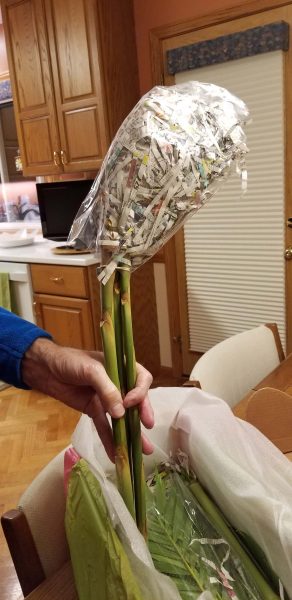
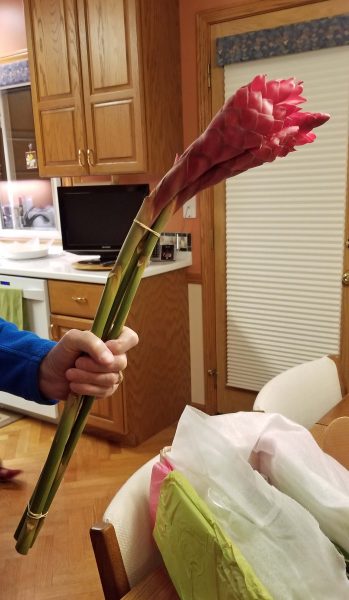
Kathy is far more artistic than I am, so I asked her to arrange the flowers in a vase for me. She looked at them and said, “Of course. That’s easy.” Meanwhile, my thought was, “Whew! I didn’t know where to begin.”
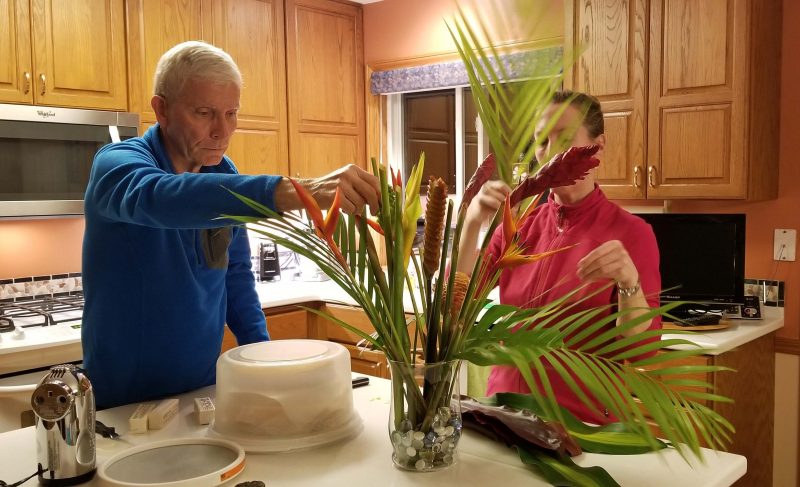
After a few minutes, Kathy’s efforts produced a beautiful tropical flower arrangement.
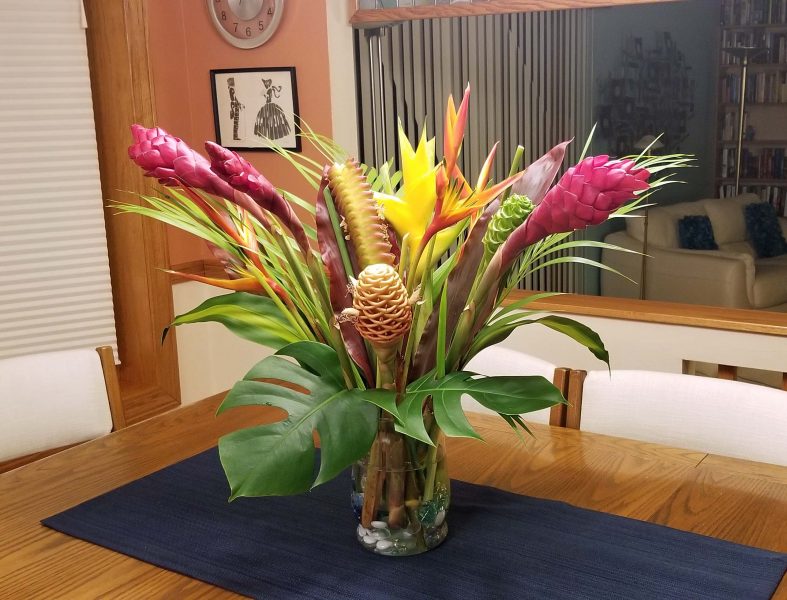
Afternoon temperatures were only in the 50s, but the wind was calm and the sun was warm, so we went e-bike riding. After showing Kathy and Annette how e-bikes work (not much different from regular bikes), Kathy and I went out first. We biked about 8 miles and then Kathy and Annette biked for another 6 miles while Ted and I put dinner (and Vienna Torte) on the table.
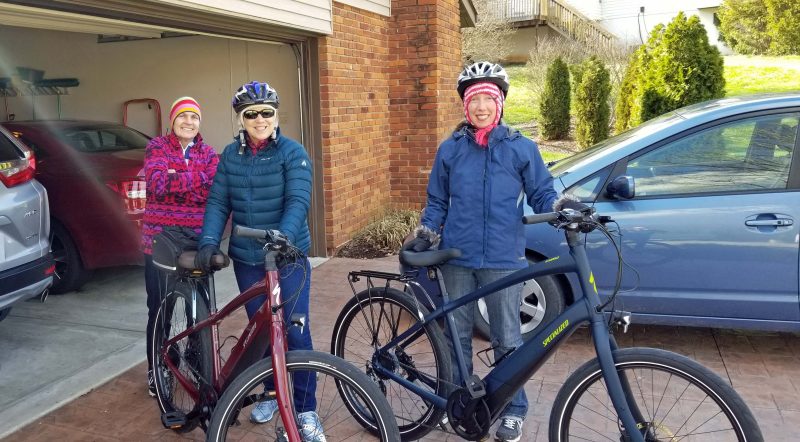
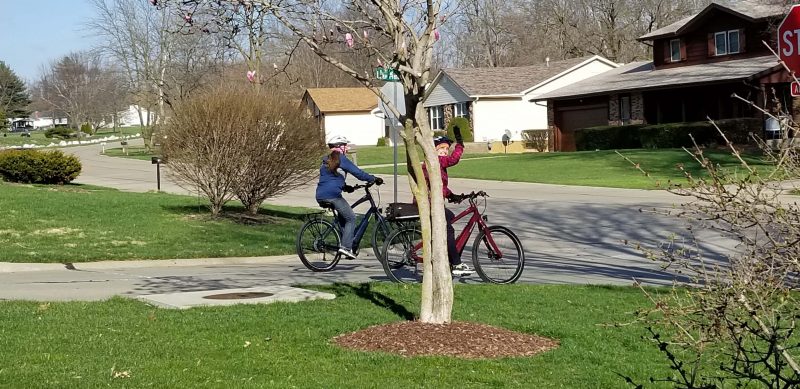
I always enjoy my birthday–even if it’s not on my actual birth date, and especially with good company and Vienna Torte.
On Thursday, it was a sunny 72 degrees; on Sunday, it was a snowy 34 degrees. This begs the question: Is it spring?
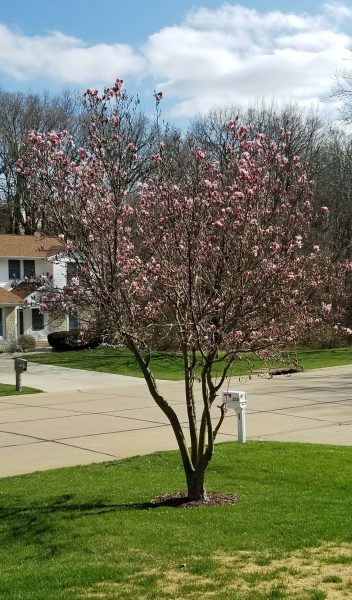
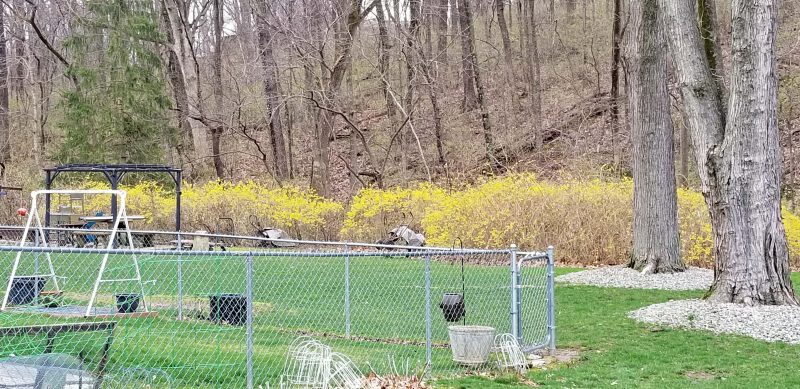
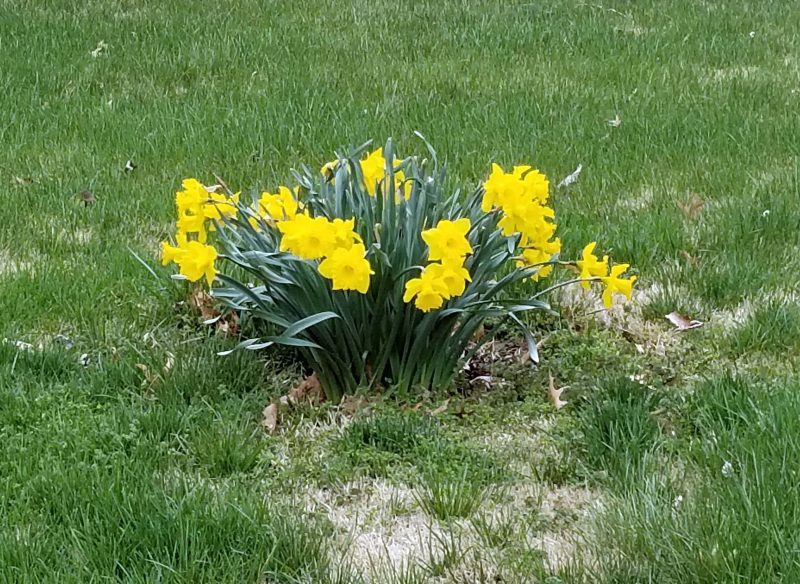
Or not?

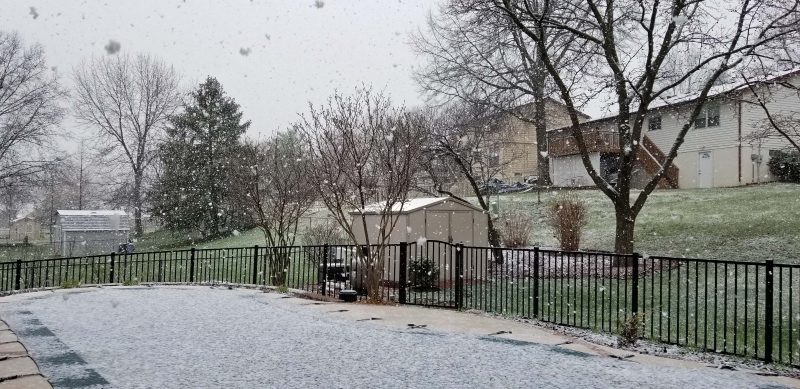
It was only a matter of time before people cooped up in their homes turned to Facebook to post Covid-19 memes. These were posted by Ted’s FB friends. I apologize for the cut-off letters, but that’s how they appeared on FB. Think of it as your challenge for the day to complete the words. With that said, are you ready for some laughs? Let’s go!
There’s a whole series on cats.
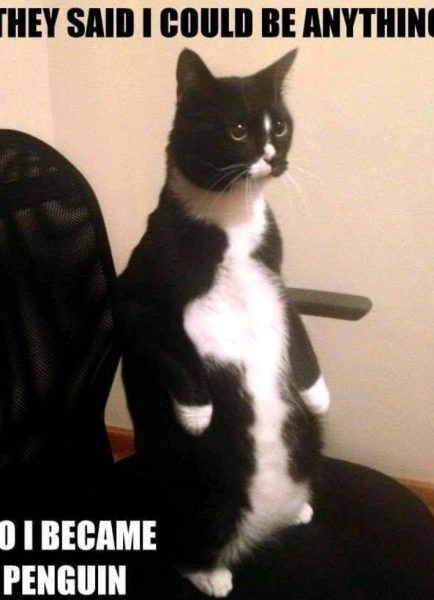




A few of the memes refer to Covid-19 in general.
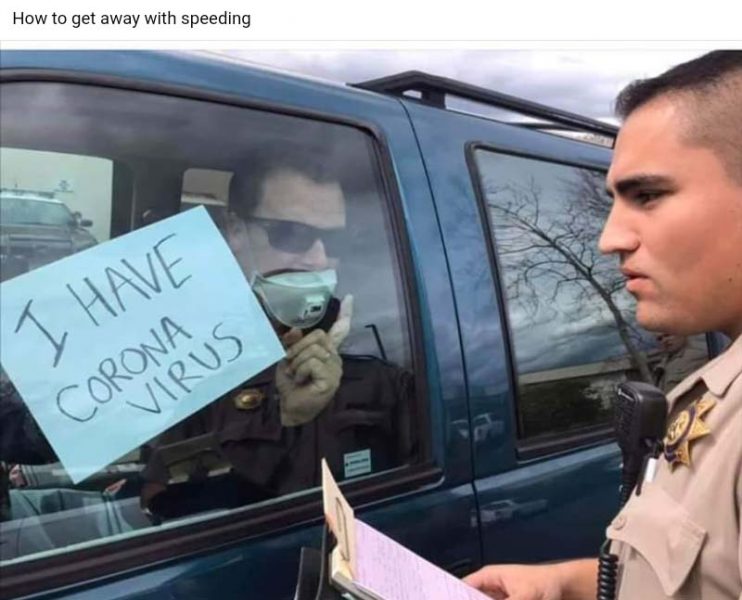

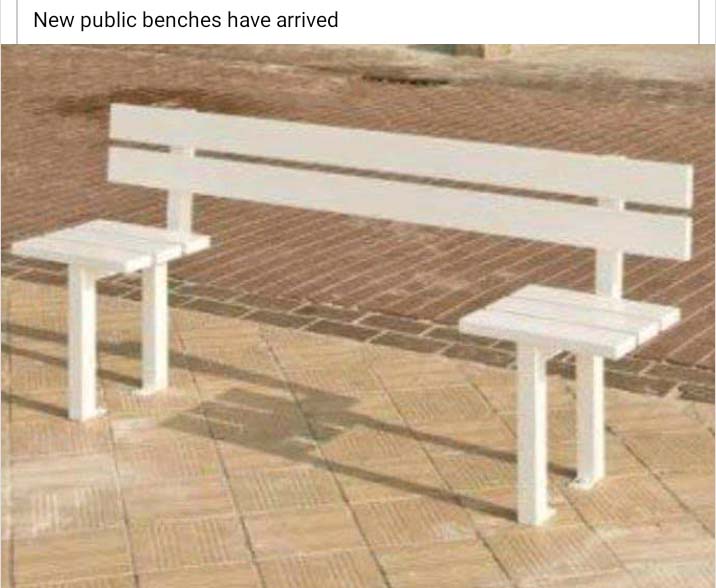

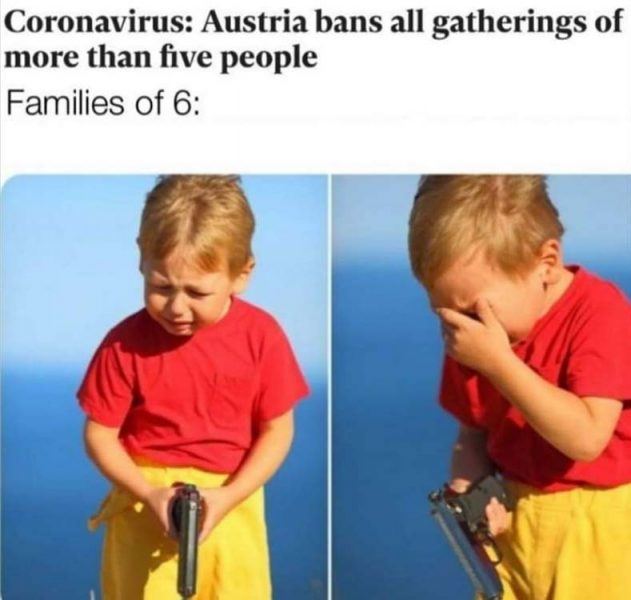
It’s no surprise that most of the memes address toilet paper hoarding and shortages.
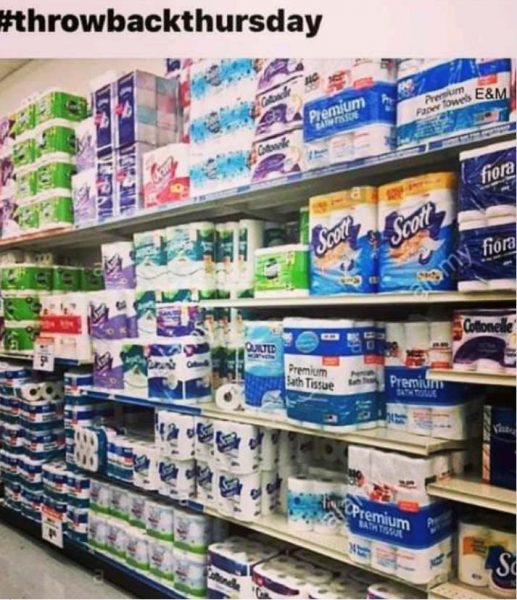
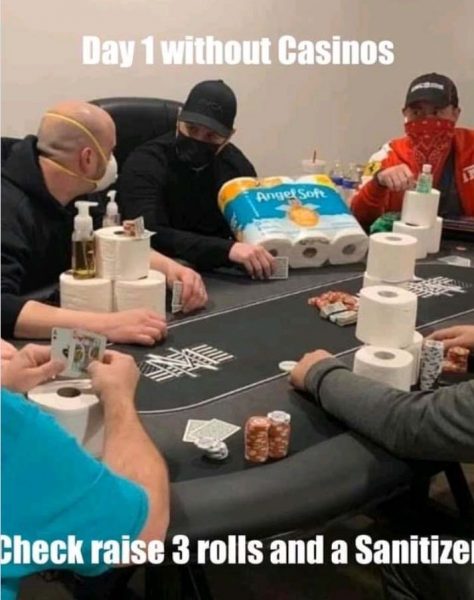

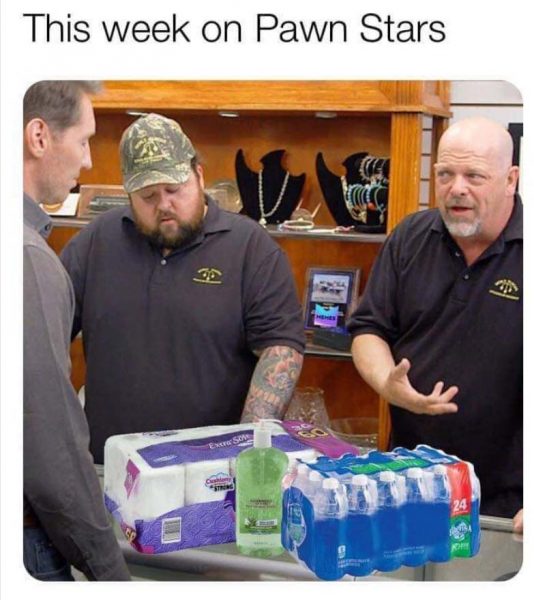

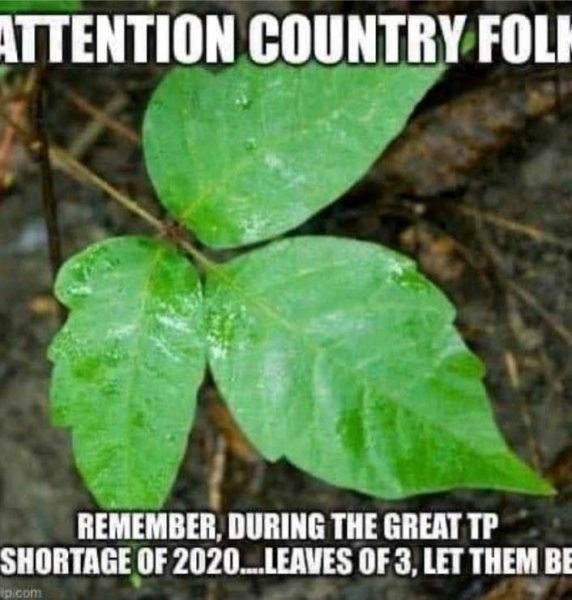
I’ve been making cranberry-orange nut bread since 1970 and never had a problem until recently. Today, I discovered the reason. At some point, I re-copied the recipe and made two critical typos and one not-so-critical typo. (1) I typed 1/2 tsp. of baking powder instead of 1-1/2 tsp; (2) I omitted the 1/2 tsp. baking soda; and (3) I reduced the cranberries by half. Without 3/4 of my leavening ingredients, it’s no wonder my bread was so hard and dry.
I shared this recipe with many people over the years. If I shared it with any of my readers, check the recipe I gave you against the one below. This is the correct one.

I felt like making yeast dough today, so we have homemade cinnamon-raisin sweet rolls. Yum!

What’s wrong with this picture?
Hint: Zoom in on the green sticker on the license plate.
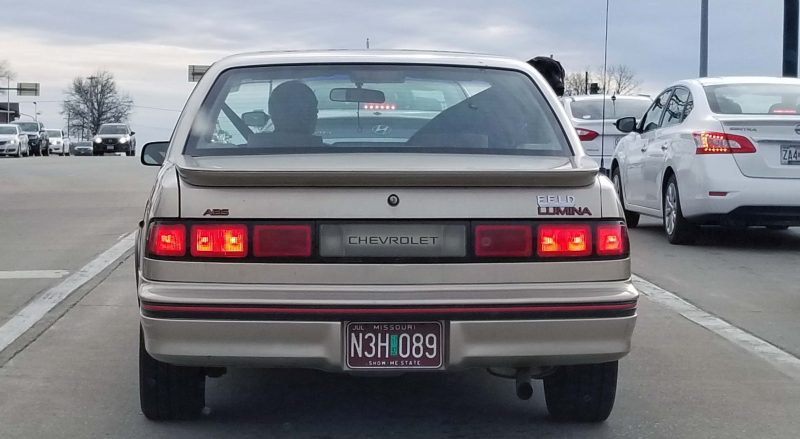
By not renewing his license plate since 1992, this guy has saved about $1,500. Not to mention that he didn’t have to stand in line at the DMV office.
One of Ted’s Facebook friends posted this. It’s from Adelaide, Victoria (Australia.) I guess our local Target store isn’t the only place that’s out of toilet paper.
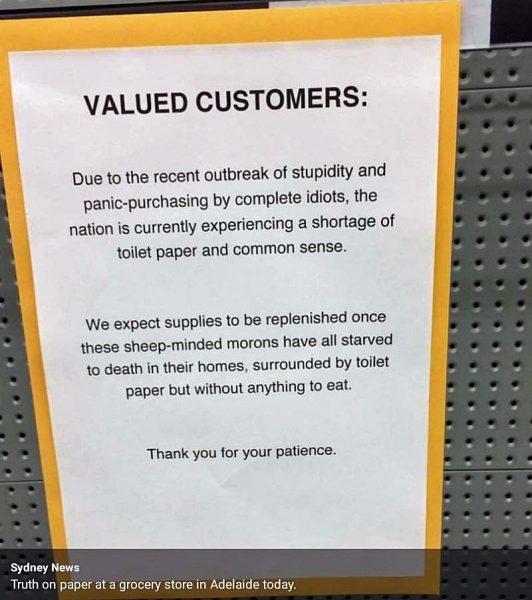
Shortages predicted to result from coronavirus-related production and shipping problems are causing people to horde supplies they think they will need. I’m not hoarding anything, but I get this, so I wasn’t surprised to see Wal-Mart’s shelves stripped of pain and fever-reducing medications, sterilizing mouthwash, and hand sanitizers. Yet, it seems like one product is being hoarded more than anything else.
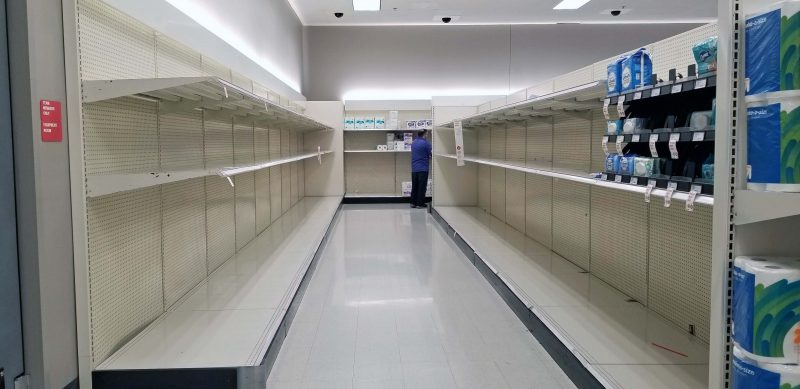
That’s what Target’s toilet paper shelves looked like last night. Why are people hoarding toilet paper? One article I read suggested that buying lots of toilet paper might be making people feel like they have some control over the coronavirus, and therefore helps to calm them. If that’s true, there must be a lot of very calm people out there.
Normal humidity in St. Louis at this time of year is about 40-50 percent. Thirty percent would be considered very low humidity. (Information provided by in-house meteorologist.) On Sunday, our humidity was 16 percent at its lowest; 17 percent when I took this screenshot.
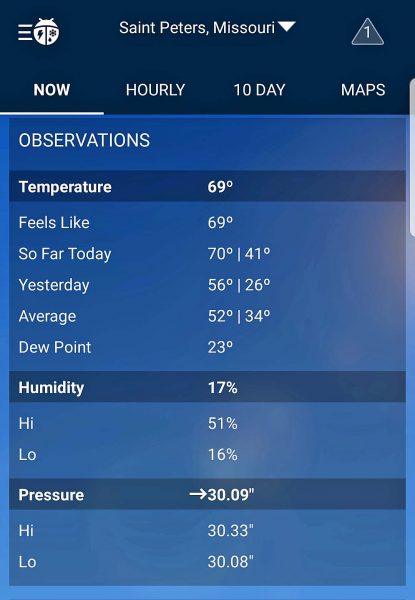
So what do you get in this area when the humidity gets that low? A fire weather warning! If it’s not one thing, it’s another. At least it wasn’t a spring tornado.
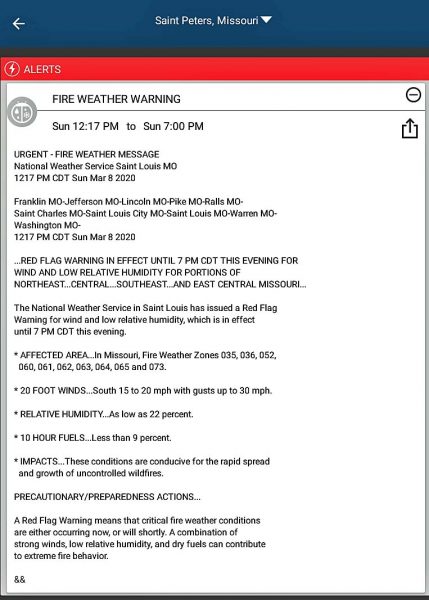
2020 U.S. census forms were mailed yesterday and will be in a mailbox near you soon. How will you respond?

After deciding to get back to scanning old photos, I remembered two boxes of photos in storage–one from Ted’s family and one from mine that we received after our parents died. We took our respective boxes and went to work last night. Ted had more pictures to sort because I had already winnowed mine a little bit many years ago. It’s really interesting to go back through family history and to remember things that happened in the way back.
This four-generation picture taken on my mother’s first birthday, is one of the oldest family photos I have. From the left, that’s my grandpa (Lorenz Lorenzen), my mother (Violet), my great-great-grandmother (Eliza Lorenzen, paternal grandmother of my grandpa), and my great-grandfather (Peter Lorenzen, father of my grandpa and son of Eliza Lorenzen).
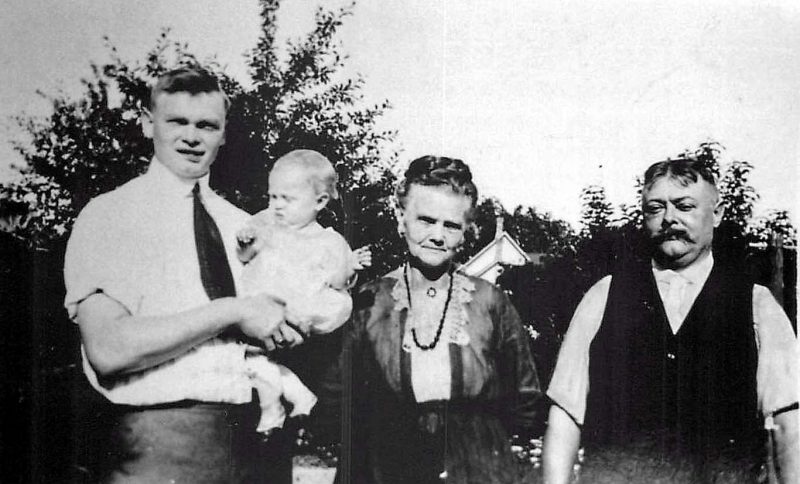
Jumping to my dad’s side of the family, that’s my great-grandmother, Johanna (Josie) Dell with her three children: (L>R) Gladys, Philip, and Mabel (my dad’s mother). Great-uncle Phil had an apple orchard just north of Hingham, my hometown. Grandma Dell lived about a hundred feet up the street from us and I remember walking up to visit with her when I’d see her sitting on her porch. She always seemed to have a cookie for me. She died when I was six years old.
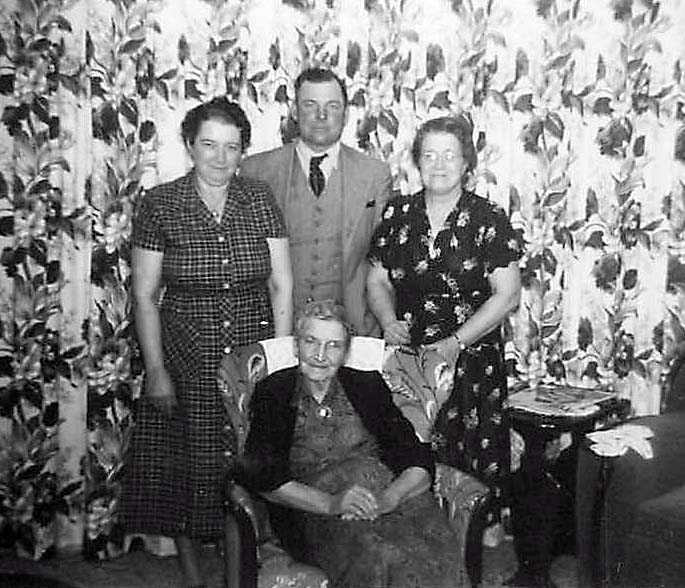
Here’s Great-grandma Dell with her great-grandchildren in 1950. I hope I live to see this many great-grandchildren. That’s me and my brother Denny in the coaster wagon. My cousin Carol is the oldest and is standing right in front of Grandma. Carol died two years later of meningitis. My Grandma Soerens buried two grandchildren before she died–Carol and my four-year-old cousin Lori, who was killed by a hit-and-run driver. My Grandma Lorenzen buried her eight-year-old son (who died of a ruptured appendix), a stillborn grandson, and my oldest brother (Denny, who died at 27 in an Air Force plane crash). Ted and I are fortunate that our children and grandchildren are all healthy and with us.
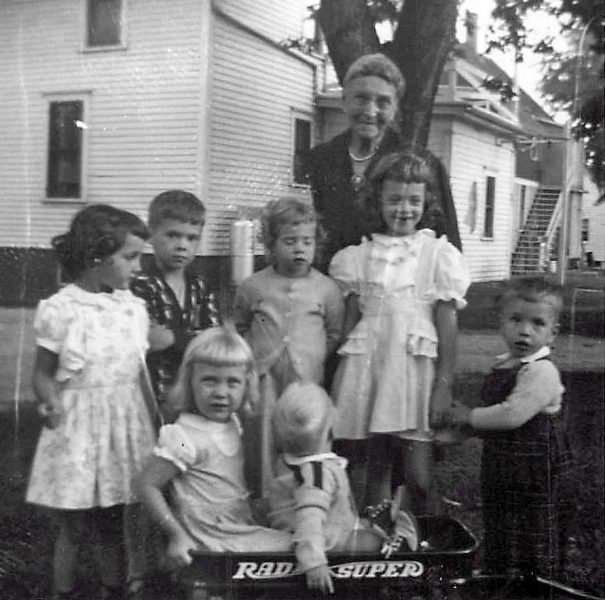
Grandparents (including Ted and me) love to have pictures of themselves with their grandchildren. Here are Grandma and Grandpa Lorenzen on their 35th wedding anniversary with their grandchildren. I’m the oldest, in the center, and my brothers are to the right of me in the photo–Tom, Steve, and Denny. Russ is the little guy on the right at the table.
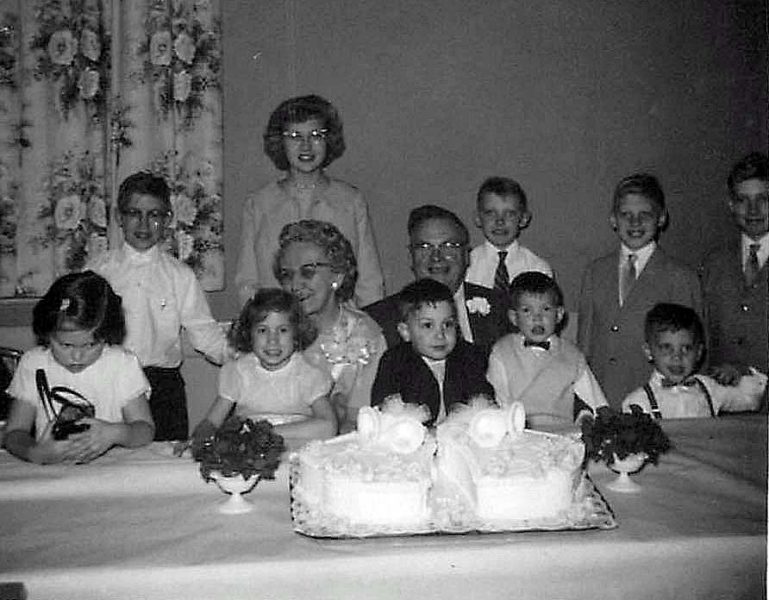
There were some fun pictures of siblings in my pile. Here’s my dad (back center) with four of his five siblings. There was one more to come.

As the older sister, I tried to help mom with this photograph by turning Denny’s head toward the camera. He didn’t like it.
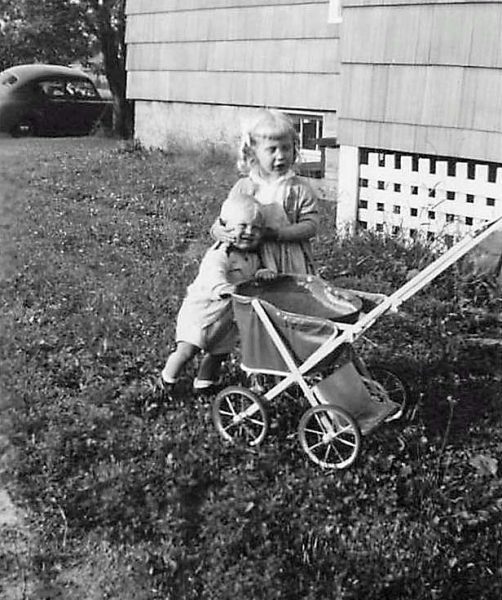
This is Denny, me, and Steve. That’s not our dog, so it must be an early photo-bomber.
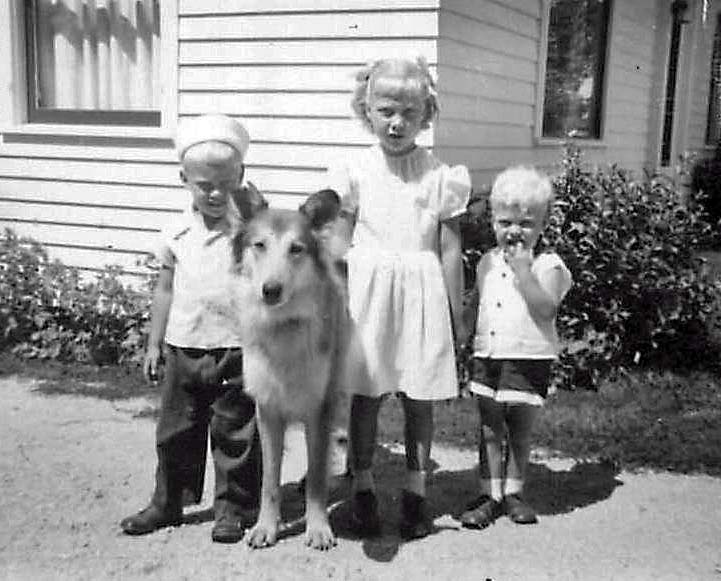
My dad built this little shed to store our trikes, bikes, wagons, and other outdoor toys. “Hey, kids! Wanna paint the shed?” That’s Steve and me, hard at work.
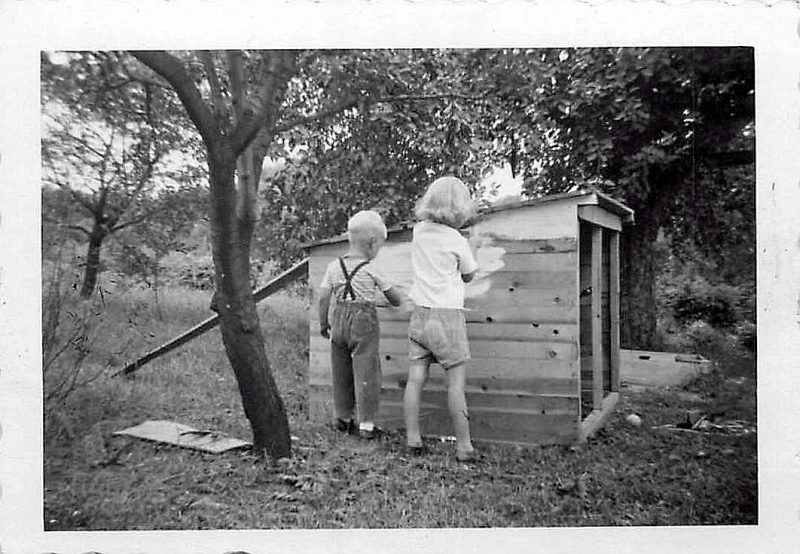
My mom took this picture of Dad, Steve, Denny, and me, but she never liked it. I think it was supposed to be a “planting and greening of the earth” moment, but she always said it looked like we were trying to eke out a living on a hardscrabble farm. Those are our raspberry bushes and cherry trees in the background.
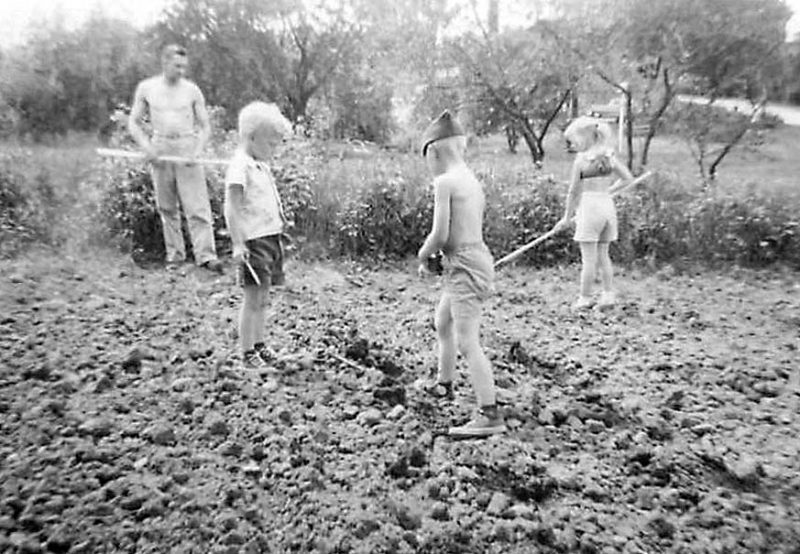
Maybe modeling runs in the family. Here’s Grandma Lorenzen, Mom, and me struttin’ our stuff.
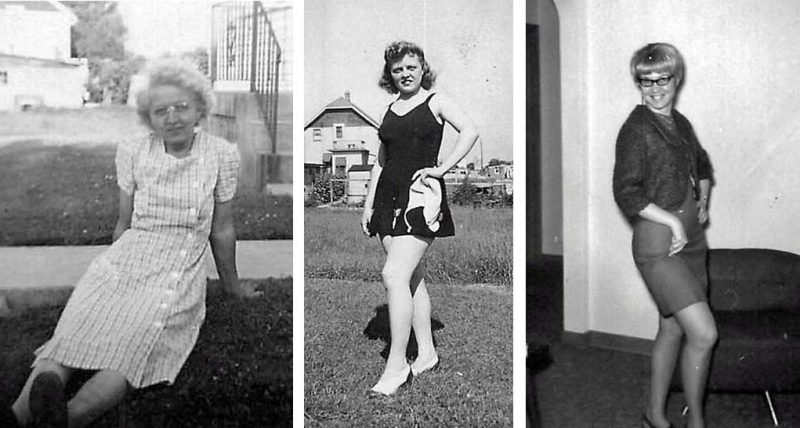
In the 1950s, the majority of married women did not have full-time jobs. Apparently, our homemaking training started early. Here I am, at about three years old, ironing my doll clothes in the left picture. The iron has a cord and actually warmed up a little bit. That’s why I’m testing it with my hand. On the right side of the left photo, you can see my doll, patiently waiting in her buggy for freshly ironed clothes.
In the right photo, I’ve got my household set up on the front porch. That’s Steve in the doll crib. Note that there’s a dresser for my doll’s clothes, a cupboard with doll dishes in it, a table and chairs, and a buggy for the baby doll. The two boys in the center are our neighbors; the girls might be their nieces who lived in Florida and visited every summer. (The boys had a much older brother and sister.)
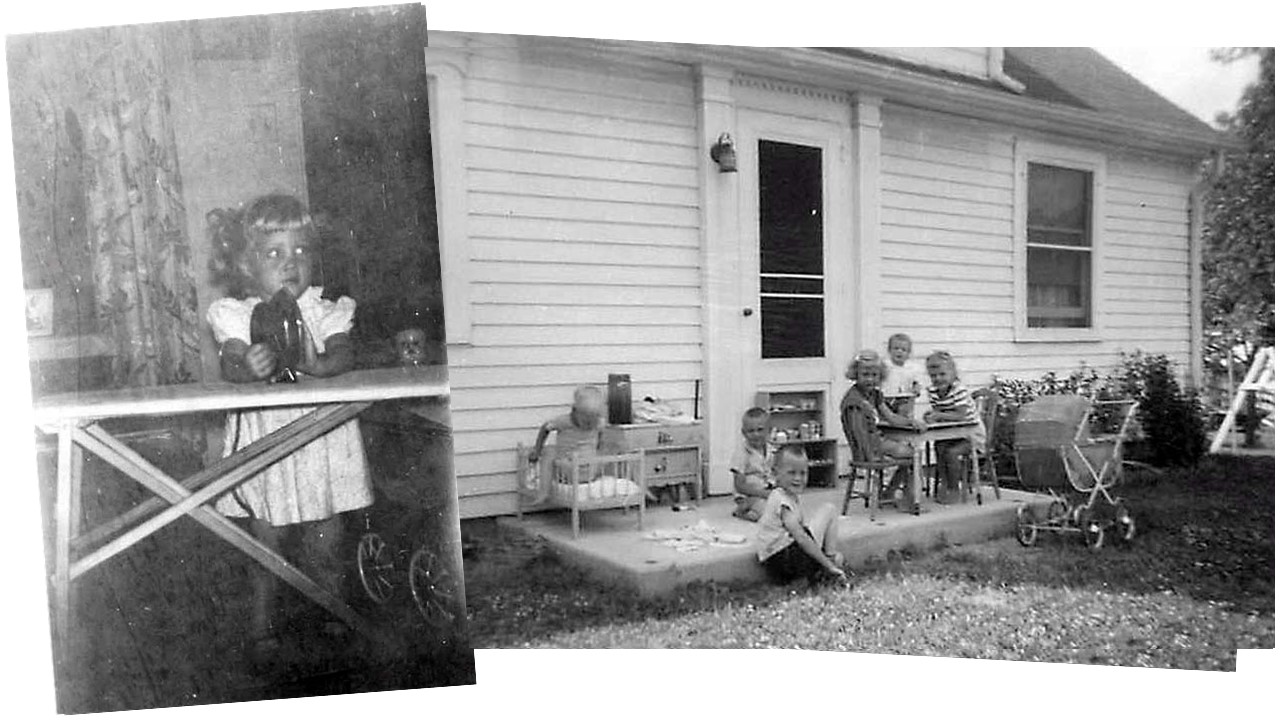
I joined the Hingham Wide-Awakes 4-H Club when I was ten years old. One of my “projects” that I worked on each year was sewing (still learning to be a housewife). I’m eleven in the photos below and I’m modeling the clothes that I sewed and entered in the County Fair. The pictures went into my 4-H Record Book that I completed each year to describe my year’s club activities.
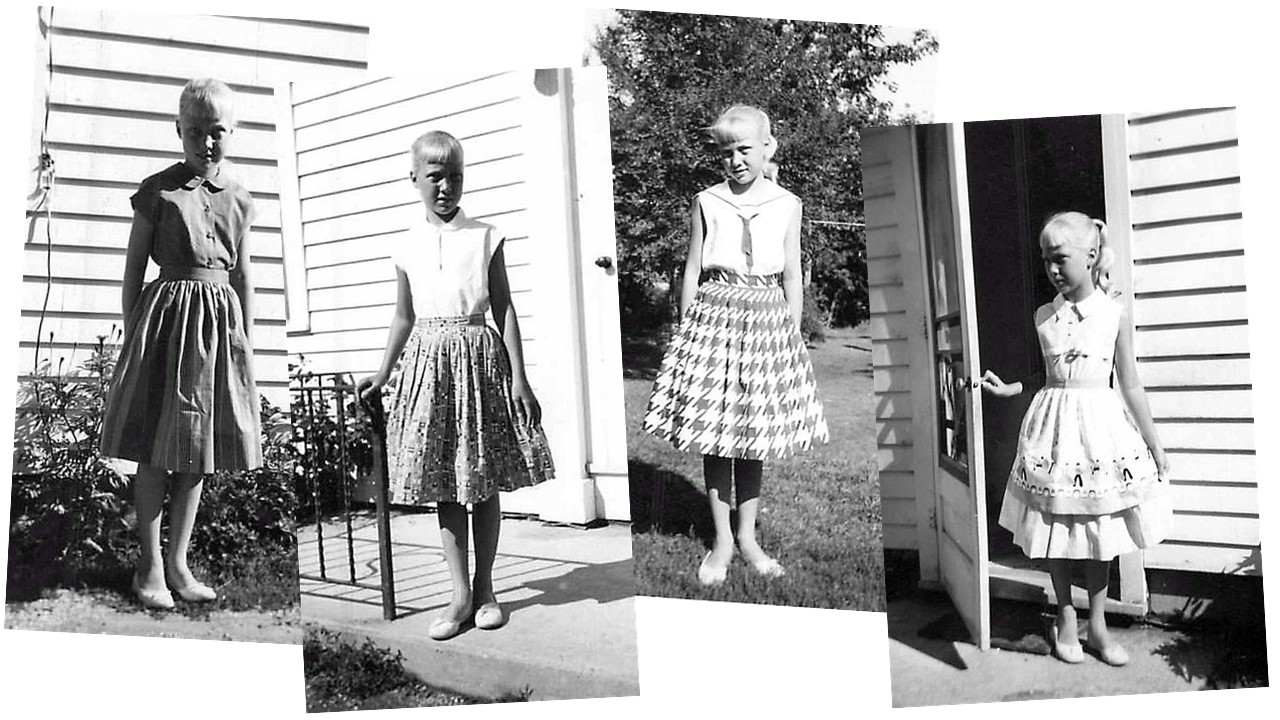
Another 4-H activity was demonstrations. We gave them at meetings and there was also a county-wide demonstration contest with cash prizes. Here I’m practicing my demonstration on how to make a scarf. It’s more documentation for my record book.
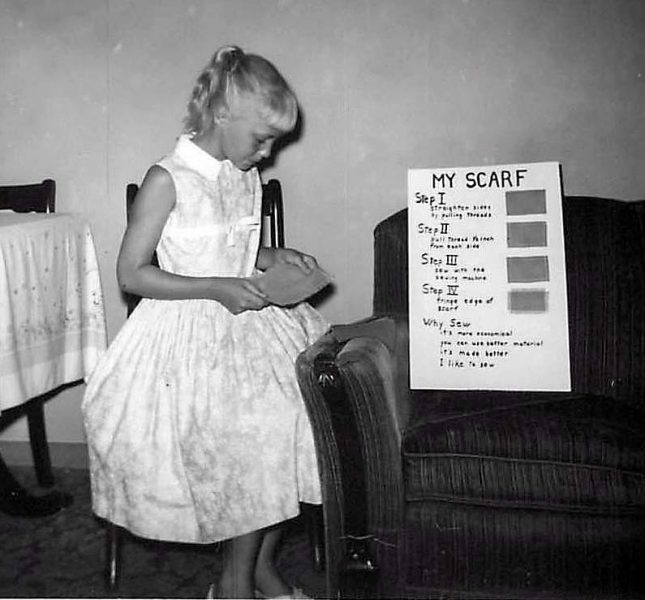
Since this was a pile of my family photos and since I was my parents’ first baby, there are a lot of pictures of me. Here are a few. I’m probably under a year old and enjoying my first winter. If the baby keeps falling off the sled, put her in a cardboard box.
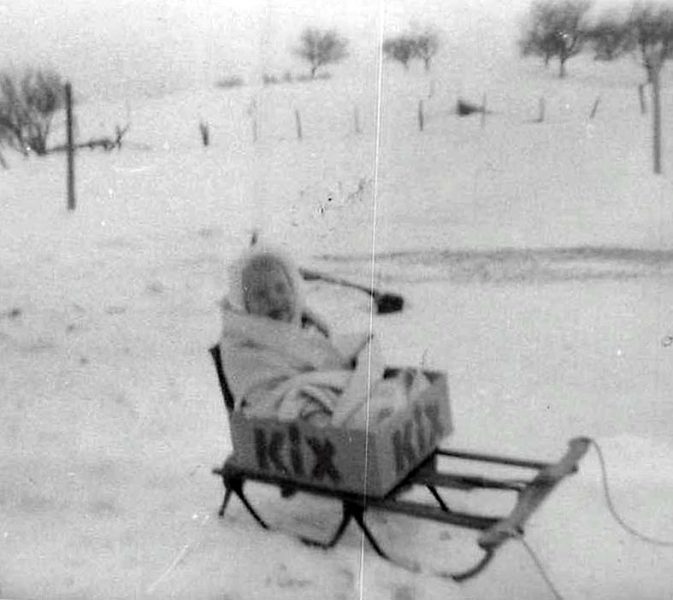
My mom (and everyone else) had a wringer washing machine when I was little, and I used to “catch” the pieces of laundry as they came through the wringer. On my third birthday, my hand got caught in the turning rollers of the wringer and they scraped the skin off the back of my hand. All of my third birthday pictures show a big splotch of mercurochrome over the injury. Mercurochrome didn’t sting like iodine, but it actually had a little mercury in it, so it’s no surprise it was later banned.
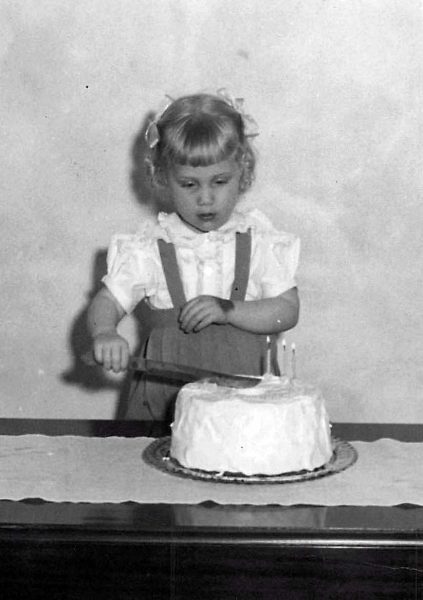
I tried out for and got a part in most of the high school plays. Here I am, hoopskirts and all, in Jane Eyre. The home ec classes made the play costumes; the shop classes made the sets.
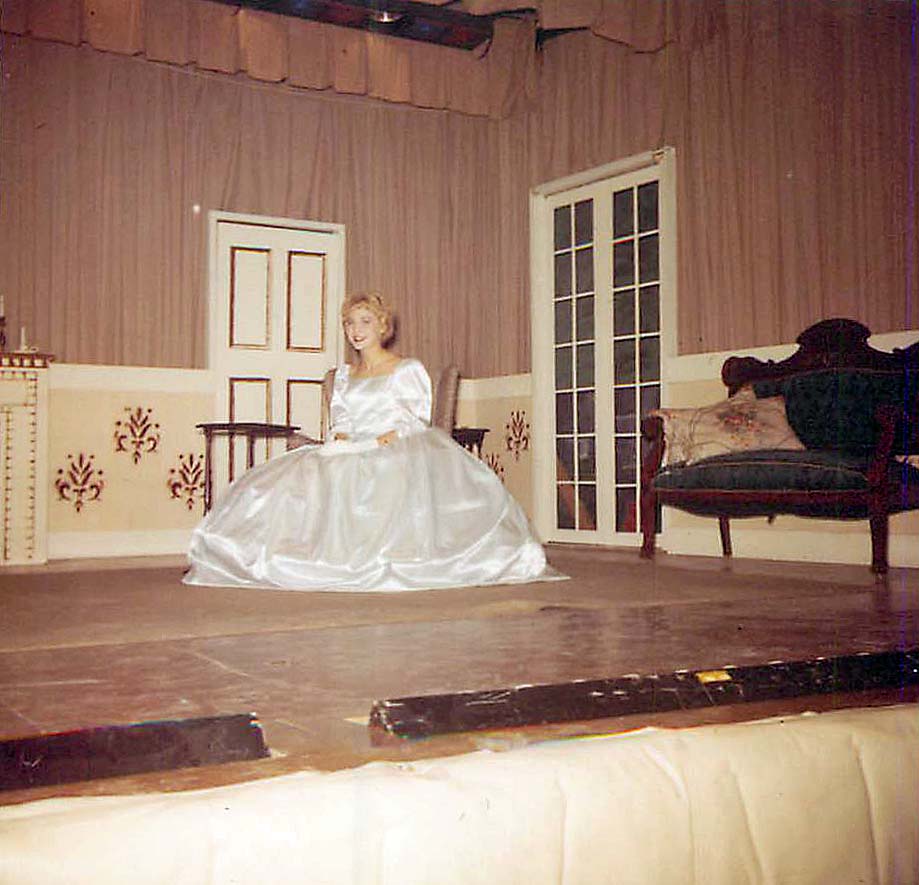
The last picture from this batch of historic photos shows me in my band uniform. I played first chair clarinet and I was also in the pep band. Pep band got me free admission to all the home games. Good times! Knowing my mom and the way she tried to make her photos look good, I suspect she removed the corner table to take this picture.
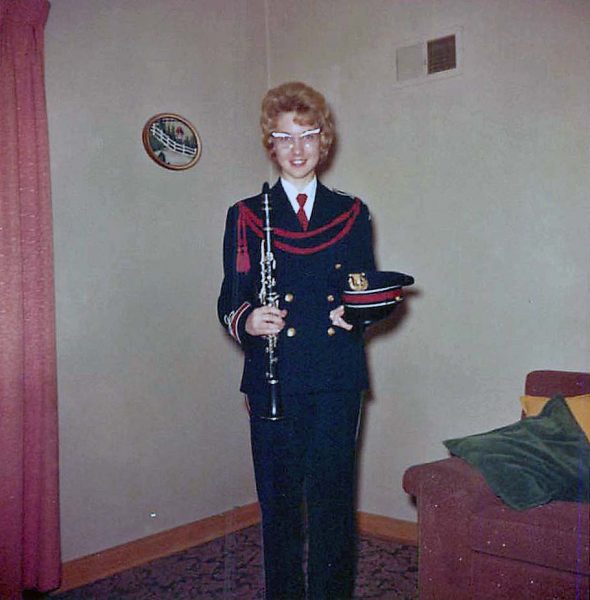
Ted and I made a Wal-Mart run and were surprised to see how many empty shelves there were in the store. Every department had gaping empty shelf spaces. Is the coronavirus affecting shipments and supplies? Are people buying and hoarding things faster than Wal-Mart can re-stock them? We don’t know, but it was a weird Wal-Mart shopping experience. Some of the empty shelves we saw were in groceries, . . .
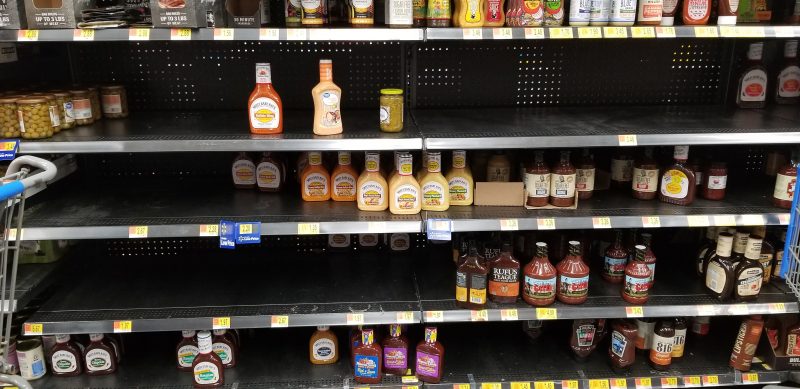
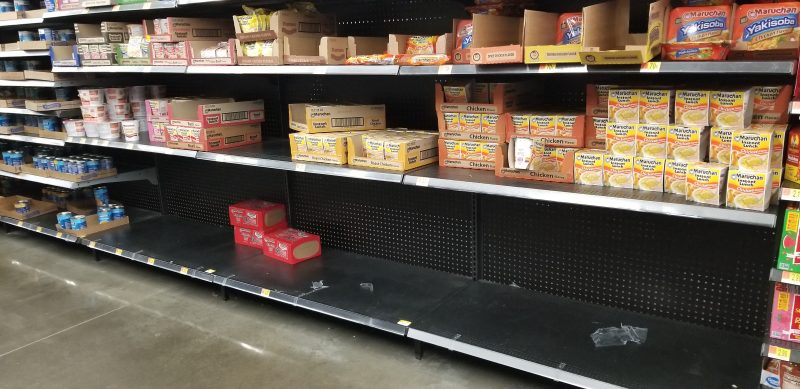
kitchen utensils, . . .
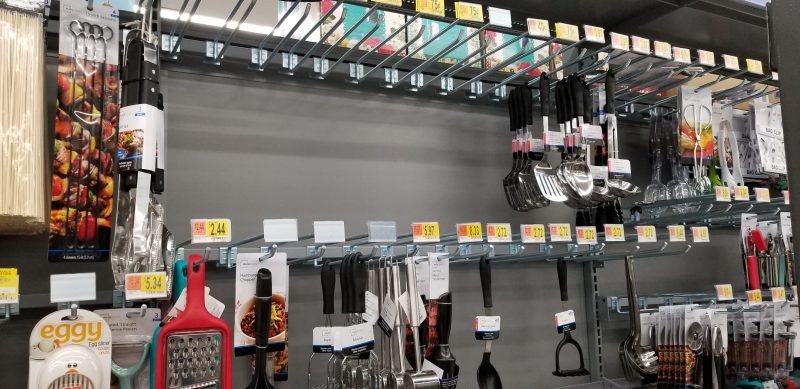
pens and markers, . . .

pain-killing and fever-reducing medications, . . .
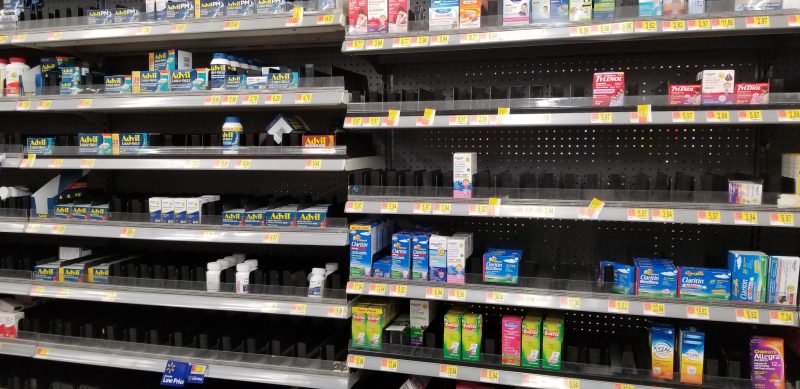
and germ-killing mouth washes.

I started scanning selected pictures from old photo albums and posted a few of them on this blog in August, October, and December 2018. Several months ago, one of my readers (name begins with “J”) asked when I was going to post some more old photos. With reader demand like that, I decided it was time to go through some more photo albums. Last night, I picked up where I left off more than a year ago. Let’s start with the big project of 1981.
Ted and I moved from Washington, D.C. to Missouri in July 1973, just six weeks after Kathy was born. Here’s where we lived in St. Charles.
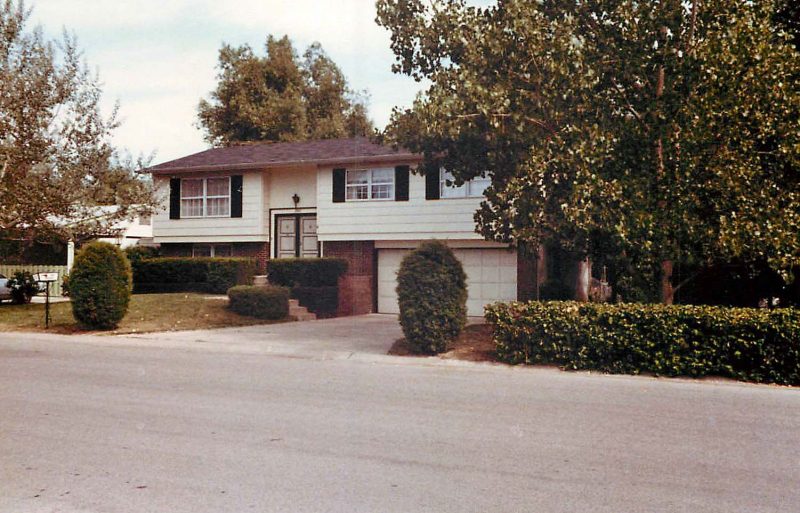
We had a deck over the patio in the back of the house. We frequently used both levels, depending on whether we were looking for shade or sun. The patio included a gas grill / oven that was connected to the gas line for the house. I used it to cook roasts, casseroles, etc. and sometimes, when Ted came home after an evening shift, he’d grill hamburgers for the two of us out there after midnight. The galvanized watering tank was a popular style of backyard swimming pool in this area in those days. Question: how did we get it home with the Opel?
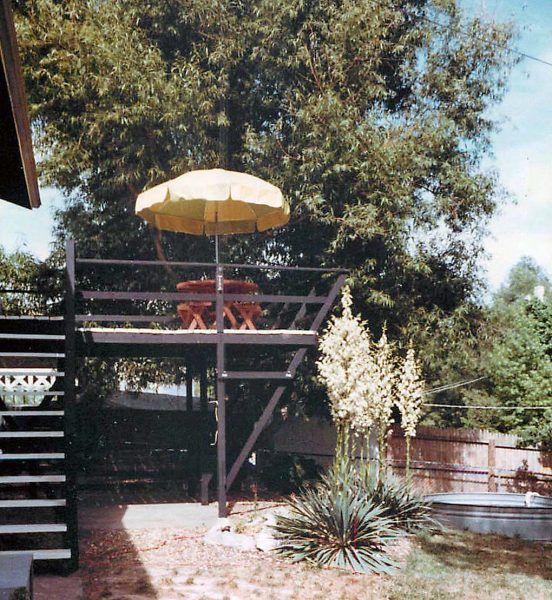
The back yard dropped sharply down to two drainage creeks. Ted and I built those two redwood bridges so we could access those parts of our yard. The swimming pool and swing set were in the “middle” back yard, and the garden was across the second creek in the “back” back yard. (The back yard against the house was the back yard.) This was a pretty view from the deck in the summer, especially when the garden was in full growth.
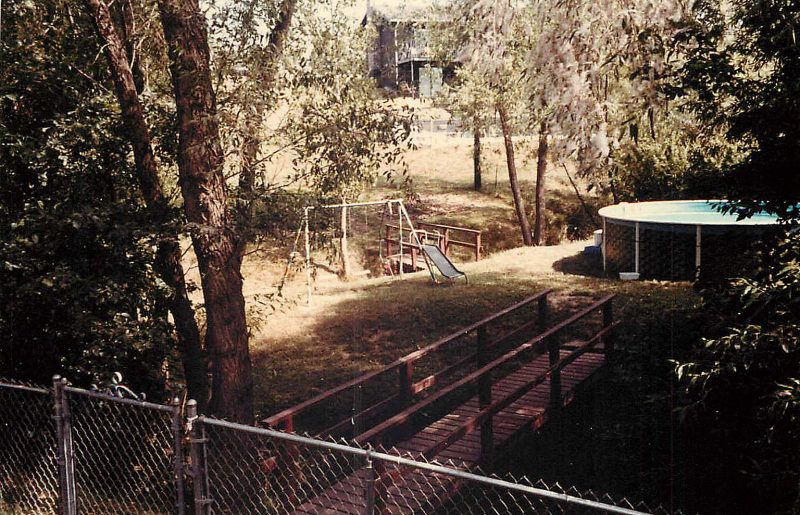
Thom and Kari were born while we lived in St. Charles and we needed a larger house. In 1979, we moved to St. Peters and bought our current house. The sale closing date was 7-9-79. The subdivision was very new and ours was the first house built on this plat. The house and the neighborhood were both undeveloped and stark when we moved in. I could wave to our nearest neighbor in the distance if we both got the mail at the same time and saw each other. For several years, we lived with constant construction noise as other families built houses in the subdivision.
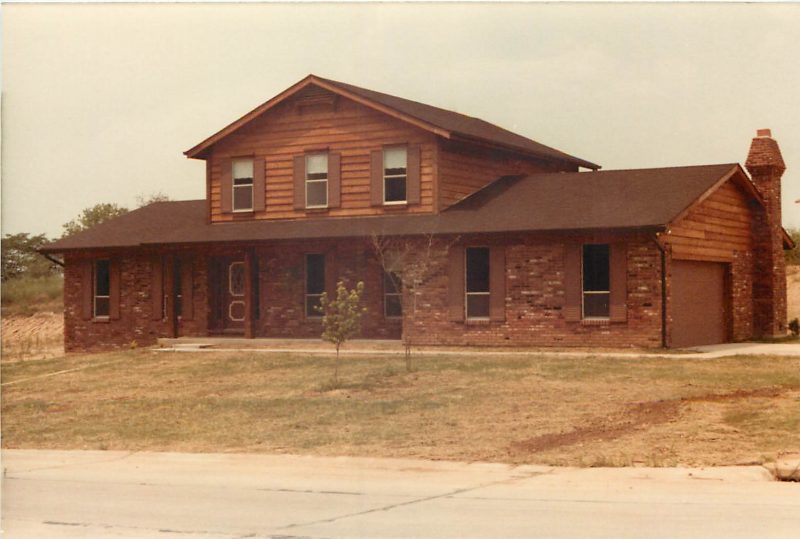
The deck furniture and the watering tank swimming pool made the move with us. We used that watering tank pool for a week or two before we joined the subdivision swimming pool. Ted and Jeff walked to the pool (five vacant lots down the street) to see if we could buy a pro-rated membership for the remainder of the summer. I’ll never forget the look of pure joy on Jeff’s face when he and Ted came home with a family pool membership. We all put on our swimsuits and headed for the subdivision pool. Next question: How did we get rid of the watering tank?
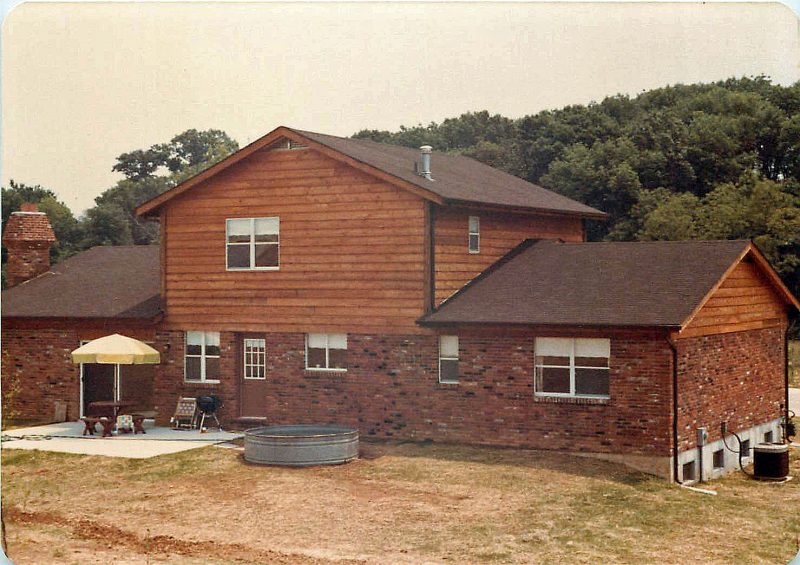
In Spring 1981, we added a pergola over the patio so we could get some shade from the hot summer sun and sit outside. A local lumberyard had an architect on staff at no cost if we bought the lumber there. He came to our house and then drew blueprint plans (no computer plans in 1981) for us to use, including every detail down to how many lag bolts and washers we’d need. I remember showing them to someone once and the guy remarked, “You even have funny papers for your patio cover?!” In the photo below, the rough-sawn cedar lumber has been delivered and we’ve started working. Ted is admiring the good job we did affixing the first triangular support bracket to the brick on the house beside the back door. That took us an entire day! We finished the other two supports on the house in much less time.
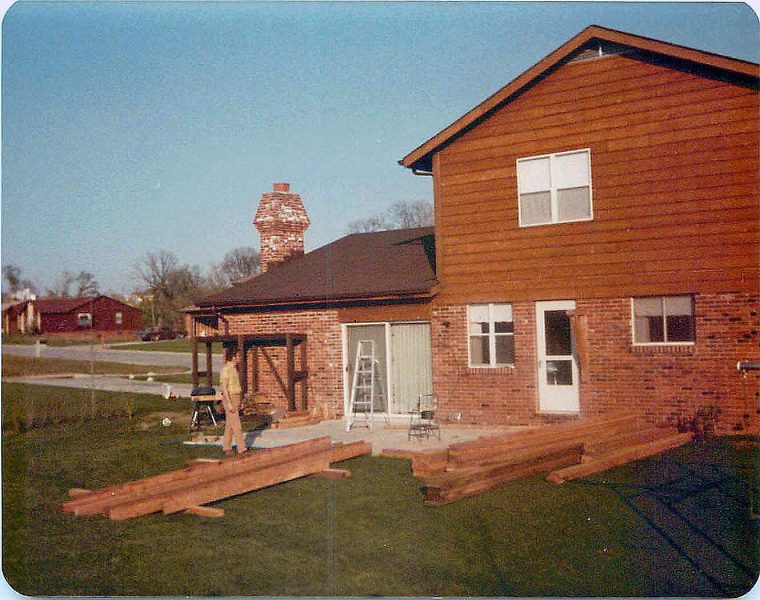
It looks like we have sufficient bracing for the uprights. Except for lifting the three 18-foot 4 x 12 solid cedar beams projecting outward from the house, we did all the work ourselves. The beams weighed over 500 pounds each and it took Ted and two neighbor men (we had a few neighbors by 1981) to raise them onto the upright posts and the support brackets on the house.
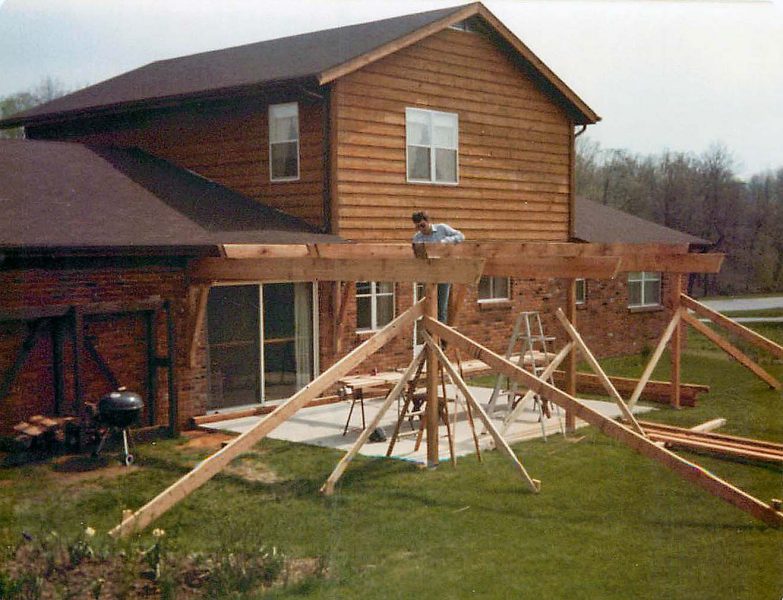
One of our new neighbors had railroad clamps that he lent us. Those are the metal poles projecting above the top of the pergola, They made it possible to clamp the crossbeams to the layer below and hold them in place while we pounded in the nails.
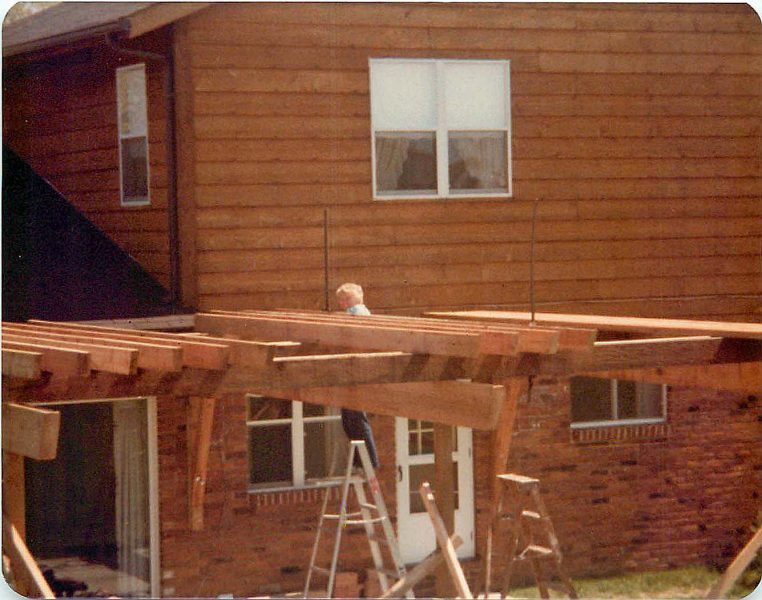
Ted gave me the honor of putting in the last lag bolt. When we finished, the entire structure was solid. The architect told us that “sandwiching” the upright 4 x 4 posts with 2 x 6 boards would keep the 4 x 4s from warping. They never warped, and the pergola never wobbled.
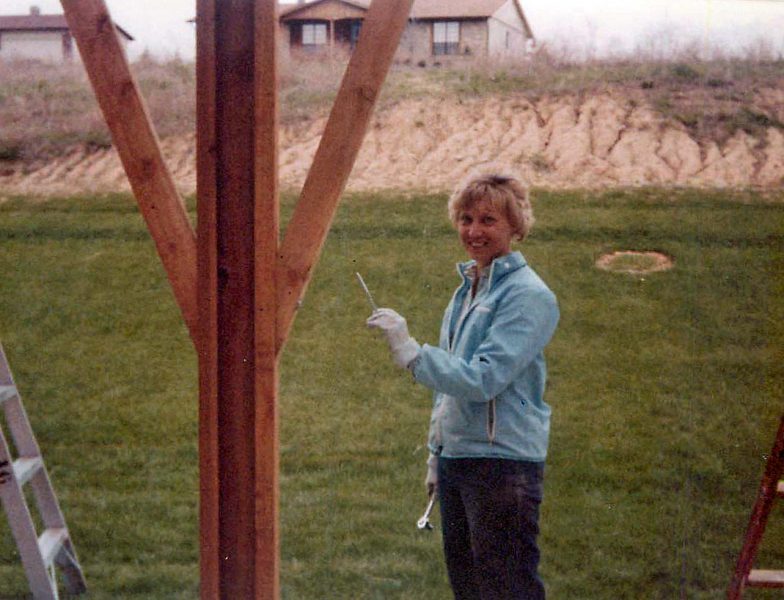
The pergola is all stained and finished, and it looks good. After 30+ years, we had to replace the original, but we used the same blueprints because we like the design that much. The second time around, however, we could afford to hire a professional carpenter. I honestly don’t think his work was any better than ours.
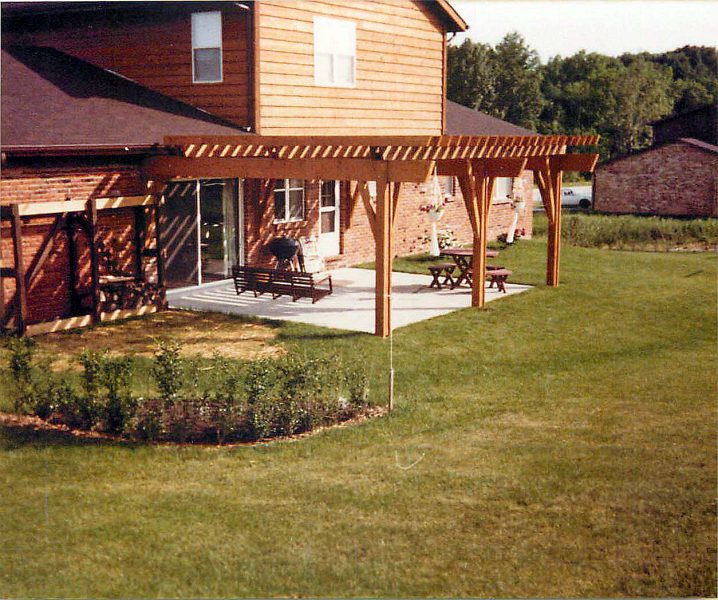
Here’s how the house looked in August 2018, thirty-nine years later. When we bought it, it was at the top end of our budget, but we both loved it and decided to go for it. We’ve never been sorry and we still love it.

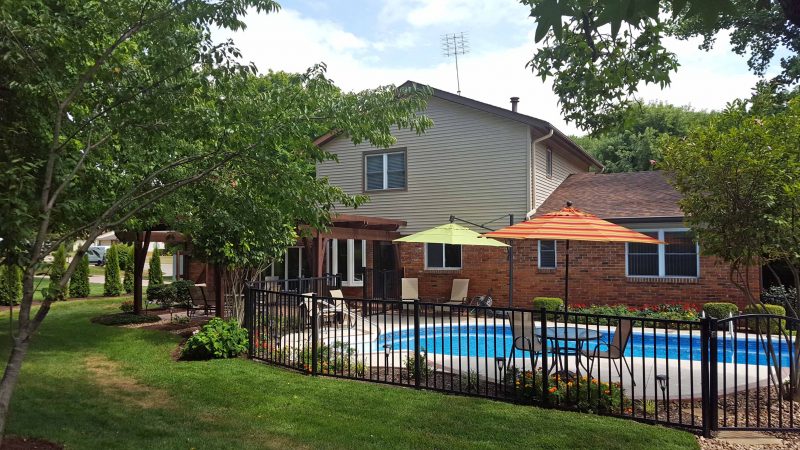
As University of Wisconsin alumni, Ted and I receive the UW magazine. We each found an especially interesting article in the current edition. My “find” is a philanthropic educational initiative. I know a number of universities have similar programs, and I’m proud that my alma mater is one of them. (FYI, Bucky Badger is the UW mascot, thus “Bucky’s Tuition Promise.”)

Ted’s favorite article is cuter and more fun.
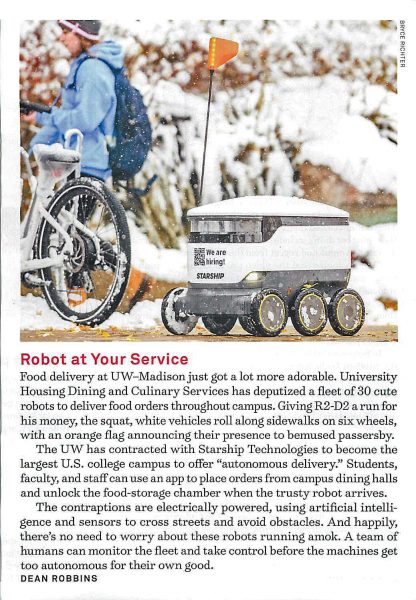
So you think working for the federal government is boring? Ted saw an article in Fedsmith.com titled “The 9 Coolest Federal Government Jobs.” The author states that there are federal employees around the world doing work that “would put the most fascinating private sector jobs to shame.” He lists the following coolest federal government positions.
Park Ranger (National Park Service) Locate your office in Yosemite National Park, the Appalachian Trail, or Independence Hall and choose from firefighting, security, search and rescue, etc.
Aerospace Engineer (NASA) Research, design, and test systems that go into spacecraft.
Foreign Service Officer (Department of State) Represent the U.S. in Nassau, the Bahamas, or other unique locales.
Archivist (Smithsonian Institute) Collect, care for, and organize historic artifacts, photographs, documents, etc.
FBI Agent (Federal Bureau of Investigation) Investigate, prevent, and put an end to illegal activity to uphold the Constitution and protect the American public.
Meteorologist (National Weather Service) Forecast weather, collect data, and work with natural disasters, climate change, and saving lives while studying the complex inner workings of Earth’s atmosphere.
Pararescue Airman (USAF) Make dramatic rescues in a variety of unique scenarios such as evacuating sinking planes or retrieving astronauts after a water landing.
Fish and Wildlife Biologist (U.S. Fish & Wildlife Service) Protect and manage native animals, especially those that are endangered or threatened.
Securities Compliance Examiner (SEC) Keep Bernie Madoffs and Enrons from undermining the U.S. financial system through interviews and investigations to prevent fraudulent activities.
Yesterday afternoon, I left the house around 4:00 p.m. to run a few errands. When I returned at 5:30, the knob on the door between the garage and the house wouldn’t turn. I knocked, thinking the door was locked, but Ted couldn’t turn the knob from the inside either. I took my bags around to the back door, then took the door knob apart to see if I could fix it. Both knobs came off, exposing the inner workings of the latch, but nothing moved and the door refused to open.
The locksmith (Kevin) who came to the house this afternoon said he rarely sees jammed latches, but this was his second one today. What are the odds? He did the same thing I had done: removed both knobs and tried to wiggle the innards. Nothing moved for him either. Luckily, he had some other tricks of the trade.
Kevin inserted flat bladders between the door and the frame, above and below the door knob. Inflating the bladders shifted the door toward the hinges, making it possible for Kevin to insert a screwdriver into the latch hole in the door frame to release the latch. I asked what he would have done if that hadn’t worked and he said, “Saw off the latch bolt. I always get them open.” I like confidence in a professional.
As he was leaving, Kevin said he was going to examine the latch because he wanted to know what jammed it so tightly. I asked him to let me know what he found, because I was curious why it worked fine at 4:00 and wouldn’t budge ninety minutes later.
In the photo below, you can see a flat gray piece of metal in the opening of the cylinder. When he took everything apart, Kevin discovered that the flat gray metal piece had broken in half. Closing the door at 4:00 p.m. yesterday apparently jiggled one of the broken pieces just enough to tip it a little inside the cylinder, preventing it from sliding back through the opening to release the latch. The unanswered question is: What broke it inside the cylinder?
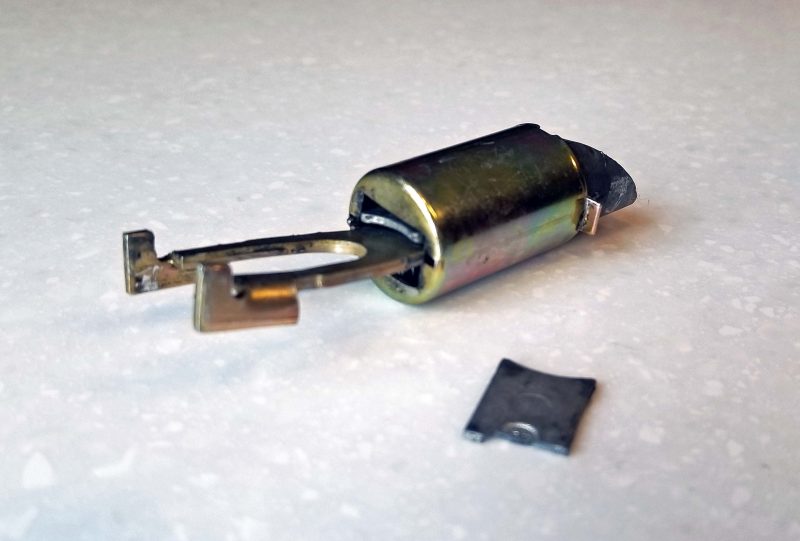
I enjoyed my e-bike so much last fall that I couldn’t wait for a warm winter day to ride it again. There’s a definite wind chill when biking. That feels good when it’s 80 degrees; less good when it’s under 50 degrees. Yesterday and today were the days to ride–upper 50s yesterday and mid-60s (high of 65) today. Whee!
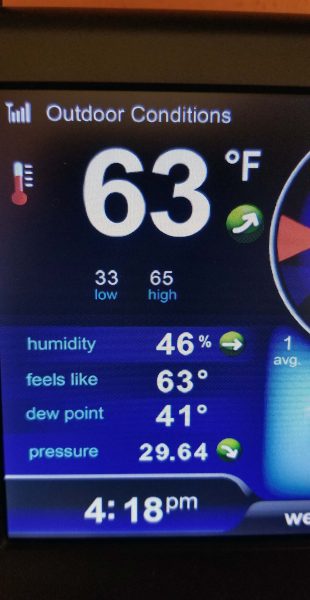
Here I go! Happiness abounds.
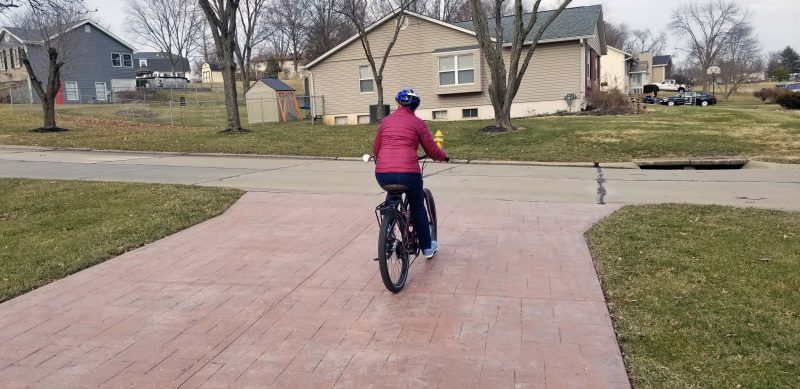
While I was riding through a subdivision, I saw an unfriendly–and kind of rude–house. Check out the sign at the front door.

Coming in for my landing after riding 17.5 miles. Maximum downhill speed today was 24.7 mph; average speed was 13.3 mph. It was a workout!
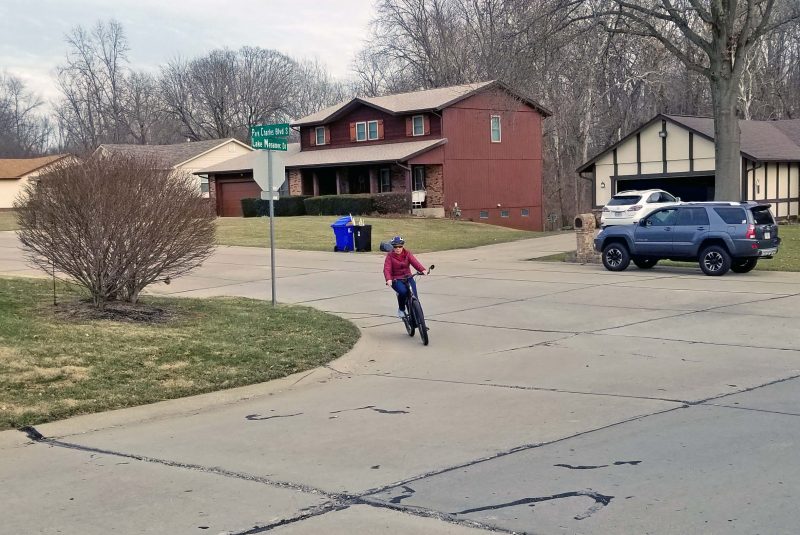
Yes, that was fun. I biked 13 miles yesterday and 17+ today for a total of 30 miles this weekend. Now it’s going to be cold again, but the 10-day forecast looks good for more biking next week. I can’t wait.
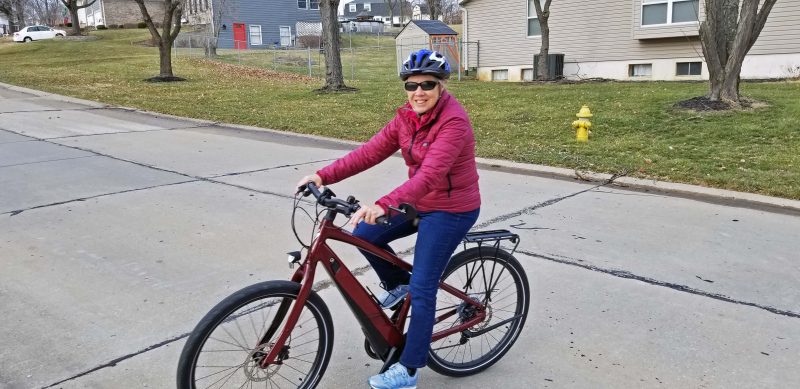
Ted is still under orders to limit his activities after his cataract surgery, so he took a walk instead of biking with me. He was waiting for me when I got home, and he took the pictures. I’m sorry he missed the biking fun, but his vision is much better now.
Recent pop-up ads on my tablet have shown “challenging” sudoku games. I like to do sudoku puzzles, so I took some screen shots and printed them just to see if the puzzles in the ads are actually solvable. Good news! They are.
A “normal” sudoku puzzle looks like this.

The rules are that each 9-square block must include the numerals 1-9. The same is true for each 9-square row and for each 9-square column. Within a 9-square block, row, or column, the numerals 1-9 cannot be repeated. The puzzles I printed from the online ads were structured a little differently, but the same rules applied.
This was one of the two puzzles. I added the colored lines to make the three puzzles obvious. It helped keep my eyes focused on the nine blocks I was solving. I quickly noticed that the center 9-square block is shared by all three puzzles, so the center puzzle must be solved first. After that, you solve the other two, but you cannot change any of the numbers entered in the center puzzle.
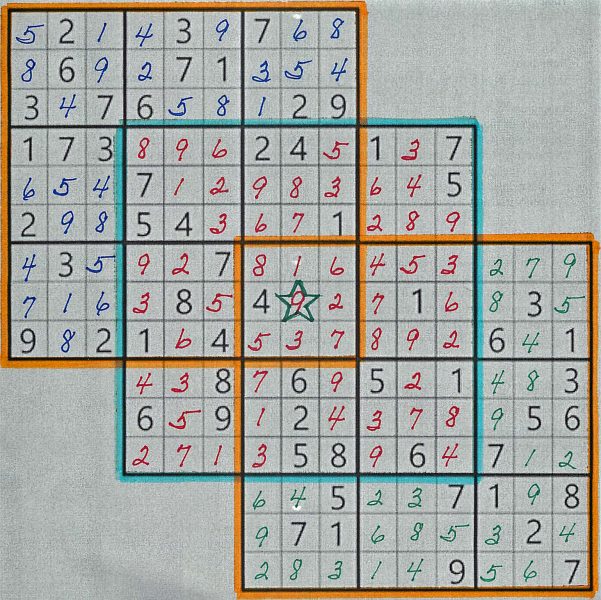
The second printout was a larger puzzle, apparently only solvable by “real sudoku master.” Again, I figured out that the center square needed to be solved first because it shares its corner squares with each of the other four puzzles. This puzzle was a more challenging level–harder than I enjoy doing–so it took me some time to solve the center puzzle. After that, the other four were pretty simple, maybe because I already had one corner of each already solved.

If the ads are to be believed, I’m a real sudoku master, since I solved both puzzles. Now, back to my real life.
Jeff and La flew to St. Louis last weekend. They were supposed to arrive by 6:00 p.m. and our plans were to go out to dinner. Unfortunately, there were weather (snow) delays in Denver, and they didn’t arrive until about 1:00 a.m. At 9:00 p.m., Ted and I heated some soup for dinner and Jeff and La had airport hamburgers.
Kathy arrived Saturday afternoon. Unfortunately, Annette had a bad cold and couldn’t join us. We spent time at our house and at Kari’s house. It’s always good to catch up with each other in person. Sunday afternoon was unexpectedly warm (upper 50s), so it was a good day to take a walk outside.
Indoors, there was time for a variety of board games and some sheephead at Kari’s house.
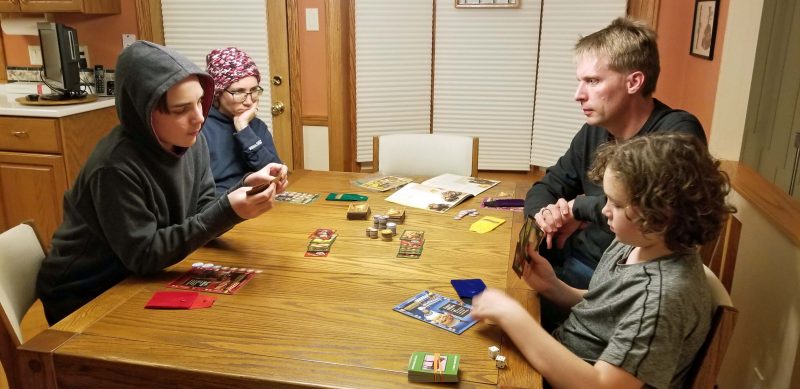
The young girl with dark hair and glasses is Sky’s girlfriend, June. She’s a brave lady to spend a day with Sky’s extended family, meeting Sky’s grandparents and an aunt and uncle.

There was time to relax, playing online games and sharing pictures of our recent trip to Indonesia, Australia, and New Zealand.
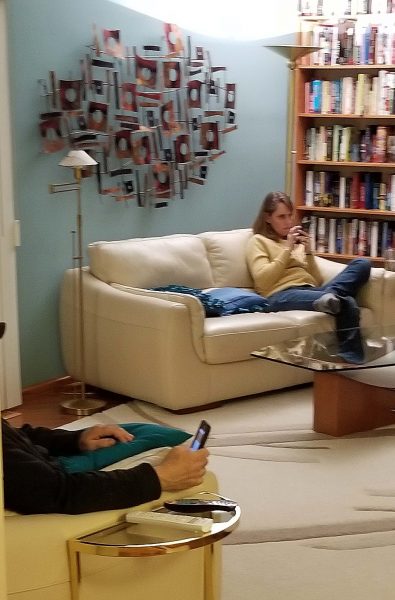
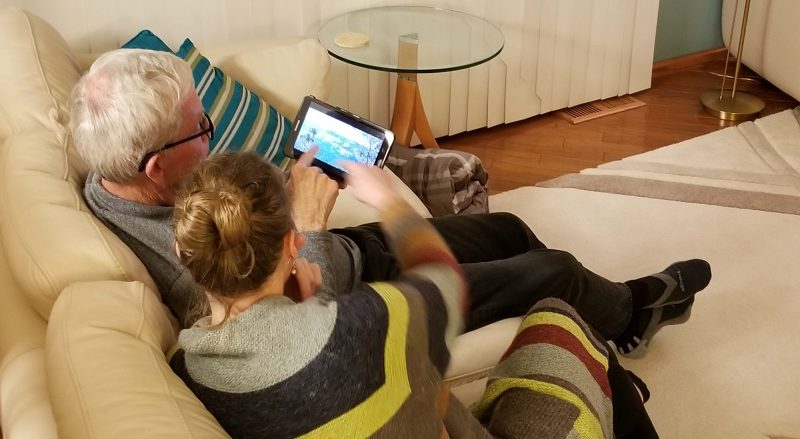
I wasn’t up to full strength yet after developing bronchitis from the brush fire smoke on our trip, so Ted and I decided to have the evening dinners catered. So easy!
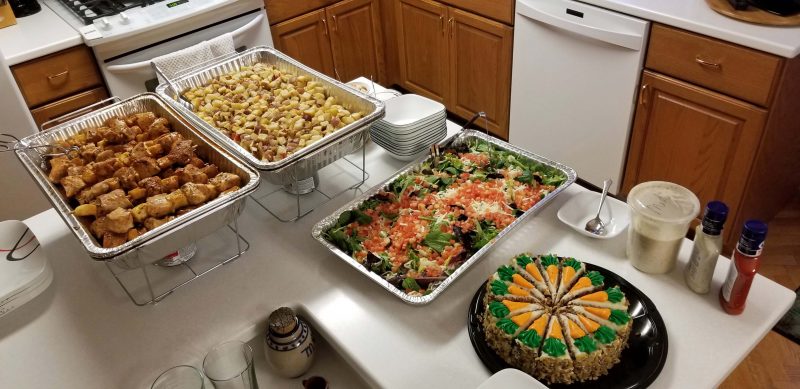
And all too soon, the visit was over. Kathy went back to Kirksville; the kids went back to school; Kari and Dean went back to work; and Jeff and La flew back to Montana. Ted and I talked about what a nice weekend it had been. We wish you could have joined us, Thom and Katie.
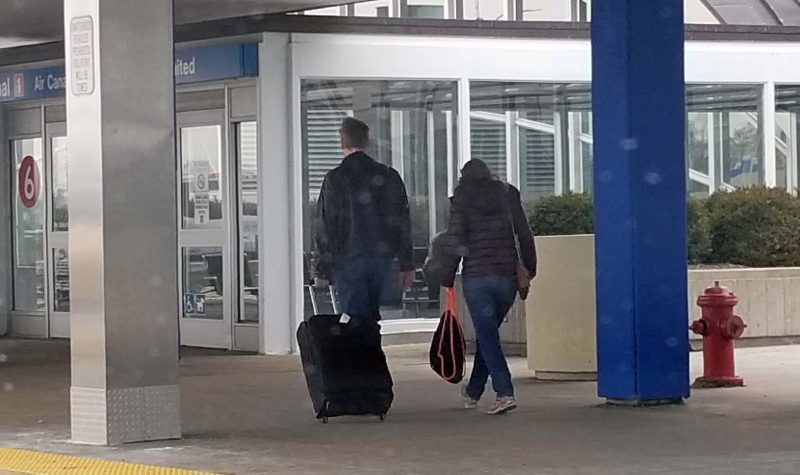
It went viral on social media. Celebrities and sports teams got into it. The broom challenge was hot. It made the news in USA Today.
The broom challenge has actually been around since 2012 and claims that at the spring and fall equinox, it is possible to make a broom stand alone.
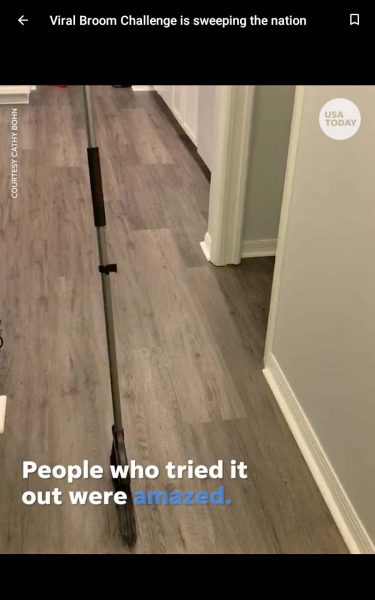
Too bad the broom challenge is based on pseudoscience and false claims. It’s a harmless social media hoax that can be done at any time of the day on any day of the year. The secret to success is the broom’s center of gravity, not the earth’s gravitational pull. Who has time to think up this stuff?
Ted and I went out to lunch last week. At the doorway to the restaurant, we saw daffodils. Yes! The hard, cruel winter is nearly over. This is coming from someone who spent half of the winter season in a warm climate. Not to mention that NOAA reported we’ve just had the warmest winter on record. Still, daffodils. Spring is my favorite season.

Ted and I usually record Jeopardy! so we can watch it at the end of the day. Fast forwarding the ads also brings the show down to about 13 minutes instead of half an hour. One day, there was a category called “Websites” and this clue came up.

Answer: What is a blog? I knew the answer (question?) immediately because wordpress.com is the blog format I use.
It was a clear and sunny day. Suddenly, a brain shock hit. I was cleaning up our vacation photos and transferring them from my laptop to my PC when I noticed a bunch of pictures I thought were cute / interesting and wanted to post on my blog. Here are the “lost” pictures I found.
Seen in Auckland. Perhaps owned by an immigrant from the Badger state?
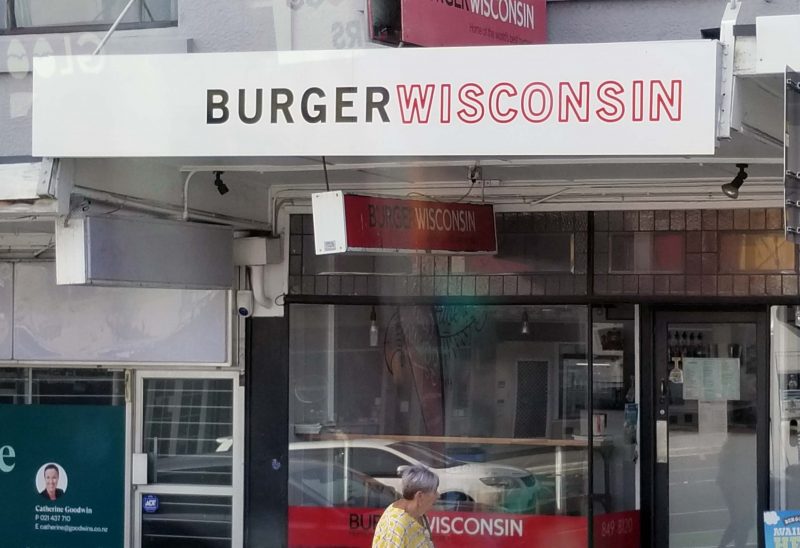
In British-founded countries, they don’t have trash; they have rubbish. In any country Ted and I have visited overseas, we’ve found public trash / rubbish cans to be rare, and we usually have to hold on to our litter until we get back to our temporary home base–wherever that is.

Window sign on a coffee / hot chocolate house. Check out Ted and me in the reflection on the window.
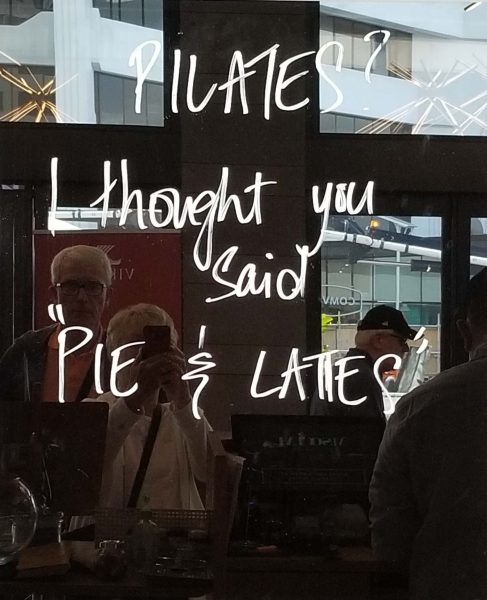
Our hotel in Auckland not only had an unusual name–M Social–it also had an unusual decorating style. This wall almost made it feel like we were being watched while we relaxed.
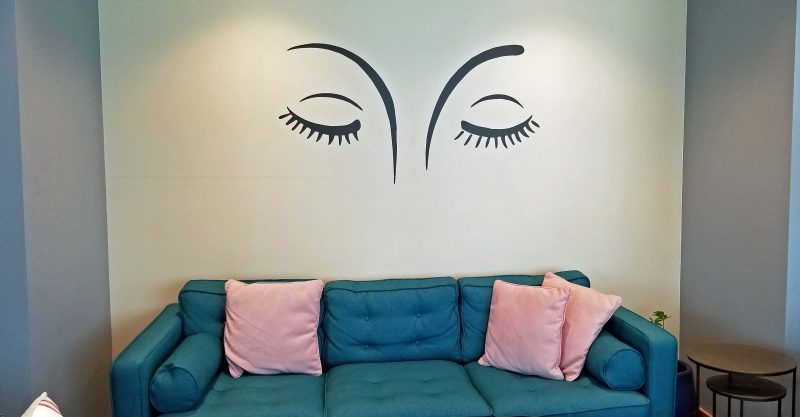
It took me a moment (or two) to figure out how to do Roman numeral math, but it works out to the same answer. Try it.
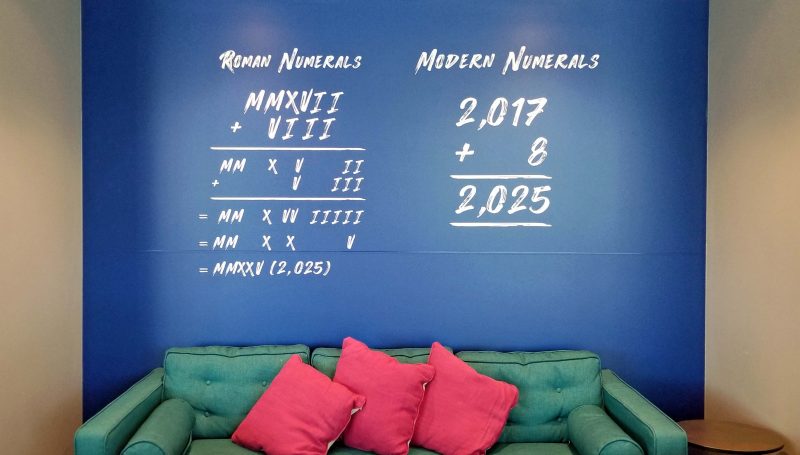
I’ll bet you’ve never seen rest room signs like these.
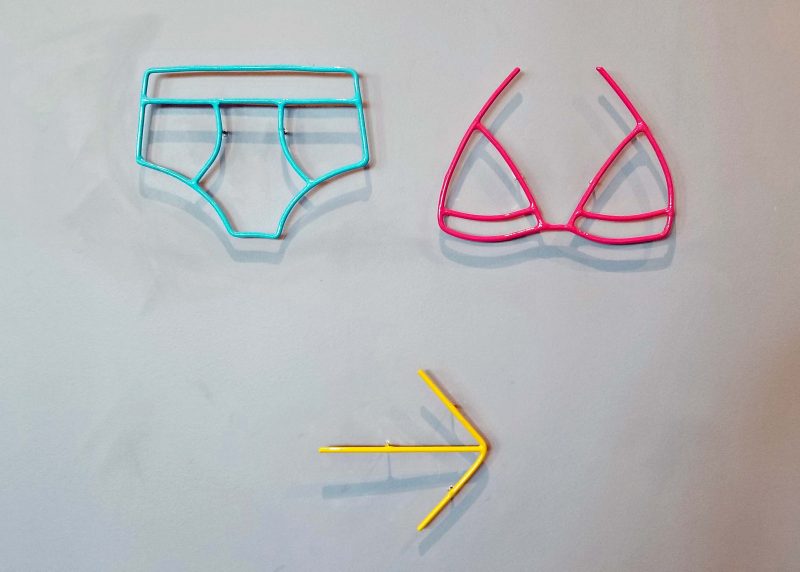
And what is this thing with peek-through bathrooms? A sliding panel was available to provide some bathroom privacy. Our Bali hotel had the same thing, but there was a glass window with blinds, not an open wall. (Below)
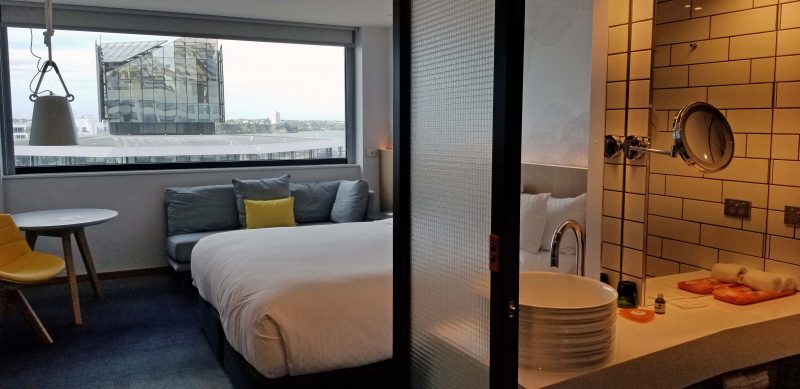
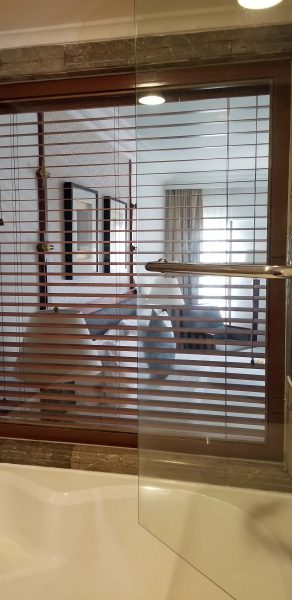
This is a foreign country thing more than a hotel thing, but at breakfast, there was a choice of full or trim milk instead of whole or skim. Also, water is always offered as “still” or “sparkling.” Hint: sparkling water tastes awful!
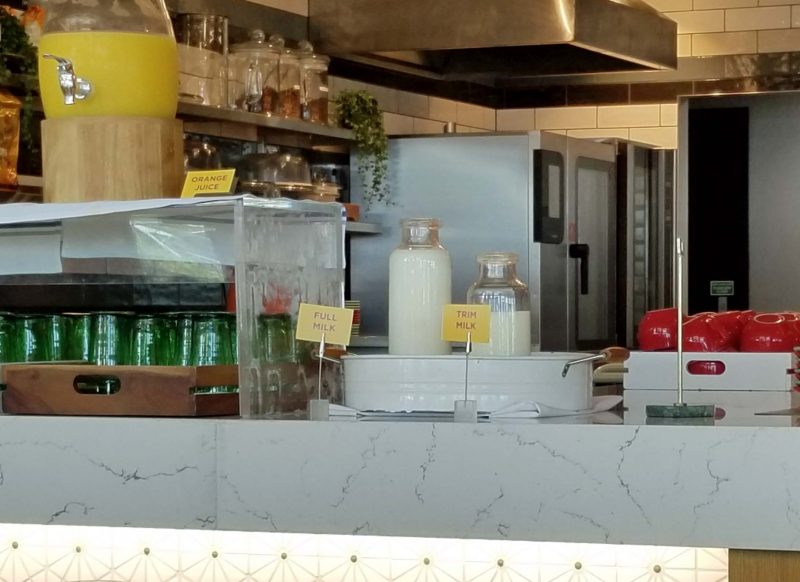
Travel definitely broadens one’s experiences and viewpoints.
On February 2, Jeff’s blog informed his readers that some of the things “everyone” knows are true might not include full disclosure. Jeff’s example was that eating carrots will improve your eyesight, a line of propaganda with a tiny grain of truth, but actually created to encourage the British population to consume more of England’s plentiful carrot crop.
There are countless other unsupported health-related truths that “everyone” knows, including: breakfast is the most important meal of the day; drink eight glasses of water a day; get eight hours of sleep per night; two thousand calories a day is normal; don’t swim for an hour after eating; you’ll lose more weight by exercising in the morning; and (today’s topic) everyone should walk 10,000 steps per day.
The 10,000-step goal is commonly used as the default for fitness trackers and smartphone apps; however, there is no scientific basis for making 10,000 steps a daily fitness goal. A Harvard professor looked into the origins of the 10,000-step standard. In a May 2019 article, she reported that this measure of fitness appears to have started as a marketing strategy for a Japanese pedometer company in the 1960s. She explained that the company’s product was named the “10,000 step meter” because the Japanese character for 10,000 looks like a person walking.

Scientific studies have shown that for sedentary people, even a modest increase in daily activity can bring significant health benefits. The U.S. Department of Health and Human Services recommends that healthy people get at least 150 minutes of moderate exercise per week (five 30-minute sessions) or 75 minutes of vigorous exercise per week (five 15-minute sessions).
The conclusion: as long as we’re active, we can just keep on keepin’ on. No guilt needed for fewer than 10,000 daily steps.
Many dates can be palindromes, but they usually have seven or fewer digits, such as 1-10-2011 or 9-10-19. Today, however, is a rare eight-digit, international palindrome date. Whether you write it month/day/year like we do in the U.S. or day/month/year as many other countries do, it is still a palindrome. The last time this happened was more than 900 years ago on 11-11-1111 and the next time it will happen will be 12-12-2121, 101 years from now. After that, we’ll have to wait 1,919 years for 03-03-3030.
Enjoy it while it lasts.
As Ted and I reflect on our trip to Indonesia, Australia, and New Zealand, highlights of the trip come to mind. We have many, but here are ten of them, in no particular order:
(1) Lazy morning coffee and hot chocolate in the Viking Winter Garden.
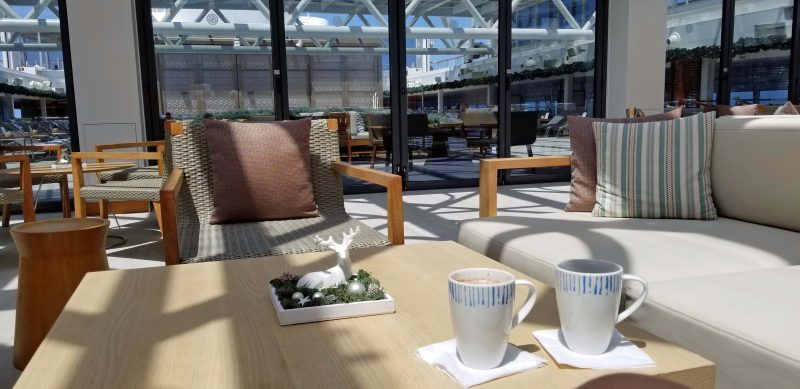
(2) Summer fruit and vegetables in December and January. (3) Komodo–our new standard for “how hot is it?” If it’s not as hot as Komodo, it’s not bad. (4) Ted’s birthday dinner.
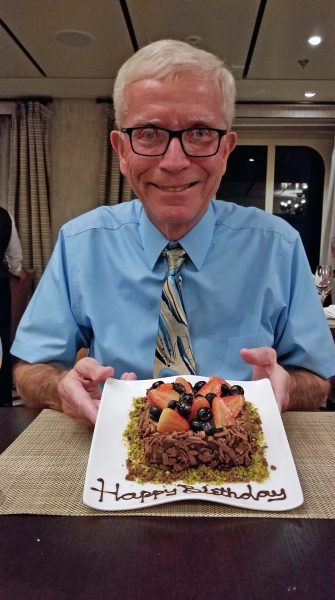
(5) Talking with local residents. (6) Petting a koala.
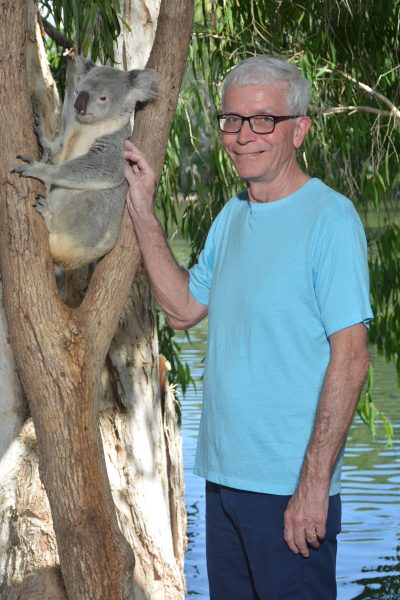
(7) Seeing the Great Barrier Reef.
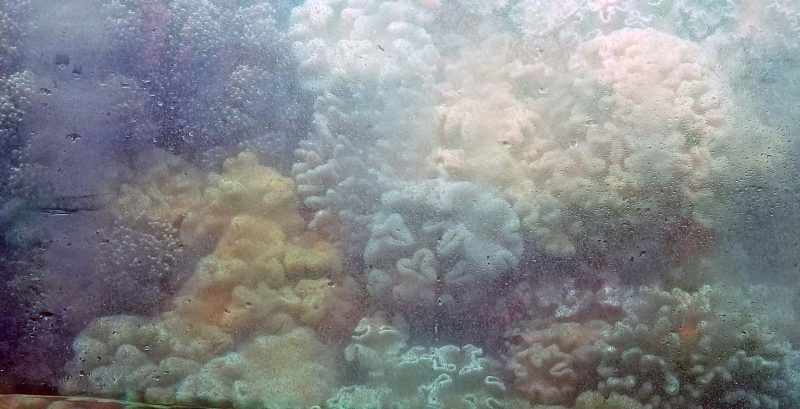
(8) The onboard Christmas Eve Service. It made us feel less lonely to be with nearly 1,000 other people who were also away from their families at this special time of year. (9) Sightseeing in a jet boat.
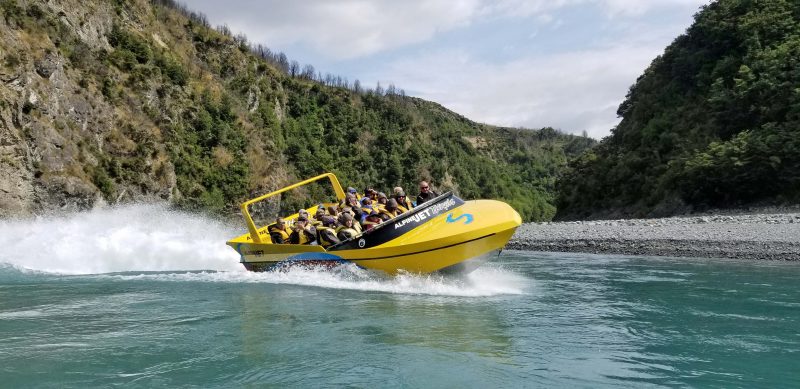
(10) Choco-fest times two. Two chances to enjoy the Viking chef’s creativity with chocolate.
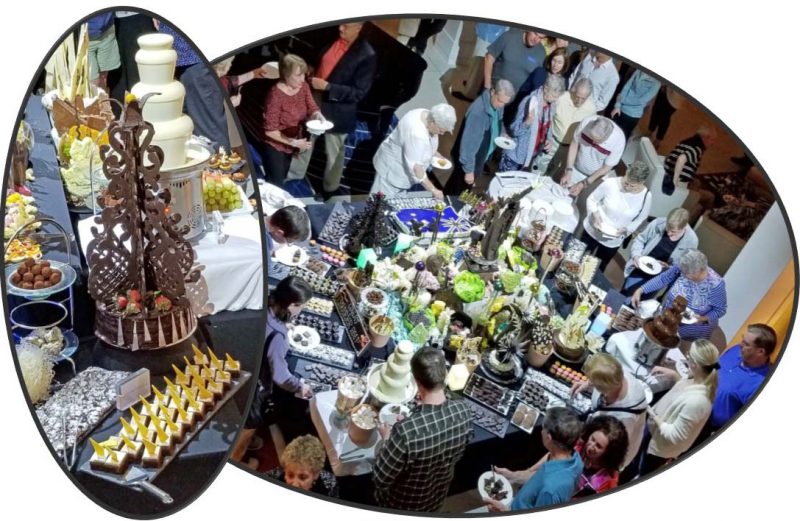
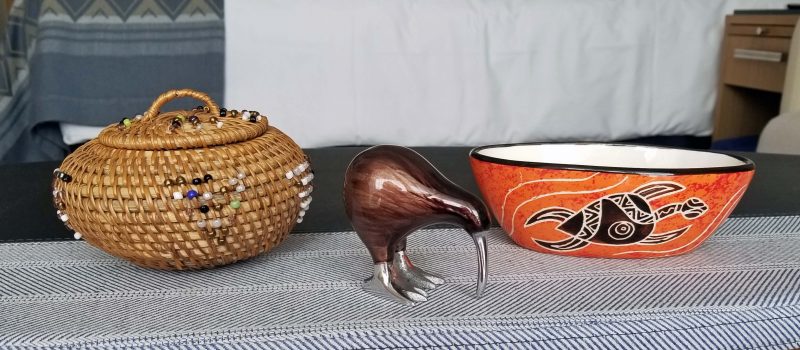
Ted and I brought home three small souvenirs from our recent trip. The little basket is handmade and was sold at a local market in Mataram, Lombok (Indonesia).
We bought the orange dish in Melbourne, Victoria. It was authentically crafted in Australia by an Aborigine tribal member.
The kiwi bird–the national icon and unofficial national emblem of New Zealand–was purchased in Rotorua, NZ. It was mass-produced, but it comes with an interesting story. Here’s the short version of the Maori legend:
Tana-mahuta, the god of the forest, was worried about his children, the trees, because the bugs were eating them. He asked various birds to give up the gift of flight to live on the ground and eat the bugs to save the trees. One bird refused because he was afraid of the darkness in the forest; another didn’t like the dampness; and every other bird had an excuse. Only the kiwi bird said, “Great! I have a fear of heights and I hate to fly anyway, so I’ll be glad to live on the ground.” Because the kiwi sacrificed its beautiful wings and feathers to live on the forest floor, Tana-mahuta made it the most well-known and best-loved bird in all of New Zealand. New Zealanders have been called “kiwis” since Australian soldiers bestowed the name on them in World War I.
All automobiles are imported to Australia. There are no auto manufacturers or assemblers in the country.
New Zealand was the first country to introduce the forty-hour work week, but due to the high cost of living in New Zealand, many people need more than one job to meet their expenses, in spite of the fact that the minimum wage is considered to be sufficient to make tipping unnecessary.
We saw no huge McMansions in either Australia or New Zealand. Expensive homes have two stories instead of one and are more like a middle-size U.S. home with a very small lot.
Sign on a chocolate shop: You can’t buy happiness, but you can buy chocolate.
In Australia, snowbirds are called “gray nomads” and go north to Darwin for the winter.
Only fish and flightless birds are native to New Zealand. All other animals have been imported. As a result, there are no predators, and animal overpopulation of some imported species has caused problems.
I started with a checklist of six things I wanted to see and/or experience on our trip. Bonuses not included on that list were: ghost gums, wallabies, koalas, kangaroos, and hearing people say “No worries.”
On our way to Australia, Ted and I ordered a pizza for lunch at LAX. We were carded to get a beer with the pizza. When I asked the server “Really??!!” he said “Yes.” So we look like we might be under 21? Lucky us at our age!
Mark is beyond a doubt the best driver we’ve ever shared a car with. Maybe it’s because he is a retired policeman, but he handled a car more smoothly and safely than anyone in Ted’s and my experience.
Want to convert Celsius to Fahrenheit? Multiply by 2, then add 30. Fahrenheit to Celsius is the opposite: subtract 30, then divide by 2. The answer will be within 0-2 degrees.
Passengers were introduced to the Viking management staff at a short program in the ship’s theater. Each guest was given a glass of champagne, and each crew member also had a glass of champagne. When he introduced himself, the captain raised his glass, then set it aside with the comment, “Designated driver. Again.” The beverage manager closed by saying “Stay hydrated.” The chef claimed responsibility “for the one pound per day you will gain on this cruise,” and the doctor said, “I’d love to meet each of you socially.”
It’s been an amazing six weeks since we left home. I loved the summer weather and we’ve seen and learned so many beautiful and interesting things. Ted and I agree we’d like to re-visit this part of the world.
At the same time, we’ve been breathing smoky air from the bush fires in Australia since we got to Newcastle on December 26. The winds are blowing to the southeast, so smoke and particulates were in the air all the way around Australia from Newcastle to Sydney, Melbourne, and Tasmania, and also during our time in New Zealand. As a result, Ted and I are both coughing and want to get back to clean air. I’ll bet the doctors in this part of the world are doing a booming business from smoke-related illnesses. Like the Australians, we hope rain will come soon, and we wish the firefighters well as they continue to make progress in controlling the fires.
Tracey did an amazing job of selecting train times and getting all the information we needed to find our way to the airport. Mark and Tracey drove us to the train station to see us off. Tracey had already decided which would be the best car to sit in and where to sit in the car, so Mark helped with our luggage (he’s so nice) and got us into our seats. We got off at the right station in Sydney, found the connecting gate to the airport, and arrived at the airport with plenty of time to spare. Thank you, Tracey and Mark.
As we were walking around the airport (exercising before our 16-hour flight to Dallas), we saw these kids. I asked their parents if I could take a picture of them. They are so cute, and they reinforce my point that kids are the same all around the world.
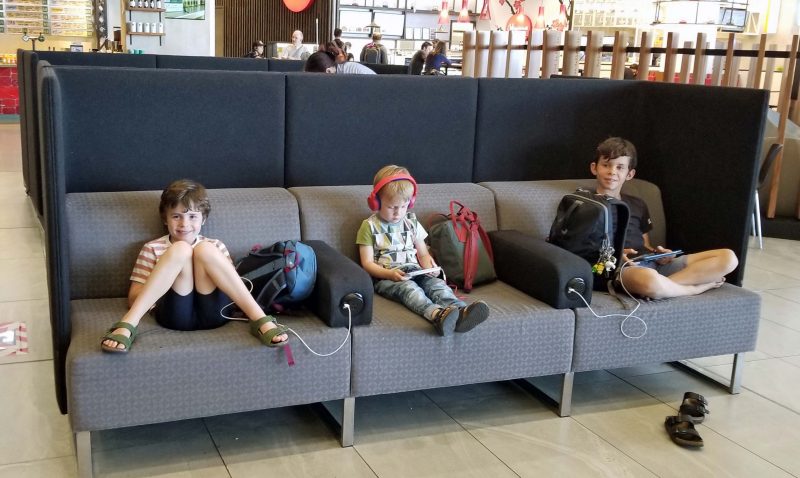
Several years ago, Ted and I decided to fly business class on long flights, and it’s worth every penny. Today’s flight put us on an Airbus 380–the first time we’ve flown on the really big plane with two levels of seating. We’re happy campers (or fliers). The panel beside my shoulder can be raised to the seat top for privacy, if desired.
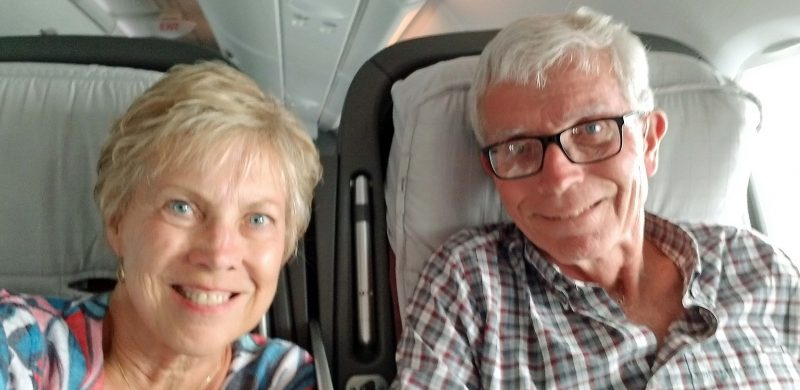
Naturally, we were among the first to board and we were directed to the upper level where there are only six (large) seats across; the main cabin has ten.
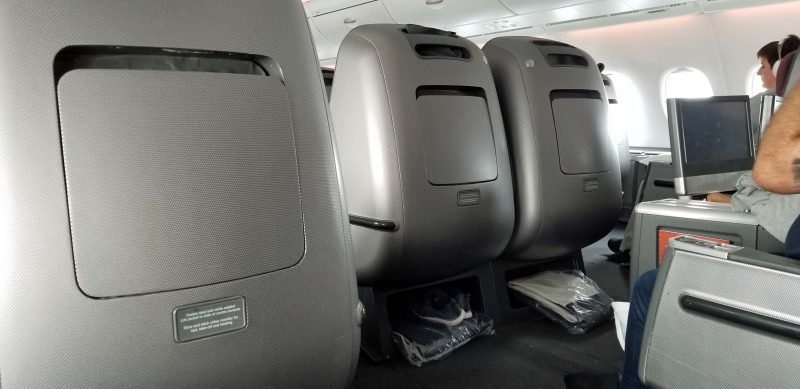
Ted had three windows to look outside (one more is beside him) instead of one-and-a-half like the main cabin.
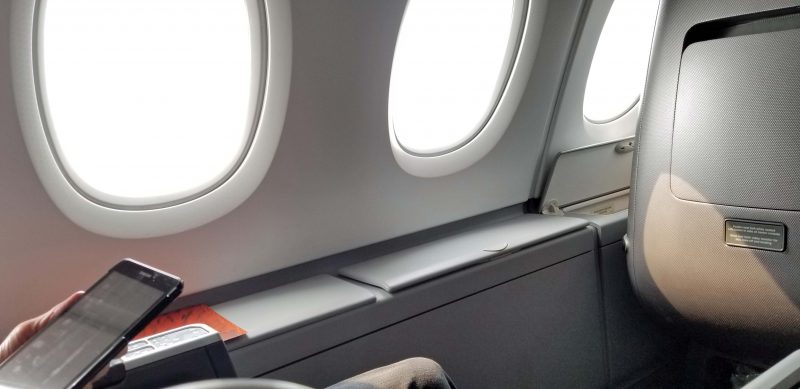
There’s plenty of legroom.
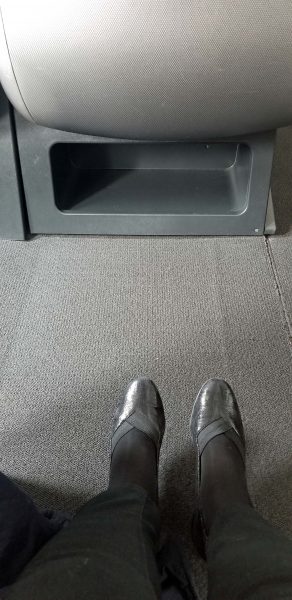
While the main cabin was boarding, we made our menu selections for our upcoming meals and snacks, put the mattress pads on our seats (it makes them a little softer), put our footrests up, accepted a glass of wine and a bowl of nuts to snack on, and got comfortable. I picked out a movie and started watching it. Yes, that’s a nearly twin-size quilted blanket over my legs (white and charcoal to match the decor) to keep me warm on the chilly plane.
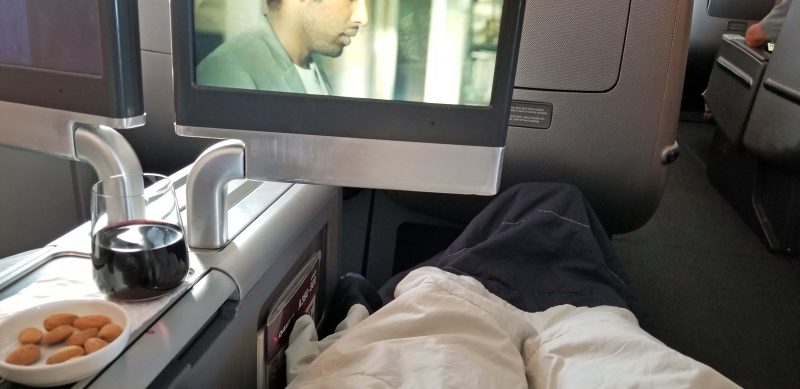
The business class food is delicious! This is the first course. I selected steak for the main course, and then dessert–all pre-ordered as the main cabin boarded, then served on china dishes, not in cardboard boxes. The tomato soup was amazing. I wish I knew which spices they added to it. We had choices for snacks–fruit, ice cream bars, cheese plates, chocolates, etc.–instead of the dry cookie or mini-pretzels served in the main cabin. In fact, we were invited to go to the galley and choose whatever we wanted, whenever we wanted something.
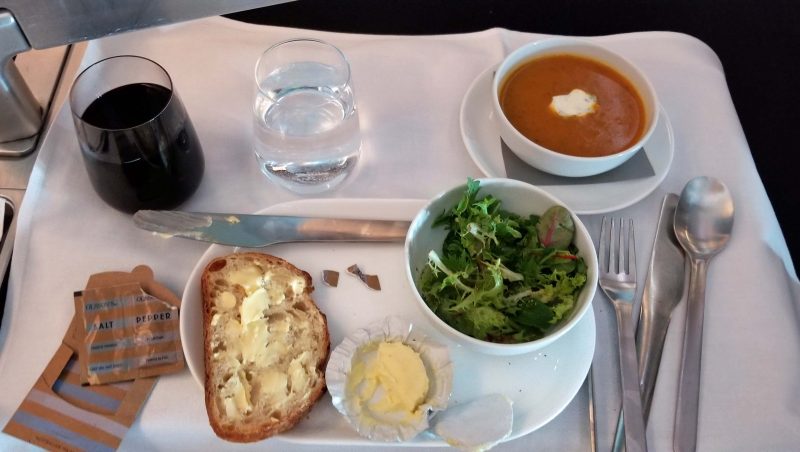
Business class also includes a pair of warm socks and pajamas for overnight flights. This was a Qantas flight, and they have the nicest pj’s we’ve seen–knit fabric with sweatpants-like bottoms and a pull-over top in S-M-L sizes instead of one gigantic size. I think everyone in our cabin put them on within the first 2-3 hours, and they were very comfortable. During most of the flight, when people moved around, it looked like we were all at a big pajama party in matching pj’s.
When we got home–35 hours after leaving Mark and Tracey’s house–it was only two hours later than when we left Sydney on the same day. There were 50 messages on the phone and a warning that the recording space was filled. One message was a reminder about an upcoming appointment; two were from the St. Charles School District (where Ted volunteers) announcing school closings for snow; and 47 were hang-ups. Who knows how many more robo calls we’d have had if there had been more recording space?!
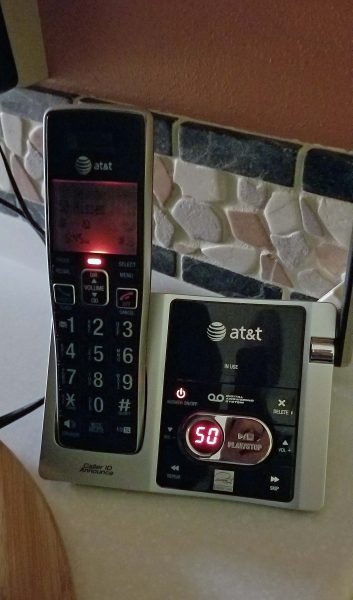
In the kitchen, we found love gifts from Kari: a gallon of milk, a box of cereal, a loaf of bread, and fruit (apples, bananas, and blueberries). Best of all, thank-you notes from her family (we love reading those) and some Christmas candy she’d made because she knew I didn’t. We must have done a lot more right than wrong when we were raising our kids, because they are all adults we are proud of and thankful for in so many ways.

Thom’s family’s Christmas gifts were in the accumulated mail we picked up. The Lego exchange between Thom and me continues. I had to build this right away.
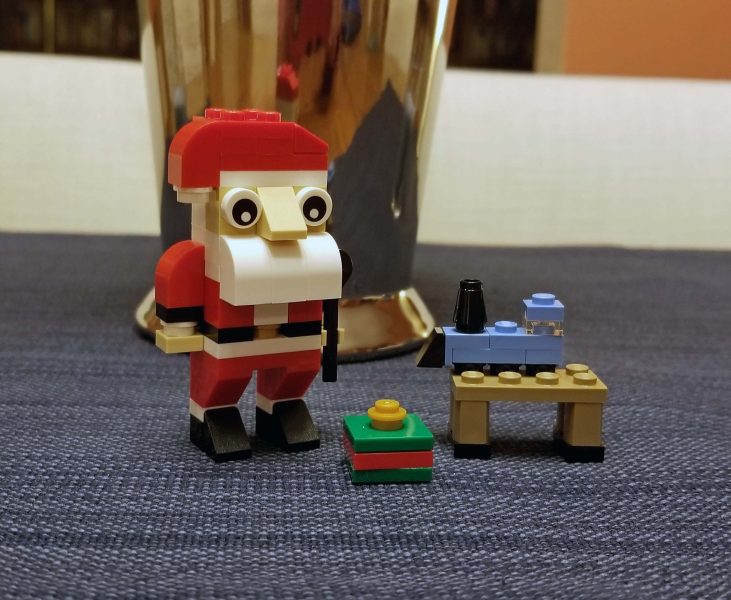
It was a great trip and we’d do it again, but we look forward to being with our family again next Christmas. Now, good-night. I think we’re going to sleep for a week.
Author’s note: We used seven airports for this trip, and DFW wins the prize hands down for grumpiest employees and most inefficient baggage retrieval. Either everyone at DFW was having a bad day or they all work for terrible bosses and hate their jobs. Ted and I always look forward to coming home from overseas and hearing “Welcome home” from the customs officer, but that didn’t happen this time. The DFW customs officer was barely civil to the people passing through. They need to attend a workshop in Australia or New Zealand to see what friendly looks like.
Today, Tracey and Mark took us sightseeing in their area. We drove to some pretty beaches and ended the morning at Nelson Head Reserve, the highest point (175 feet elevation) at Port Stephens. Because there is such a good view of the surrounding water, this point was chosen for the original (now “heritage”) Port Stephens lighthouse.
In my picture below, taken at the top of Nelson Head, you can see a peninsula jutting into the water. Tracey and Mark live on the facing side of the peninsula very close to its tip. That’s what we walked across last night for dinner. The water beyond and in the port area is the Karua River; the village below is Port Stephens, New South Wales.
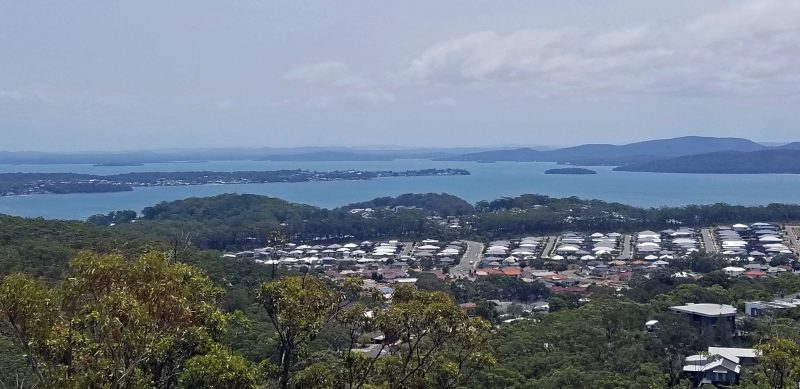
Moving to the right from the above photo, the space between the two large rocky hills (ancient volcanoes?–I forgot to ask Mark) is the entrance from Port Stephens to the Pacific Ocean.
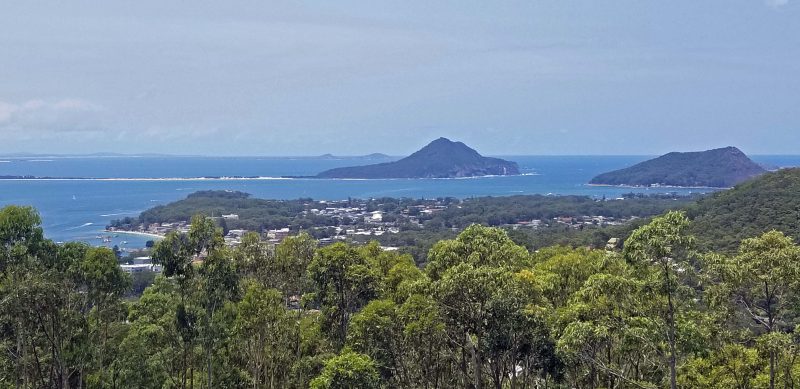
After our morning driving tour, we bought lunch at another bakery (aka café) and brought it to Lighthouse Beach (near Port Stephens). We sat at a picnic table overlooking the beach.
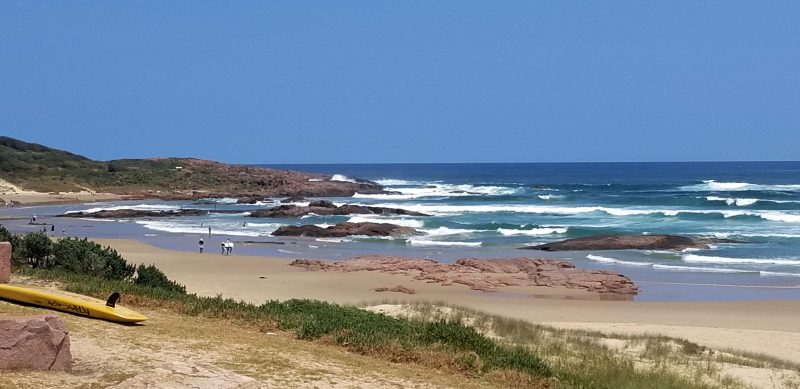
It’s another hot day and it’s still summer break from school, so there were a lot of people swimming at the beach. Even though I was sitting in the warm sunlight and watching all those school-age kids swim, I couldn’t wrap my head around “summer in January.” My inner logic says this should be July because January is a cold month.
There were some surfers at the beach as well, but the biggest attraction (available in a number of places in the area) is camel rides. It was fun to watch people mounting the camels and then follow their course around the area.

From the mounting area at the parking lot, the camels slowly (and I do mean slowly) ambled behind some sand dunes, then emerged and headed for the beach. They walked in the shallow water a little way and then turned and made the return trip to the mounting area. It was probably a 30-45 minute ride for those who purchased tickets.

We worked our way back around Port Stephens to Soldiers’ Point (where Mark and Tracey live) and stopped at a post office to purchase train tickets for Ted’s and my trip to the Sydney airport tomorrow. The airport is about a 3.5-hour drive from Soldiers’ Point; the train tickets cost us $20 each, That’s much better than Mark and Tracey driving seven hours round-trip to take us to the airport.
Our final stop of the afternoon was at Mark and Tracey’s bowling club, about two blocks from their home. Both of them participate in lawn bowling leagues, and that’s one of the reasons they selected this place to live when they moved here from Newcastle two years ago. Tracey is pretty good, but Mark is nearly professional grade. He regularly wins high-level championships.
Lawn bowls take about twice the width and at least twice the length of bowling alley lanes, so a number of games can be in progress simultaneously on this field. Under the tented roof, it was surprisingly cool and comfortable, given how high the temperature was (upper 80s?). Mark started by placing a small yellow ball on the far end of the field. He then showed Ted how to roll the red balls.
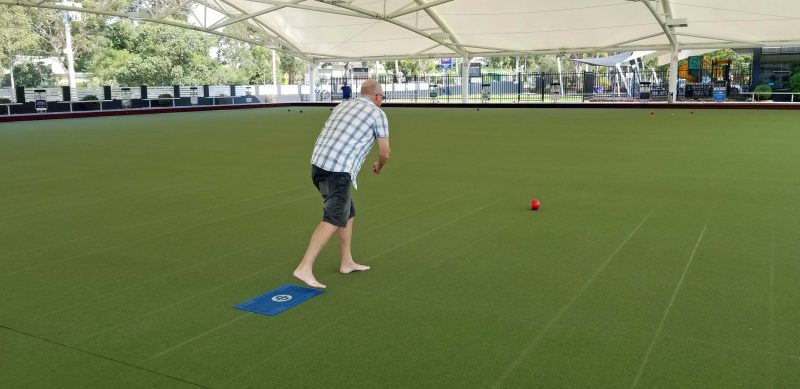
Ted did a good job for his first time, but it was obvious that he’s more used to lane bowling. Mark (after years of playing) could drop the ball smoothly on the grass; Ted had to fight the urge to give it a good thrust so it would make it across the field. With just a gentle toss, the balls rolled surprisingly far. They also curved easily, which Mark used to his advantage and which made some of Ted’s attempts go where he never intended them to go.
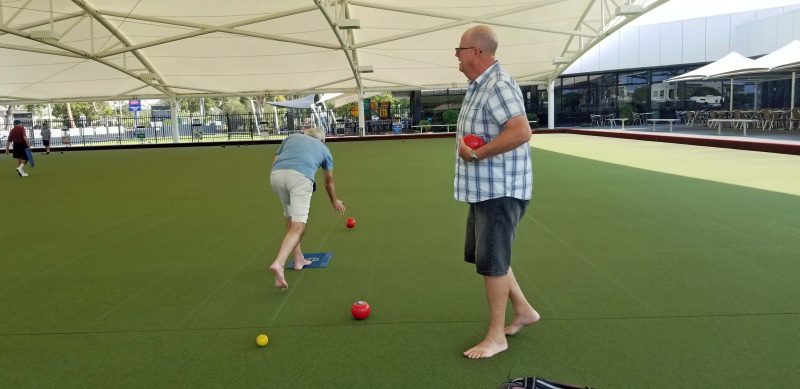
The goal of the game was to have the red ball stop as closely as possible to the yellow ball. Ted threw the ball in the foreground, then Mark threw the ball that landed on the white line. Good job, Ted. It’s your first try, and you came really close to the champ’s throw.
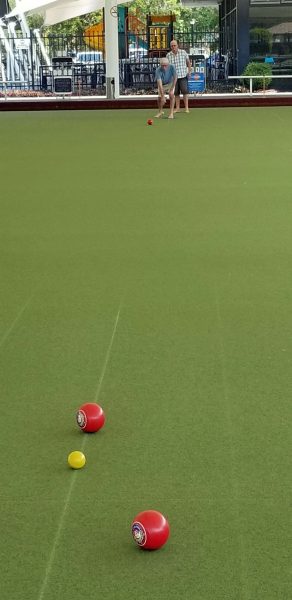
After bowling, we went back to Mark and Tracey’s home to visit with them and to give Mark a chance to start dinner. (He’s the cook in the family.) He made a pork roast with cracklings. He roasted the meat in a convection oven after rubbing seasoning into the fat on the top side. The oven made the fat brown and crisp. Mark cut it off and broke it into pieces that tasted like thick bacon. I’ve never had cracklings before, but I might have to try to make them sometime.
While the pork roasted, we went to a neighbor’s apartment and enjoyed appetizers with two other couples who were friends of Mark and Tracey. We all had a very enjoyable and relaxing time. One of the things we discussed was Mark and Tracey’s upcoming trip to the U.S. with these two couples. In June, they are flying to Alaska for a cruise that ends in Vancouver. From there, they are going to San Francisco, Los Angeles, and Las Vegas, where they will have four days on their own. We’re going to see if it’s possible for Ted and me to join them in Las Vegas, and I’m going to contact Cheryl and Dave to see if they can come too. It would be so much fun for the six of us to reunite as a group this summer!
We enjoyed our last evening together, but it was bittersweet to end our time with our friends. Here’s hoping we can see them again in June.
Author’s note: From the time we arrived in Sydney, Mark, Tracey, and their friends all called me “Di”–a nickname I’ve never used. When I mentioned that, they said the Australians shorten everything, so I paid attention, and it’s true. Tracey was “Trace” to Mark and their friends, and they all called it “San Fran” when discussing their upcoming trip. Lots of other words were similarly shortened. Tracey explained it as “same, same, different.” We all use English, but we have different names for many of the same things. It was fun exchanging some of the differences. Examples: road train = tractor-trailer truck; car park = parking lot; jam = jelly/jam; jelly = jell-o; lollies = candy; queue = line; petrol = gas; windscreen = windshield; thongs = flip-flops (never underwear). See? “Same, same, different.”
On our 2015 Grand European Cruise, Ted and I became good friends with five couples, and we all still keep in touch with each other. In the 2015 photo below, Ted and I are at the far end on the right side of the table. Since that cruise, we’ve exchanged visits (St. Louis and Las Cruces, NM) with Cheryl and Dave. Cheryl is in the center on the right; Dave is across from her in the baseball cap. Cheryl and Dave have visited Tracey and Mark (in the foreground on the right) in Sydney, and today, Ted and I met Tracey and Mark in Sydney. The other two couples are from Tennessee and California.
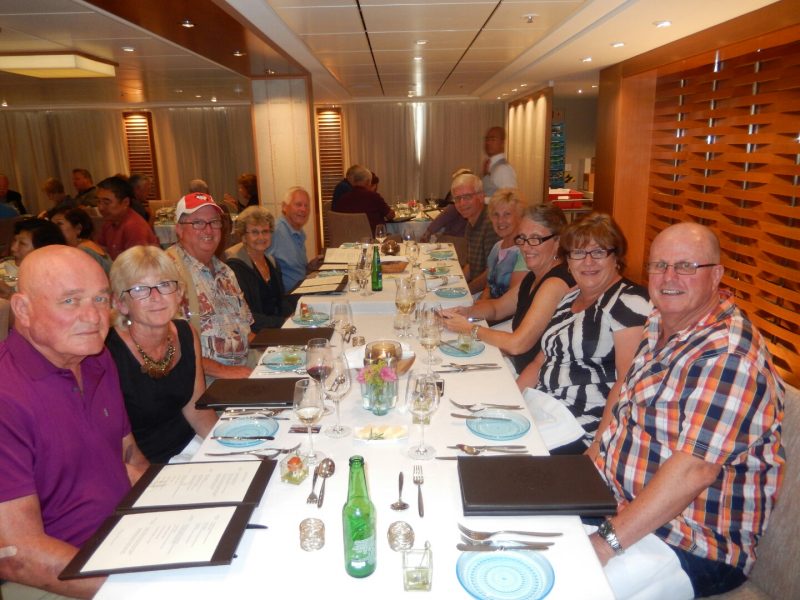
Our flight from Auckland arrived in Sydney around 6:00 p.m. We weren’t sure where to go to meet Mark and Tracey and didn’t see signs for “Passenger Pick-up,” so we asked two airport workers who were walking down the corridor near us. They were so-o-o friendly. (Author’s comment: Australians and New Zealanders are, beyond a doubt, the most friendly people we’ve met anywhere overseas. Not that the others are unfriendly, but the Down Under folks go all out. Even the customs officials laugh and joke with the people whose passports they’re examining.)
The two men thought we’d most likely need to go to a nearby doorway but, to be sure, they offered to call Tracey to find out where she was. Australians speak English, but they have their own accent and idioms, and they speak very quickly, so I often have to catch the main words and fill in the blanks. Especially for a phone conversation, it was better to have one Aussie speak to another. The man and Tracey had a brief conversation, determined where all of us were, and sent us to the door at which Mark and Tracey arrived simultaneously. Awesome!
Tracey and Mark live almost three hours north of Sydney, so Tracey made a hotel reservation for a two-bedroom / kitchen / living room / balcony suite for all of us in Sydney tonight. The plan was to spend the evening and tomorrow in Sydney, then go to their home in Soldiers Point for the next two days before Ted and I go back to Sydney to fly home. The hotel was right on the Sydney harbor, so the first thing we did was take a selfie of the four of us with the Harbour Bridge in the background.
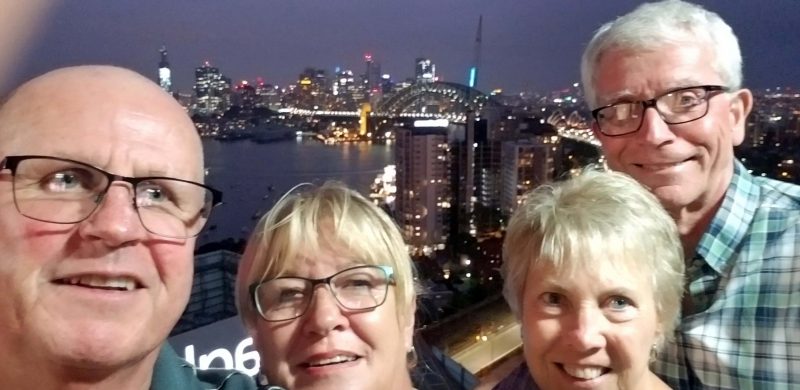
After that, we had to take a picture of our 26th-story view of the harbor. You can see the Harbour Bridge in the center and the Sydney Opera House to the left of the bridge.
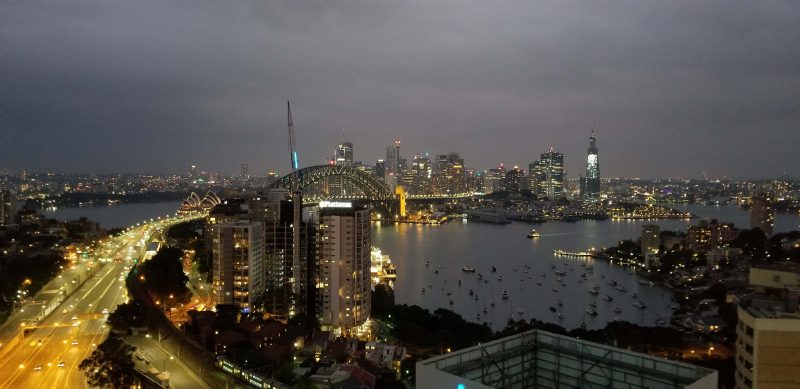
Ted and I ate on the flight, but Tracey brought some fruit, crackers, etc. for snacks, so we snacked a little bit, then took a cab to The Rocks–so named for the sandstone rocks along the Sydney shore. The area has been developed into an entertainment district. It was Sunday night, so there wasn’t much action, but it was a lovely night to take a walk. And there was a great view of the Sydney Opera House at night.
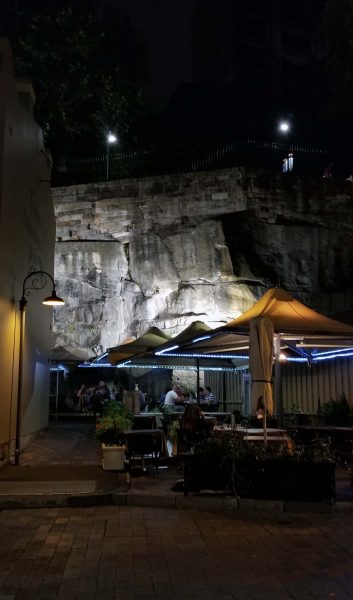
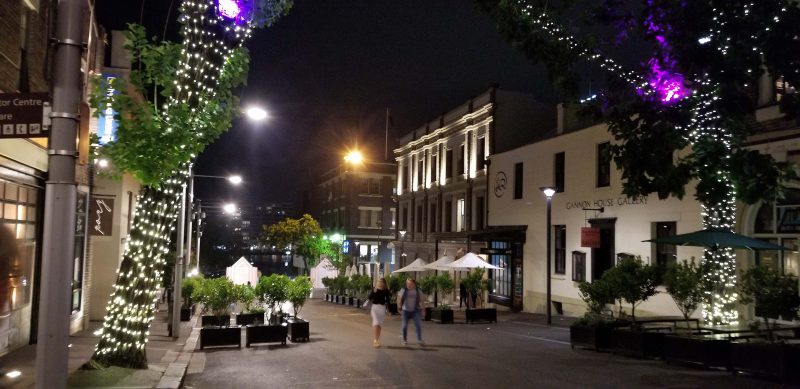
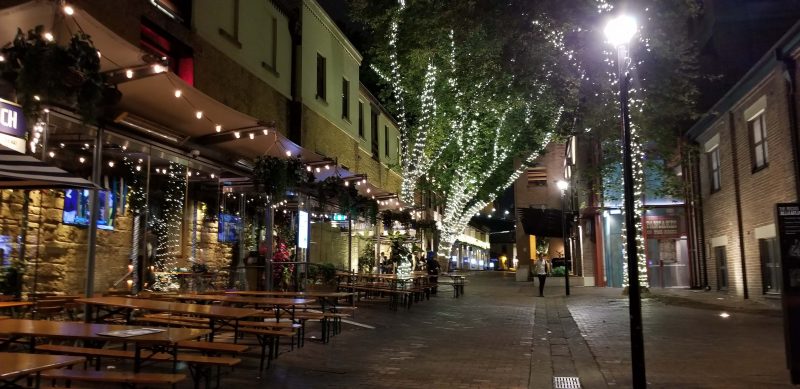
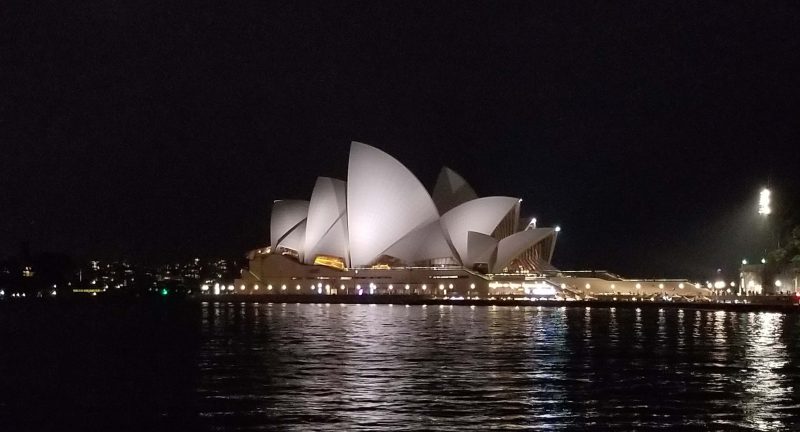
The next morning, Tracey and Mark performed just as Cheryl and Dave promised us–as an outstanding host and hostess. We started by visiting several wharves on some of Sydney’s quays (that’s pronounced keys in Australia). Each one had a variety of museums, restaurants, and entertainment venues. This one is the King Street Wharf.
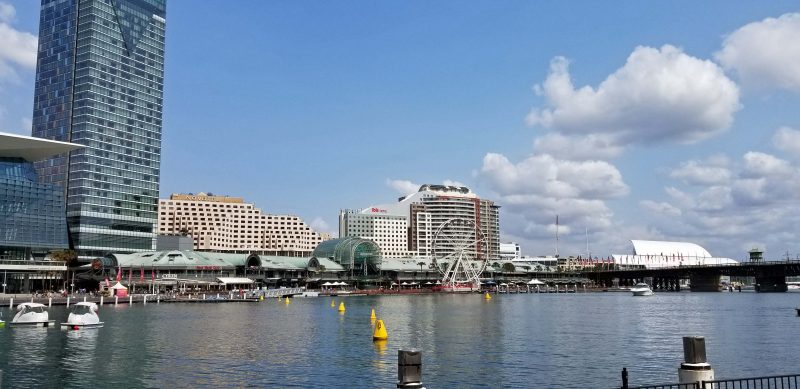
A highlight for Ted and me was Bondi (pronounced bon’-dye) Beach. It’s a famous and fabulous beach in Sydney. It was a warm day and it’s summer break from school for the kids, so the beach was crowded.
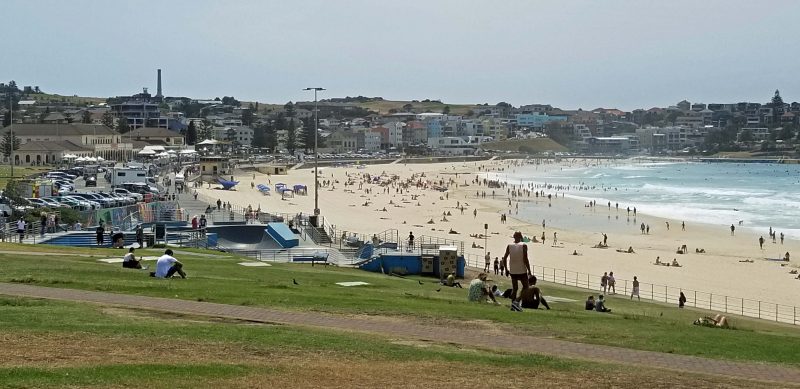
It’s also a scenic beach . . .

. . . and it’s good for surfing.
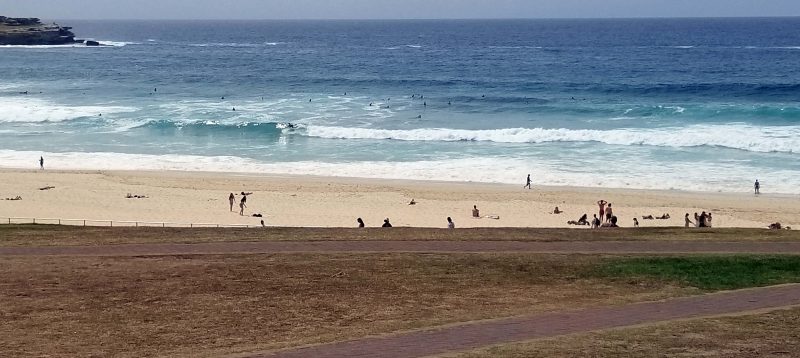
We had lunch at a bakery. In Australia, bakeries are more like cafés than a place to buy breads and sweet rolls. Ted and I tried beef pepper pasties. I liked it better than Ted because I like pepper more than he does. It was an adventure for me, however. I had trouble figuring out how to open the ketchup packet. There was no little tab on the corner, but there was a raised hump in the top center. I bent the package backward to pop the hump open–and promptly squirted my shirt, my face, and my hair with ketchup! After a good laugh, Tracey told me you need to open them with the hump on the bottom, then squeeze the bubbles to release the ketchup. Lesson learned, although I didn’t encounter any more ketchup packets during our visit.

Mark and Tracey spent the past week caravaning (“camping with trailers” in the U.S.) with three of their four daughters and sons-in-law and eight of their eleven grandchildren about an hour-and-a-half north of Sydney. The kids were staying for another week, so we stopped to visit with them on our way to Soldiers Point after lunch. (Their fourth daughter’s family lives in the Blue Mountains, about three hours west of Sydney and wasn’t with the group this time.)
Tracey told everyone they needed to talk more slowly so their American friends could understand everyone. They were very hospitable and told the kids (all under 10 years old) that this was a great opportunity to ask us questions about America, so the kids did. Do we have license plates on our cars in America? Does it get cold? Where is St. Louis? After about an hour, one of the daughters said, “I-i-i’ve. Ne-e-ever. Ta-a-alked. Thi-i-is. Slo-o-owly. I-i-in. My-y-y. L-i-i-ife.” and we all laughed–but Ted and I understood every word that everyone said. How gracious and thoughtful of them!
When we arrived at Mark and Tracey’s house, they informed us that they’d invited three couples to join us for dinner at a local restaurant. Soldiers Point is located at the tip of a spit of land that juts into the Karua River. The spit is very narrow, so although Tracey and Mark live on the east side of the little peninsula and the restaurant was on the west side, it was less than a 10-minute walk. We thoroughly enjoyed meeting their friends and we had a delicious dinner and a lovely evening together.
Tracey’s food was so pretty, she wanted a picture of it.
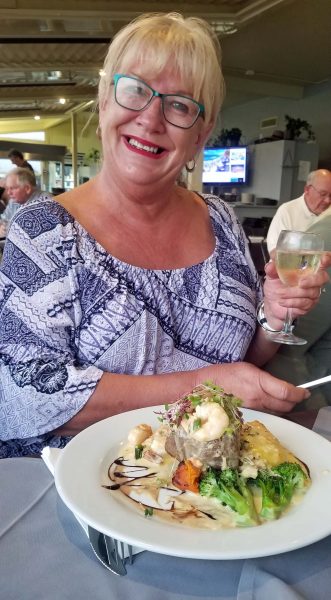
The group eats here regularly, so they generously insisted that Ted and I take the open-air window seats at the table.
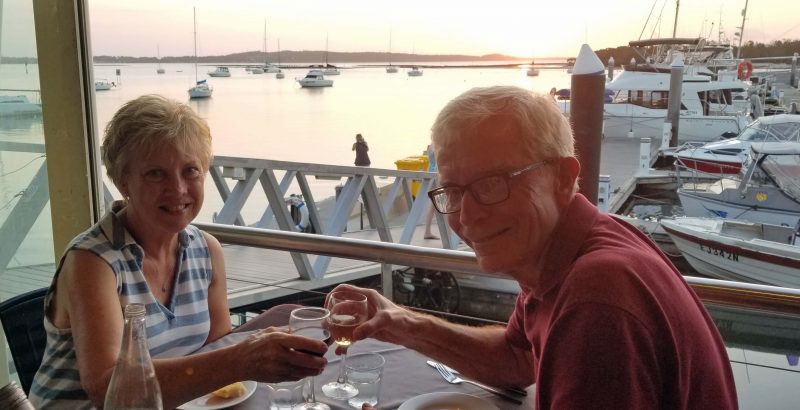
There were lots of pelicans in the water.

We watched the sun set while we ate.
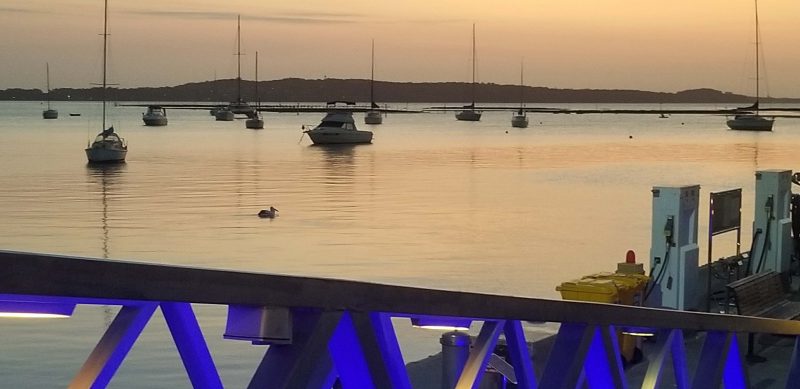
The setting became even more romantic when the lights came on.
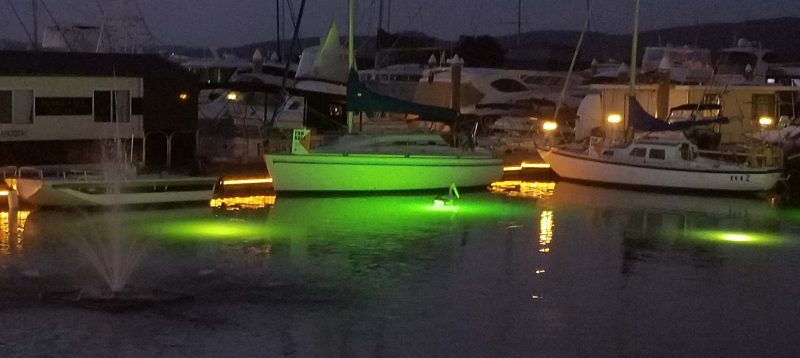
When we got back to Mark and Tracey’s home, I mentioned that I’d like to see the Southern Cross. We went up to the rooftop patio and Mark pointed it out to me. It’s not as bright as the Big Dipper, but it’s easy to find. Check! And that’s #6 of 6 on my checklist.
Today, Ted and I had a six-hour tour of Auckland and the nearby countryside. Mostly, the drive through the city looked very similar to driving through any American city.
Author’s note: Europe is very different from the U.S.–very old (dating back to medieval times), very crowded, and still using what are probably the original cobblestone streets. Australia and New Zealand are “new” to Westerners (1600s), and there’s lots of space, so we saw many SUVs and superhighways, skyscrapers, and not a single castle or ancient cathedral.
Cornwall Park, however, was unusual. There were lots of joggers, bicyclists, and walkers (Auckland must have a very fit population), but the unusual part was that the park includes a working farm–a condition of the land acquisition. As a result, there are many beautiful park vistas, and also grazing cattle and sheep.

New Zealand has a huge dairy industry. Its biggest customer is China, with a very high demand for NZ powdered milk.
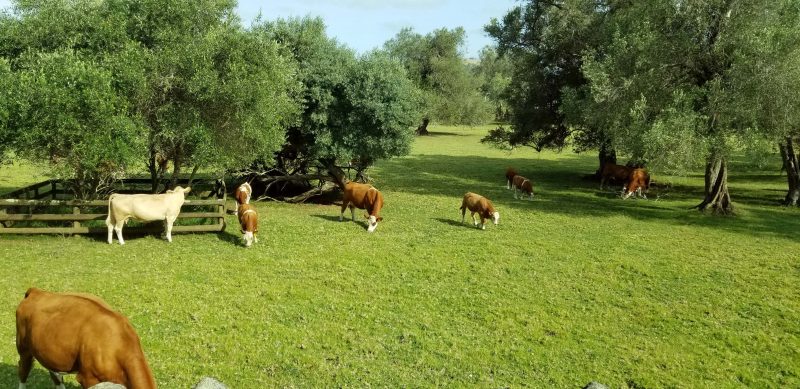
NZ’s merino sheep are famous for their wool. Merino wool feels very soft and silky, and I would have loved to buy a merino wool sweater for myself. Unfortunately, even though it’s very fine/thin, merino wool is also very warm, and I knew I wouldn’t wear the sweater except on the one or two extremely cold days we get in St. Louis each winter. Darn!
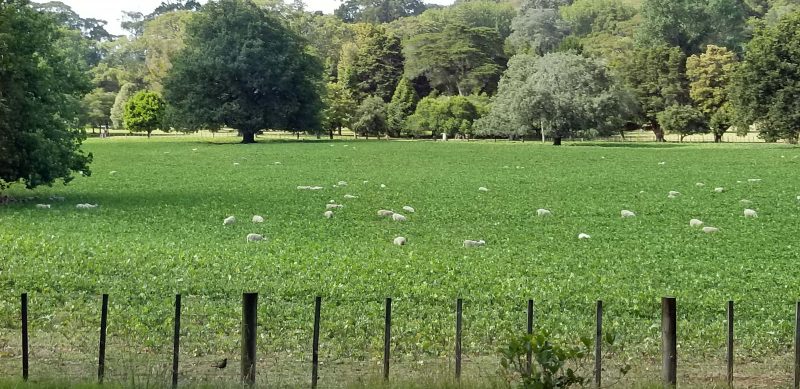
After the morning city tour, we had lunch at the Soljan’s Estate Winery, just outside of Auckland. The food was delicious, of course, and so was the wine. We’ve eaten at a number of wineries on our overseas trips and it’s making me think that Ted and I should go to lunch more often at some of the Missouri wineries in the Augusta wine district, only about 20 minutes from our house.
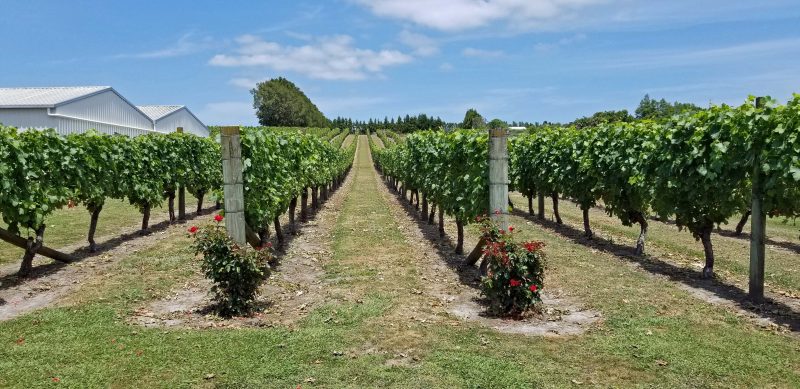
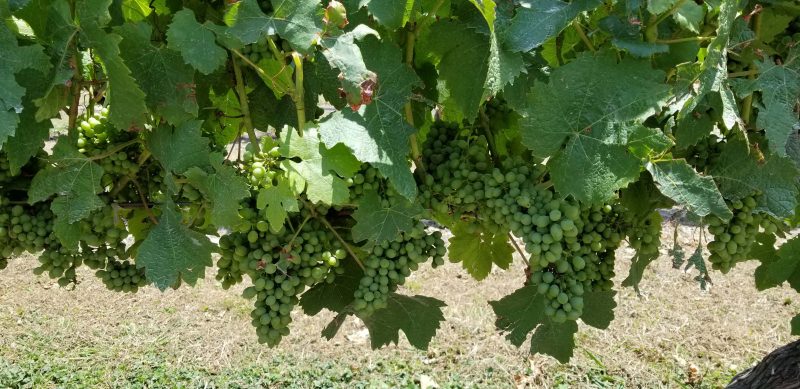
After lunch, we went to Waitakere Ranges Regional Park, a nature preserve which provides a protected habitat for the kauri tree.
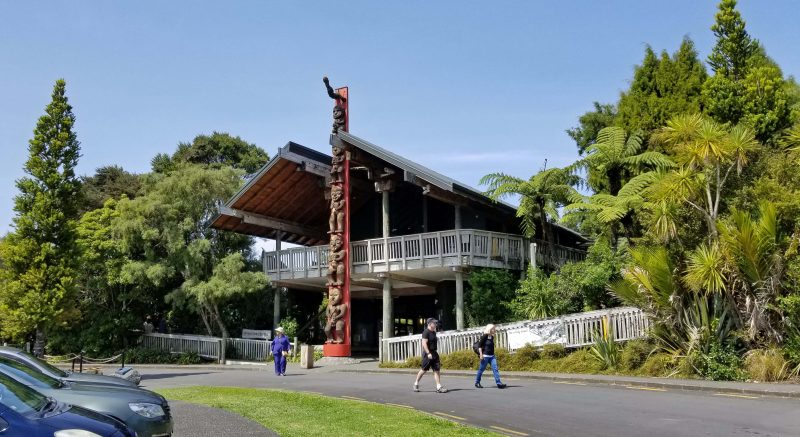
The kauri tree is unique because it produces very hard wood that doesn’t rot, making it ideal for building boats and buildings. It also grows very straight and tall–even the branches grow straight out from the trunk–and it is knot-less, so there is little waste when it is cut for lumber. Kauri trees are slow-growing and live for 600-1,000 years, so it takes time to replace them. The kauri tree used to be abundant in New Zealand, but it was cut to the point of near extinction (fewer than 19,000 acres of kauri trees remain) and is now protected by law.
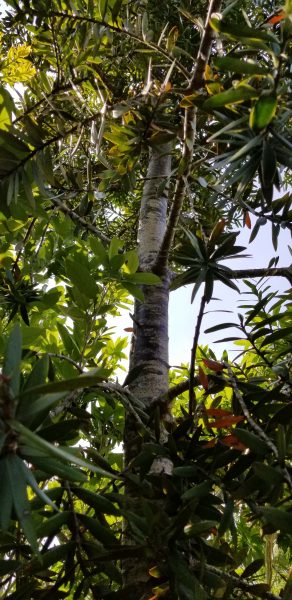
There were several nature trails in the park, so Ted and I chose one and took a lovely walk in the woods. Before embarking on the trail, we were required to clean the soles of our shoes on stiff rolling brushes, then spray them with a disinfectant to avoid bringing contaminants into the forest. When we returned, we had to clean our shoes again before re-joining our group.
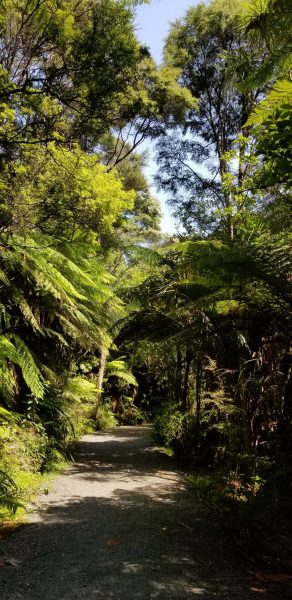
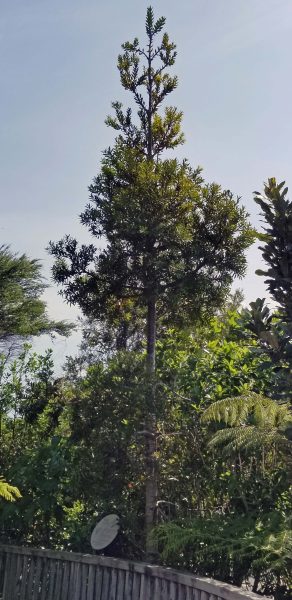
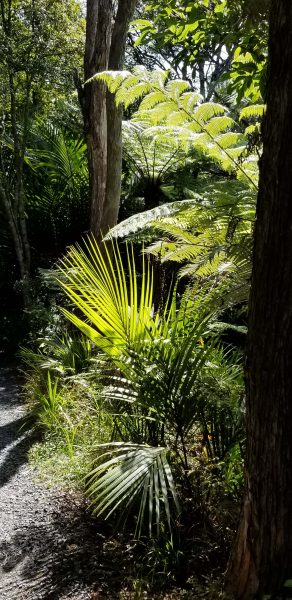
The park is set atop a high hill, with beautiful views from some of the trails and from the visitors’ center. If you need guidance, take your picture here.

Yes, it is a good place to take a picture. This is the view from inside the frame in the photo above.
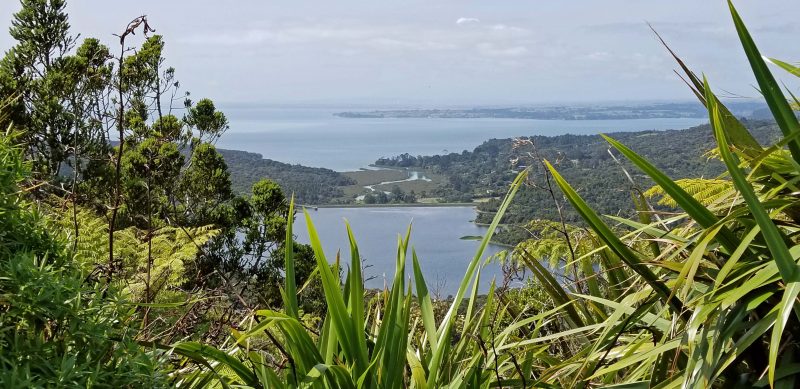
The final leg of our excursion today took us to Auckland’s north shore, and then to Devonport Village, a quaint little town with lots of little shops. Neither Ted nor I wanted to spend our time shopping, so we sat on a park bench and talked with a young New Zealand man for an hour, which was far more interesting. His mother is currently visiting friends and family in Chicago and Toronto. It’s definitely a small world, isn’t it?
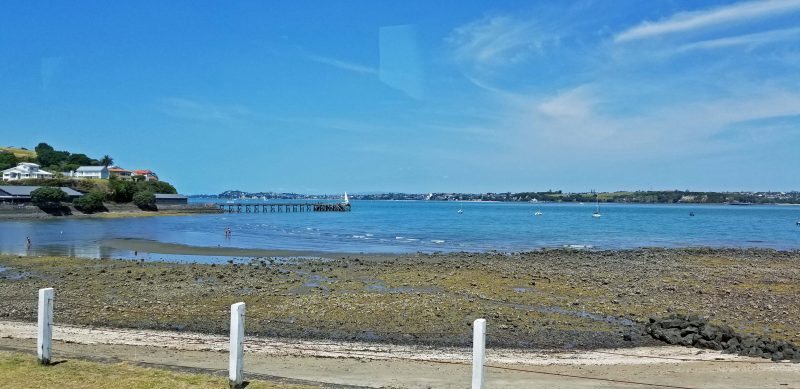
After leaving our ship and checking into our hotel, we spent today in Auckland on our own, walking around the city center. The weather was beautiful and the exercise felt good. This part of New Zealand has lots of dead volcanoes–there are 80 in the city of Auckland itself–so it’s a hilly place to walk. Here’s a view of Auckland’s skyline from across the harbor.
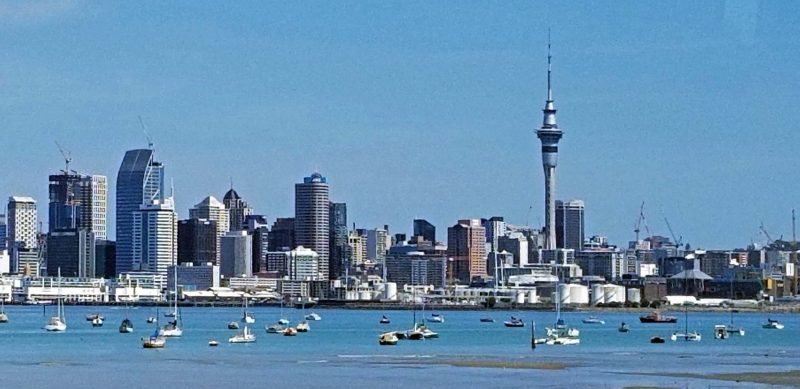
One of the first things we noticed downtown was the Farmers department store Christmas decorations. I don’t think I’ve ever seen a bigger Santa or bigger reindeer. Of course, it’s Auckland, so there are palm trees along the sidewalk.
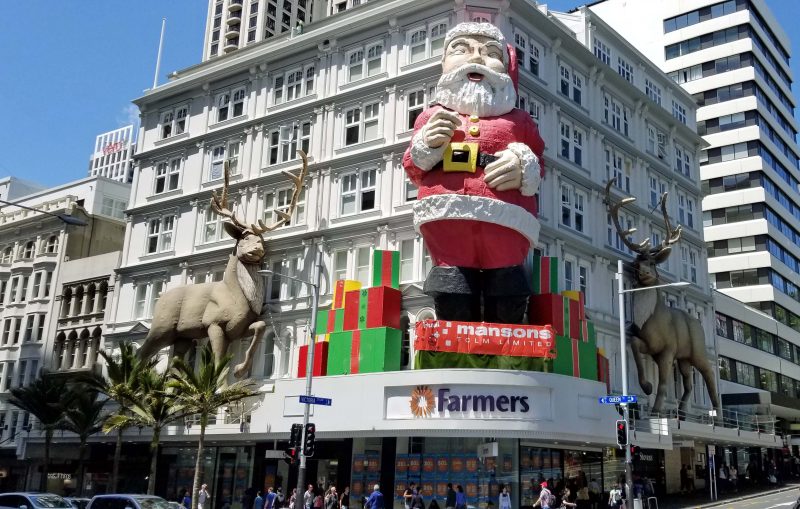
The main attraction for us today was the Sky Tower, the iconic landmark of Auckland. The Big Question: Shall we go up the tower during the day and see everything clearly, or shall we wait until evening, when the lights of the city will twinkle into the distance? No problem. For an additional $3 above the senior discount ticket price, we had unlimited access to the top of the tower for 24 hours (within operating hours, of course).
For $225 (NZD) you can also buy a ticket for the SkyWalk and SkyJump. I have a strong will to live, so I voted against that, but we watched other people do it. After you buy your ticket to drop, an attendant opens the locked gate and you climb a few stairs to a platform to be outfitted and tethered to the apparatus that will take you to the top of the tower. This takes 15-20 minutes. Surprisingly, you make the upward journey feet first. I assume the large weight keeps you from swinging around too much in the New Zealand wind.
Question: Why not take the elevator up?
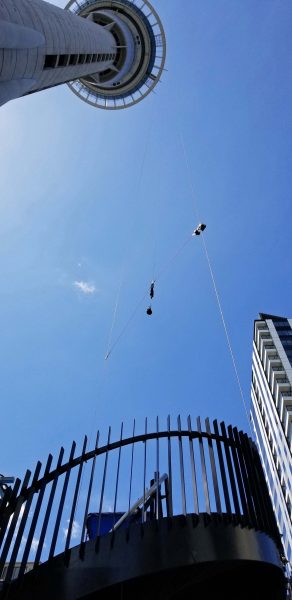
Then it’s another 20-25 minutes before you actually make the drop. I assume this is how long it takes to walk the 360 degrees around the 630-foot high SkyWalk before taking The Plunge. Here’s the guy from the above photo on his way down.
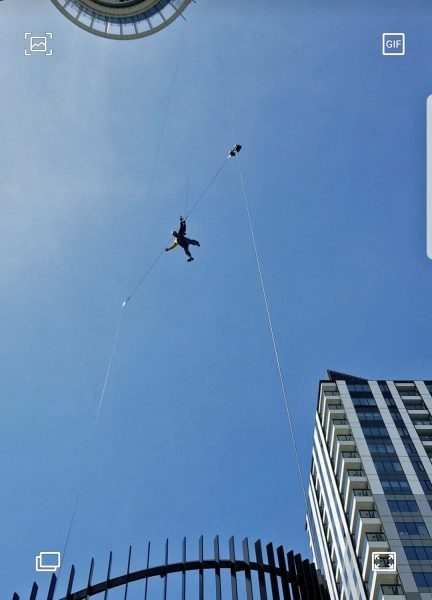
We later talked to a man and his son who had made the jump/fall. They had previously jumped out of airplanes and admitted (slightly disparagingly) that this is not a free-fall. As in “anyone can do this.” (Not me.) They described it as a “very controlled drop.” Notice in the photo above that the person is tethered to a horizontal line that is attached to three vertical lines (one attached to the person). This would certainly make it possible to control the speed of the fall. Still, the drop is 630 feet, and my video of this guy’s drop was 12 seconds, so it’s a short-lived thrill for $225. There’s a point near the base where the brakes are apparently applied, because the falling man slowed dramatically before touching the ground.
Then it was time for Ted and me to go up the tower–in the express elevator, not by wires. The views (also 360 degrees) are great. See the hills in the photo below? Those are some of the 80 dead volcanoes in Auckland.
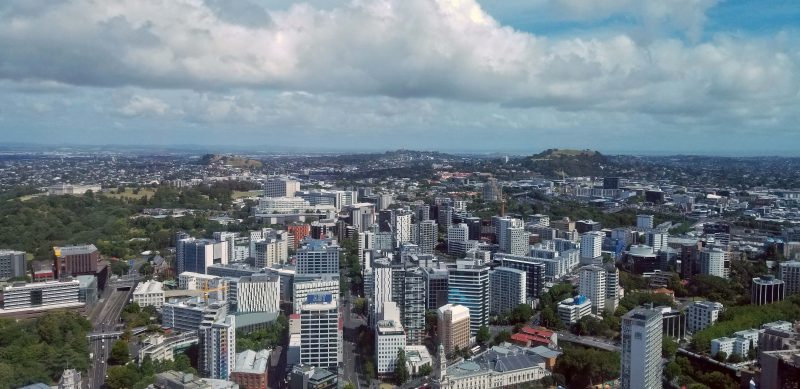
Can you find McDonald’s?
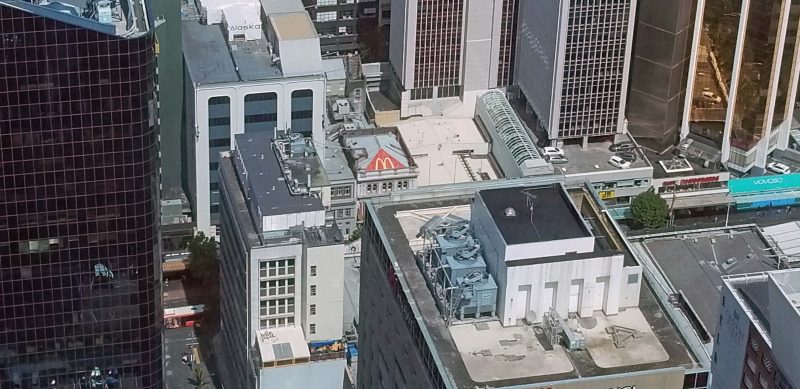
The pink road is part of the annual breast cancer run.
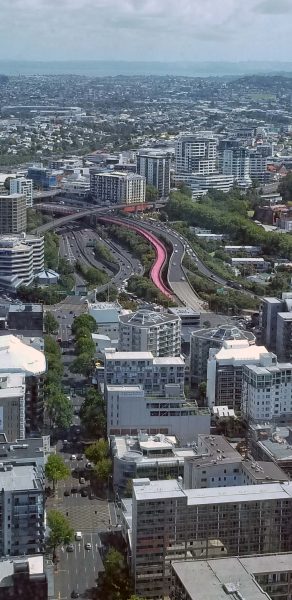
I have no idea what the dots signify at this intersection.
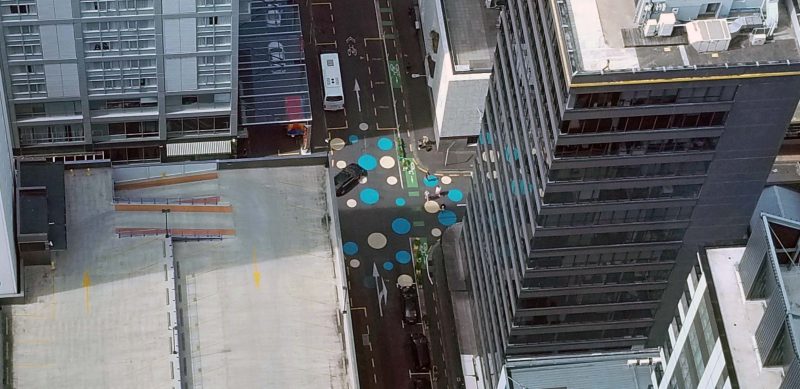
Auckland is known as the “city of sails.” It definitely has enough wind for sailboats. You can see the harbor bridge in this photo, as well as a marina filled with sailboats.
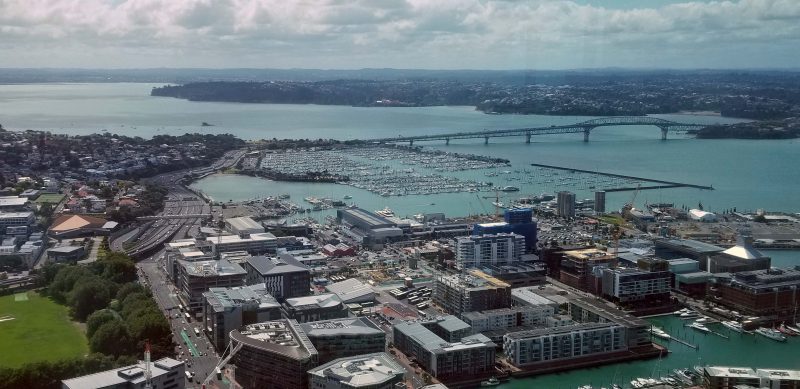
While we were on the Sky Deck, we took time to enjoy the view and some ice cream. As we were eating, another SkyFall daredevil dropped past this window, adding a little thrill to our ice cream treat.
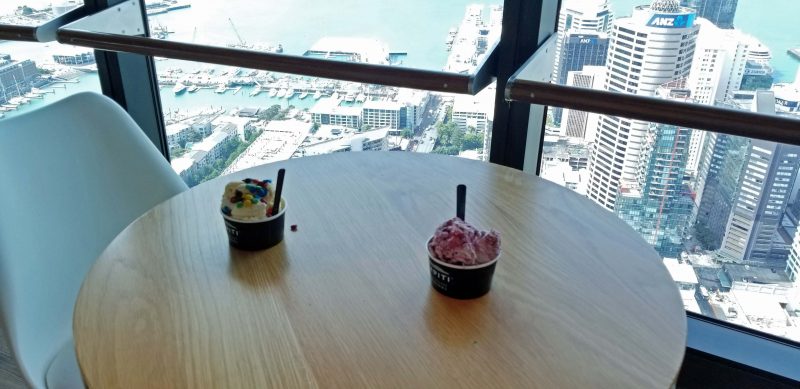
When we went up the tower after dinner, we were glad we’d gone in the daylight. At night, it was obvious that the windows are filthy–not that I want to be the one to wash them. Even worse, the windows are angled outward so people can look almost straight down, but the interior ceiling lights are on, making it difficult to take a picture without the reflection of the interior lights. Making my best effort, here’s the pink road again–at night (on the right).
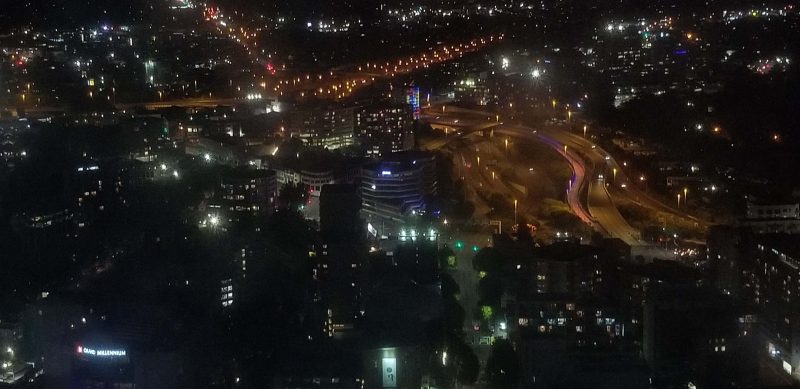
Yeah, whatever. What does that mean? Is it a company name? An expression of indifference? A social statement of helplessness?
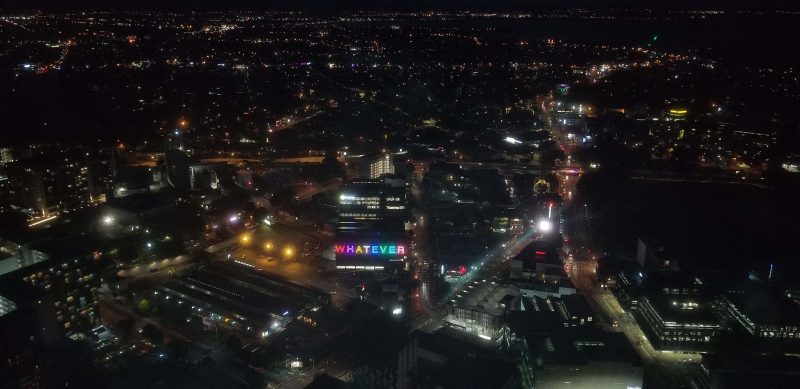
Here’s a picture of the harbor bridge at night.
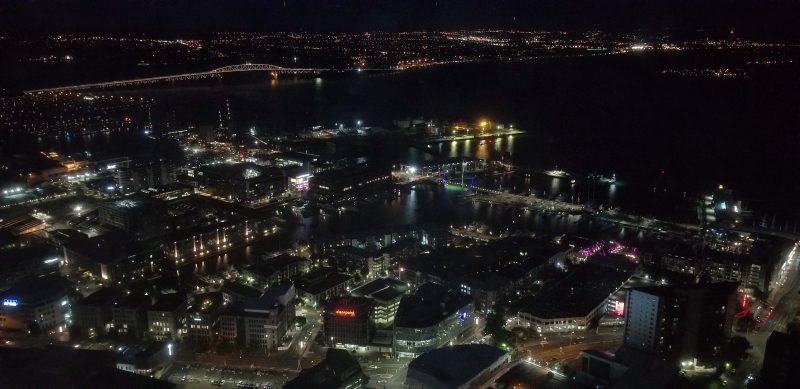
Moon over Auckland. A beautiful summer evening.

I took pictures of the Sky Tower by day and by night. It’s a pretty landmark either way.
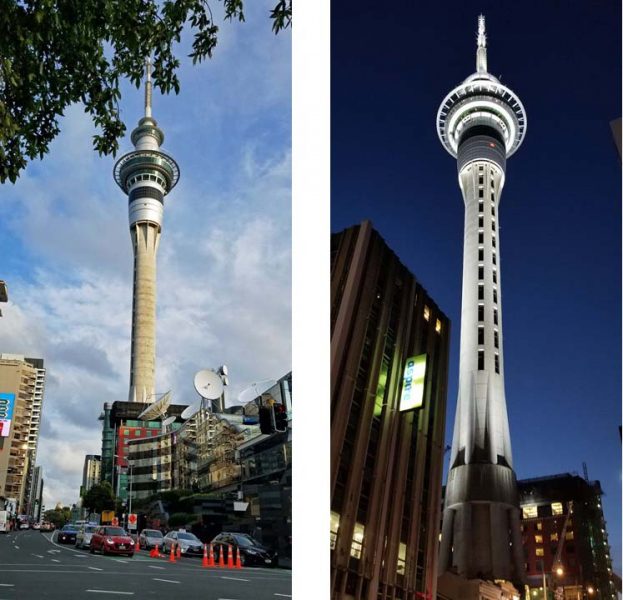
After our Sky Tower time, Ted and I walked along the waterfront for a little while, then back to our harborside hotel. Last night was our final night onboard the Viking Orion–our home for the past 30 days. We’ve enjoyed our cruises and are sorry they will be ending, but our vacation isn’t over, and it’s always better to leave while you wish you could stay rather than staying until you can’t wait to for it to end. Here’s our ship, ready for its next group of passengers who will be cruising from Auckland to Melbourne–the reverse of what we’ve just done.

Tonight’s onboard entertainment was provided by a group called “Mana Maori.” Mana means a special essence of life, so the performance featured a selection of Maori dances interspersed with spoken information about the Maori culture and some of its dances.
This dance is a peaceful, “let’s have fun together” dance. The skirts are made out of flax, like the demonstration we saw in Rotorua yesterday.
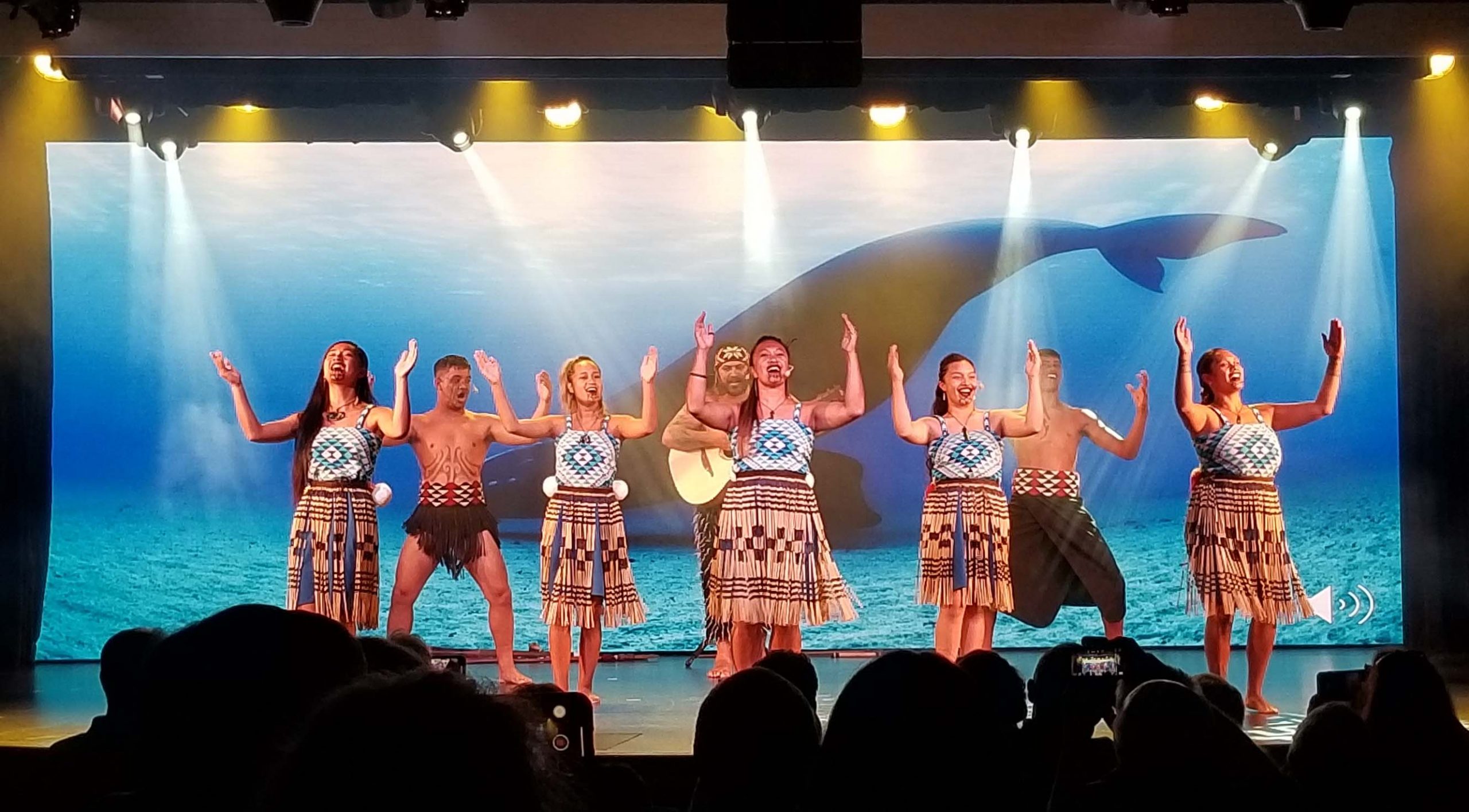
Here’s a celebratory dance in which the women swing white balls on strings around themselves in a variety of patterns. To keep their hands and wrists loose for this, they kept shaking them rapidly between dances. I tried shaking my wrists that quickly, but it’s like belly-dancing or Polynesian hip-wiggling dancing–it obviously takes a lot of practice to make your joints that loose!
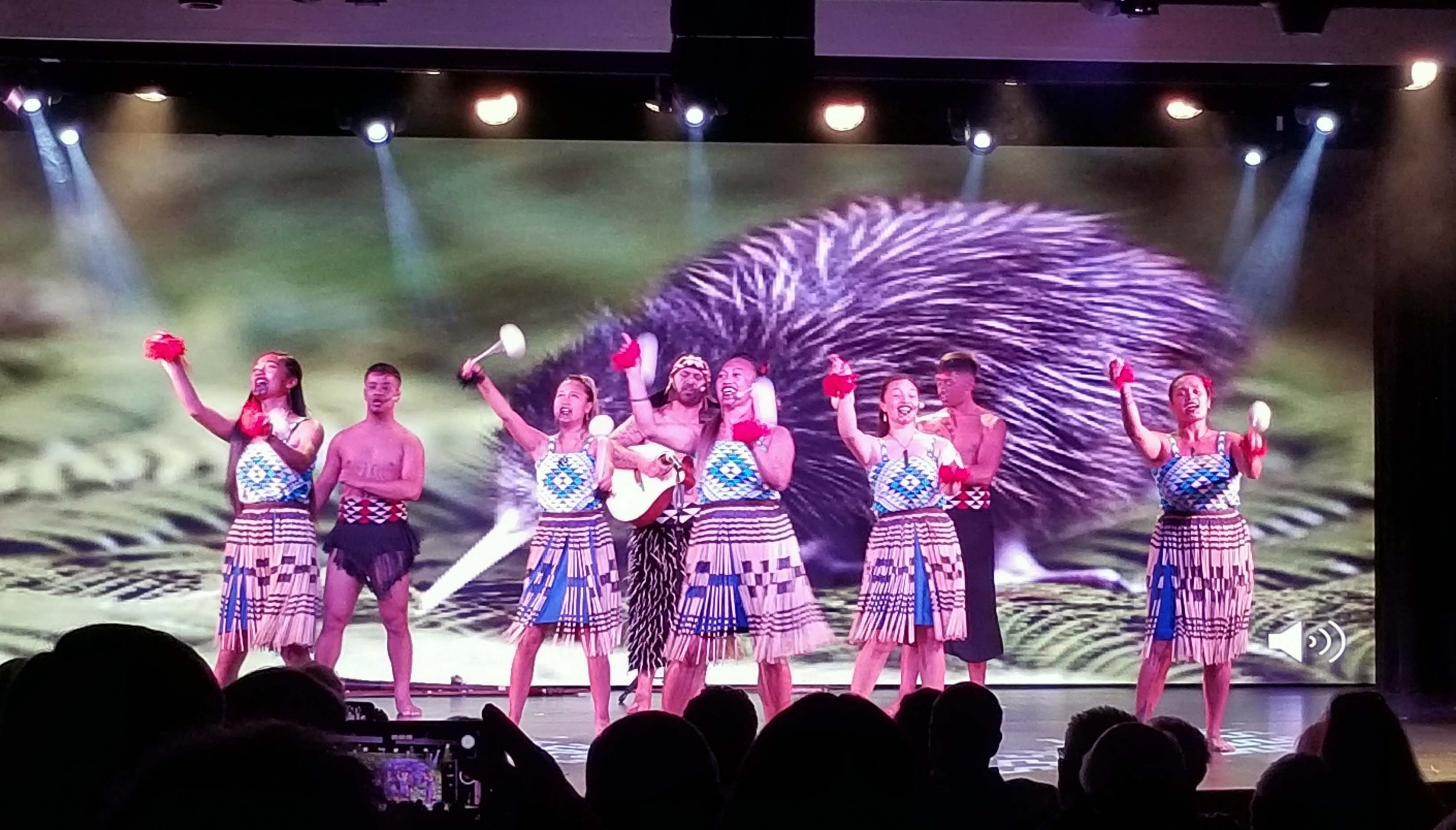
My final example from the performance is a war dance. The purpose is to pump up the warriors and to frighten the enemies. Maoris stick out their tongues as far as possible to look fierce. The guy on the right in the photo did a great job of looking fierce. I didn’t want to meet him on the battlefield. Strangely, at the same time, he looked like he could be a lot of fun.
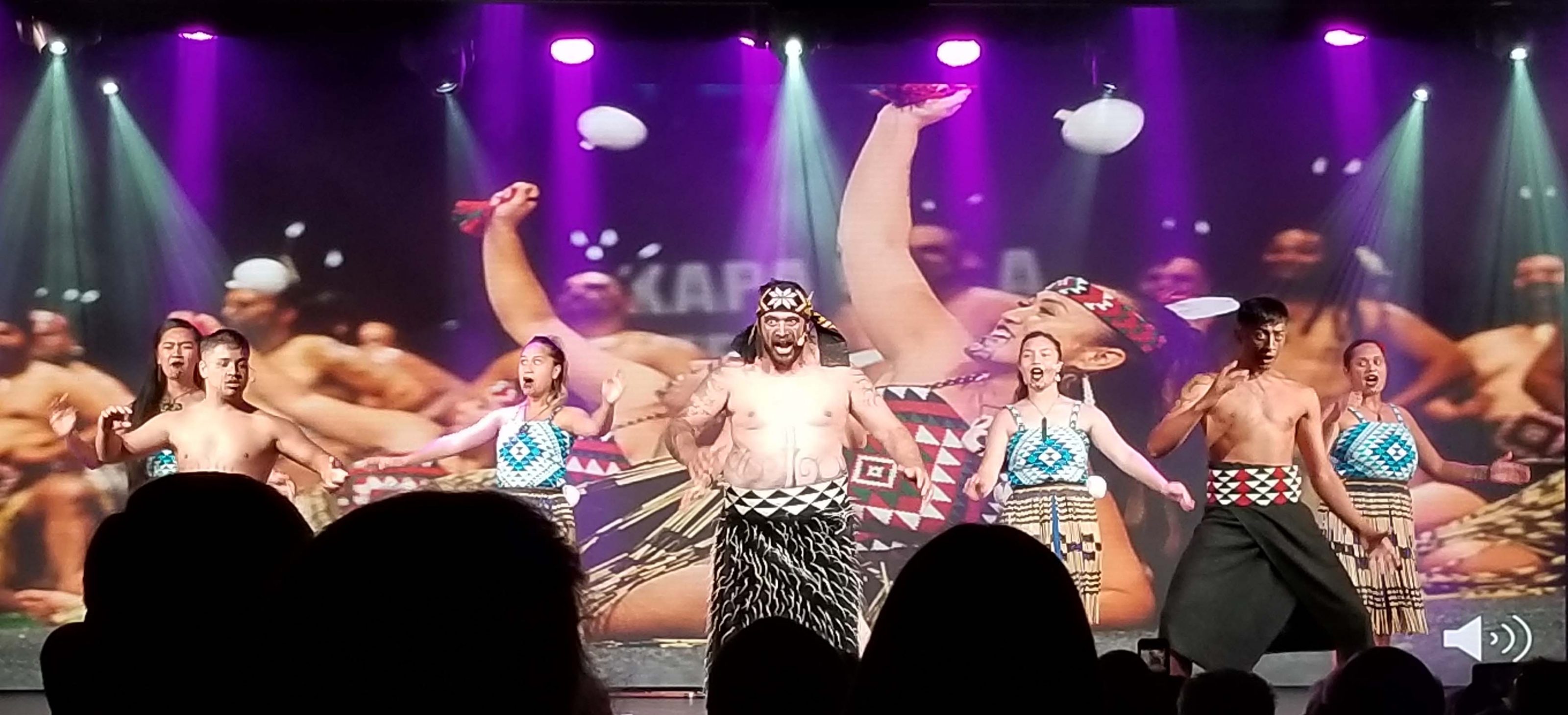
Author’s thoughts: What would happen to racial relations in the U.S. if we followed New Zealand’s example? In 1987, New Zealand passed a law to recognize English, Maori, and sign language as the official languages of the country. After years of punishing Maori people for speaking their native language, Maori is now a required language course in all schools. In addition, New Zealanders recently recognized that history cannot be ignored or buried; it is an integral part of cultural development in a country. As a result, in September 2019, Maori history became a compulsory subject in all schools. What if American schools included the histories of the indigenous Native Americans, the imported African Americans, and other groups of immigrants–including their contributions to American culture–rather than simply mentioning wars, treaties, and laws related to those groups whose histories are embedded in our culture. We are all people, we all have value, and we all like to be recognized for our value as human beings. Think about it.
Ted and I spent today at Rotorua on the northern side of NZ’s North Island. The area is known for its geysers, steam vents, and hot mud pools. We had to drive over an hour to get to Rotorua, and we passed miles of pretty beaches along the way.
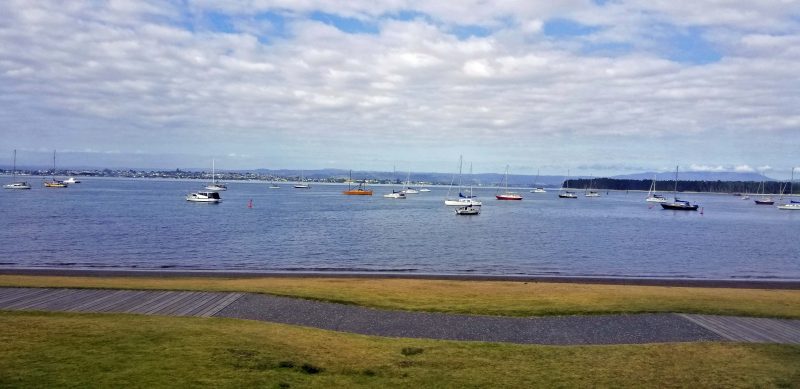
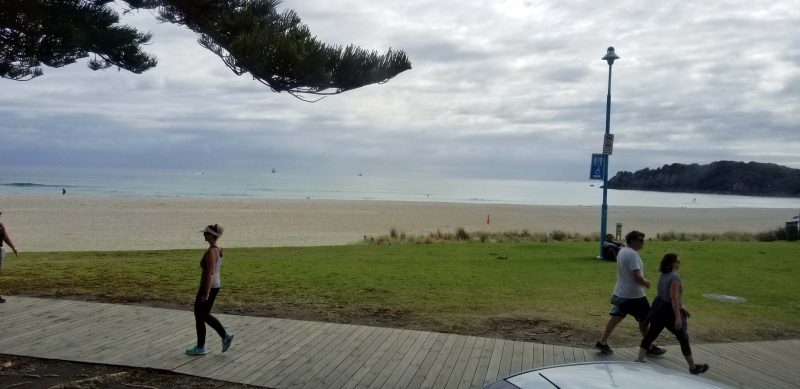
We had a five-part day at Te Puia in Rotorua: visits to the Maori cultural center, followed by the Maori heritage workshop, lunch, a walk through the active geothermal area, and a visit to the kiwi habitat.
The cultural center was very much like the New Zealand part of the Polynesian Cultural Center that we visited in Hawai’i two years ago, but with the addition of a welcoming ceremony in which we took part. We selected a chief from our group (George), and he received instructions about his role in the ceremony. To begin the ceremony, a warrior of the tribe attending the ceremony approached the chief (George), making war-like noises and actions. George did not react (indicating he wanted peace, not war), so the warrior offered George a leaf as a sign that the warriors are attending in peace. The chief (George) accepted the leaf, gave the warrior a strong handshake, and bumped noses with him twice. This is a sign of sharing the breath of life and reminds us that we all live in this air together. One of the Maori also told us this is why the Maori have flat noses.
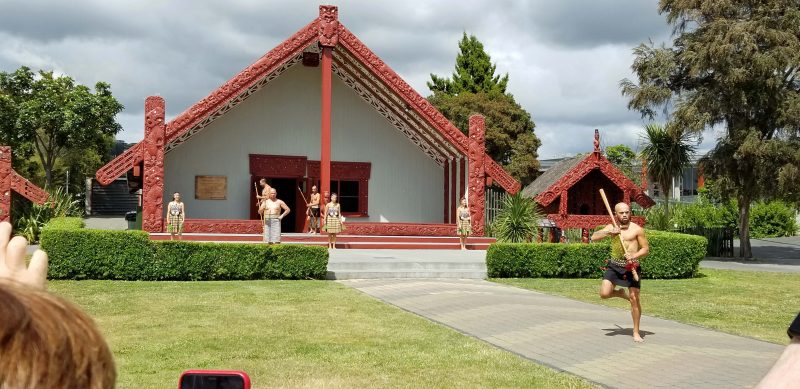
Inside the building, a performing group did six or seven cultural dances–some with the men performing, some with the women performing, and some in which they danced together, including a love song dance used for marriages. The white streaks above the girls’ heads in the second photo below are sticks that they toss back and forth–training for quick hand-eye coordination which is helpful in battle. We were reminded that the Maori don’t lose wars. They are the only indigenous tribe in the world that was not defeated by its invaders (the British). We were also reminded that early Maori were cannibals.
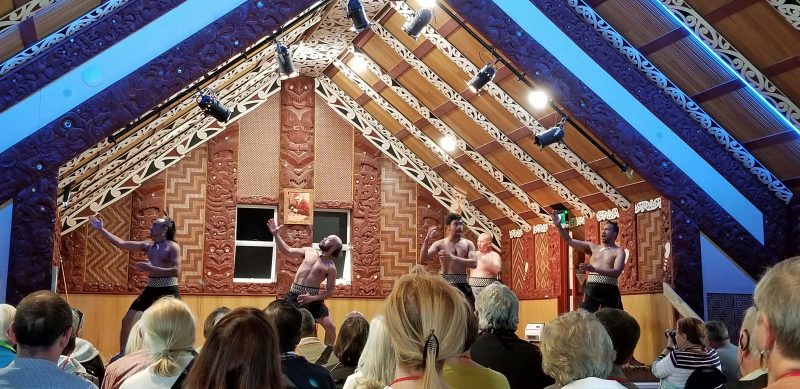
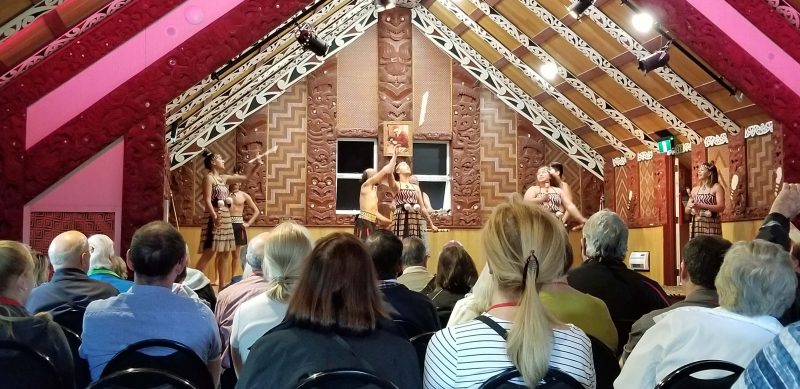
A number of men from our tour group were invited to come onstage to learn a haka–a chant that warriors (including the All-Blacks, NZ’s famous rugby team) perform to pump themselves up before a battle or a game. Do these guys look pumped up?
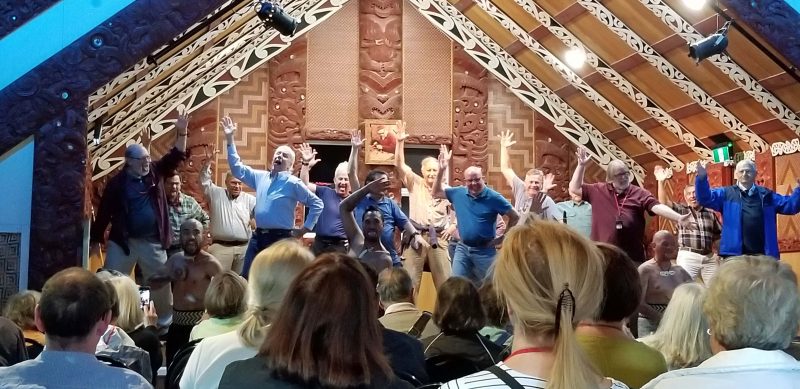
The next stop was the Maori cultural heritage workshop. In recent years, the Maori people have been increasingly recognized as an important part of New Zealand history. The Maori language and history are now required school subjects for all students, and Maori is one of the three official languages of New Zealand (English, Maori, and sign language).
In the recent past, Maori were punished for speaking their native language in school and in public. To keep their culture alive, this intense workshop accepts only five students per term and teaches them to become master craftsmen in the Maori arts. As a nod to progress, some of the Maori objects are now made out of metals and other more durable materials instead of wood. Although most students are young, some older people also take the classes because they did not learn these arts when they were younger.
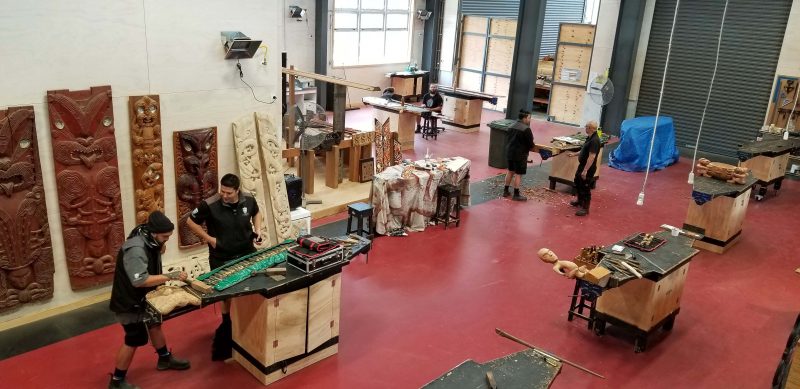
Our guide showed us how the Maori make clothing and other objects out of flax (the green leaf he’s holding). First, lay the leaf on the light-colored board in front of the guide and score it with a sharpened clam shell to determine a pattern, according to marks made on the board in advance. Then use the clam shell to scrape the green outer layer away from the fibrous inner layer (like running a scissors blade over gift box ribbon to make it curl). Doing this repeatedly separates all the fibers and also coats them with wax from the outer layer, making the fibers stronger (the tan drooping part of the leaf the guide is holding). The part of the leaf with the pattern (white marks on his leaf) remains and is stained to produce the desired pattern. To make stronger fibers for belts, etc., the guide rolled the fluffy, separated fibers together by holding the two ends and running the length of the taut fibers up and down his thigh. We had a chance to hold his finished product and to test its strength. Very soft loose fibers; very strong rolled fibers.
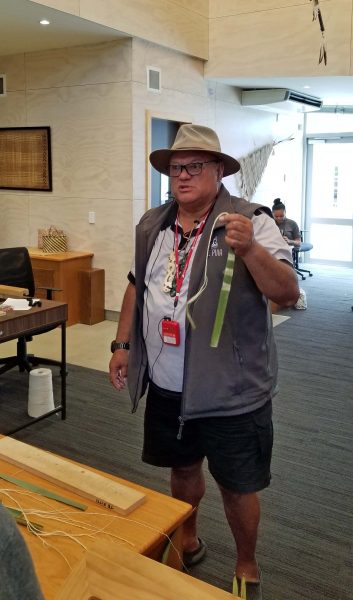
Here are some wrap-around skirts the Maori make from the flax leaves.
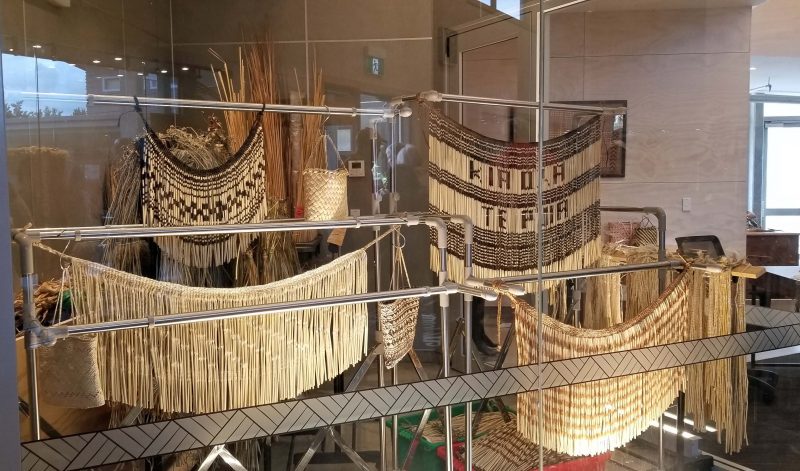
There are carvings of Maori gods along the pathways of Te Puia and each has its name beneath it. Our guide told us that the Maori alphabet has no f, but the wh makes an f sound. That means this god’s name is pronounced “Fera.” Sticking the tongue out as far as possible is a Maori gesture of fierceness.
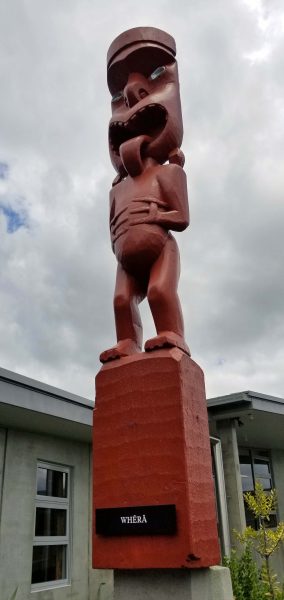
After lunch, we walked through the main part of the geothermal field. The mud fields don’t look spectacular, but they are dangerous. What looks like solid ground in these areas probably isn’t. As our guide put it, the good thing about falling into these is that you won’t have arthritis anymore; the bad thing is that your bones will be very clean, because you will be that well cooked. The mud in the second picture was actually bubbling because it was so hot. The arrows point to some bubbles that are bursting at the surface.
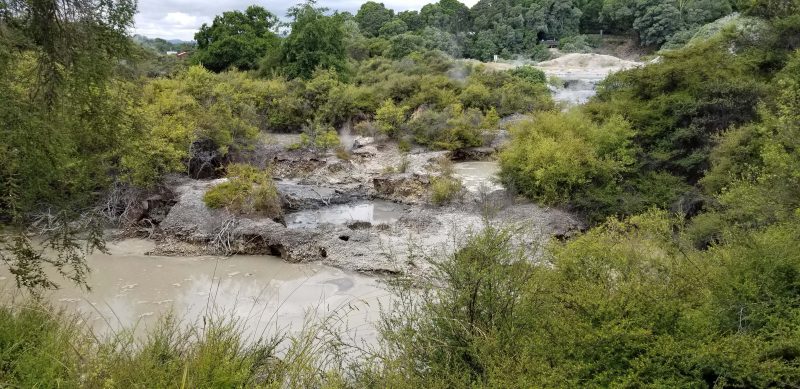
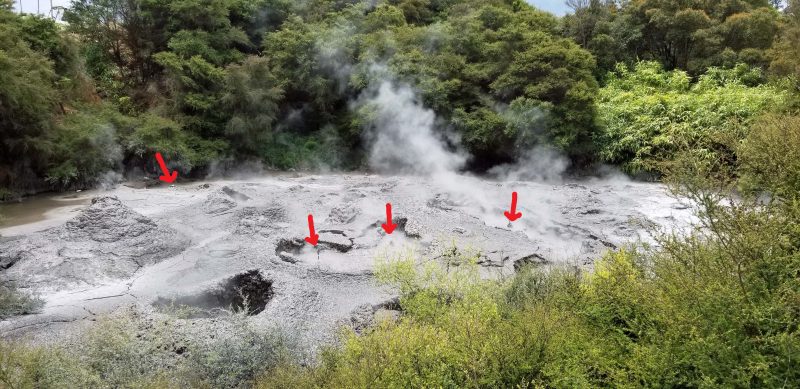
There are steam vents everywhere in this area. We could feel the warmth as we walked by them.
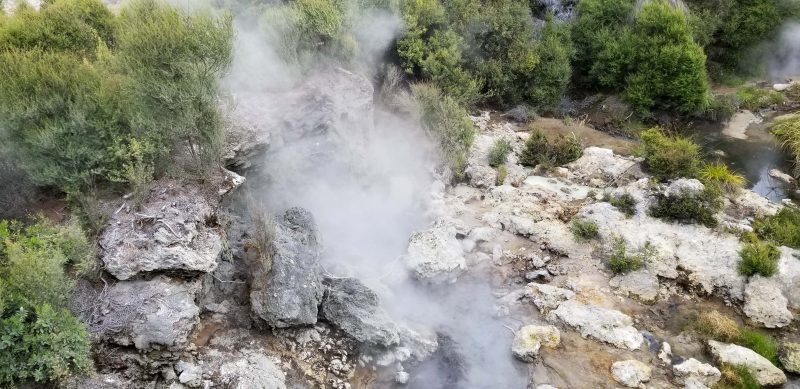
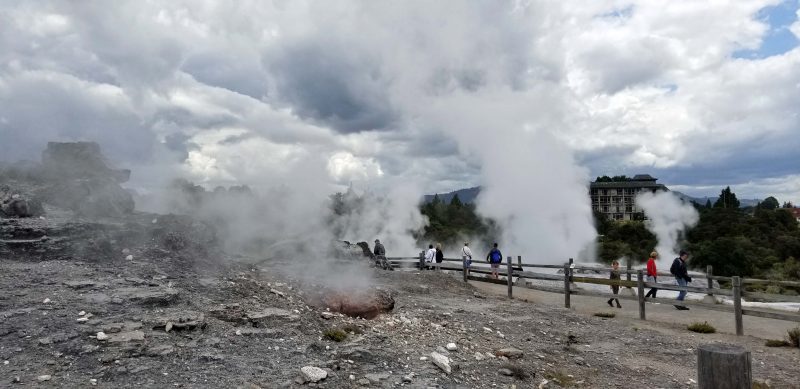
This is the largest geyser in the southern hemisphere (i.e., New Zealand). It is very active and erupts for about 40-50 minutes, then rests for about 20 minutes before erupting for another 40-50 minutes.
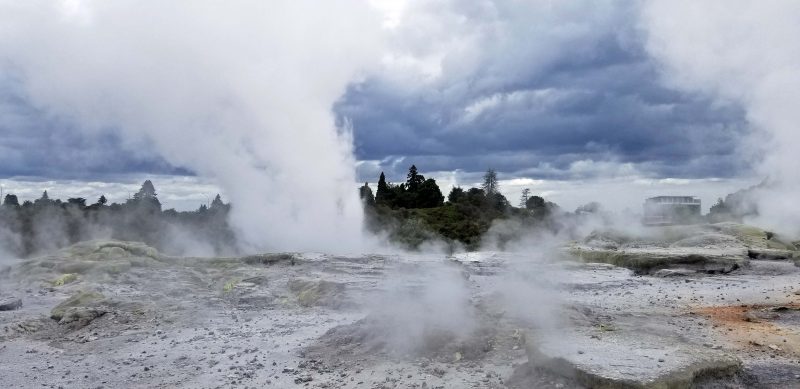
The lake on the right in this picture ranges from 50-100 degrees. It is illegal to swim in it, but our guide said people have been swimming in it for hundreds of years anyway. It’s very sulfurous, so it’s probably good for what ails you.
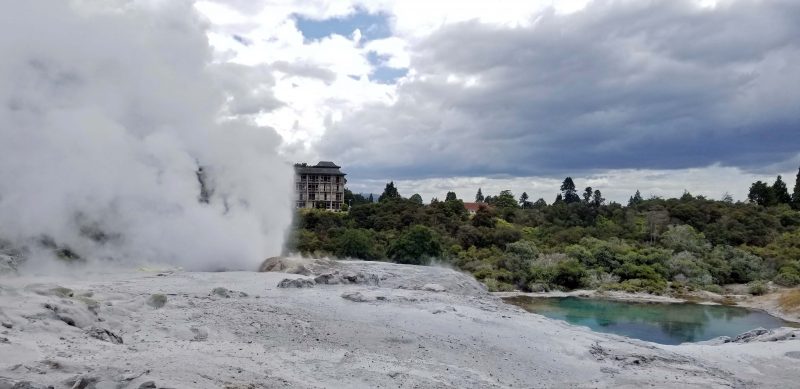
Our tour did not include a steam-cooked picnic lunch, but that’s an option. When you arrive at the park, you can order your meal. It’s put into the oven that straddles a steam vent in the first picture below. When it’s lunchtime, your meal has been cooked in a natural pressure cooker and is served to you at a picnic table in the geyser field.
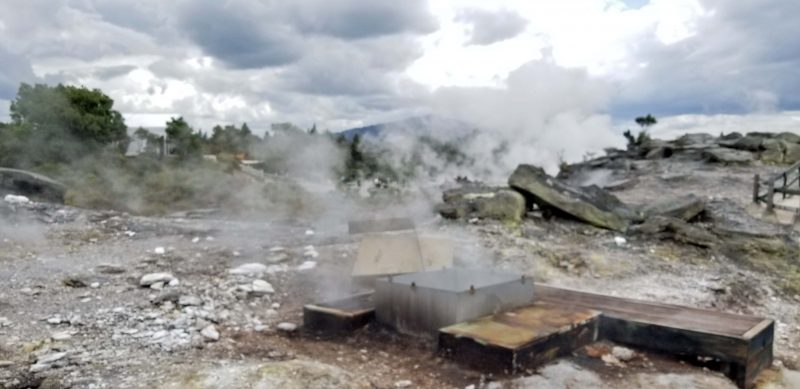
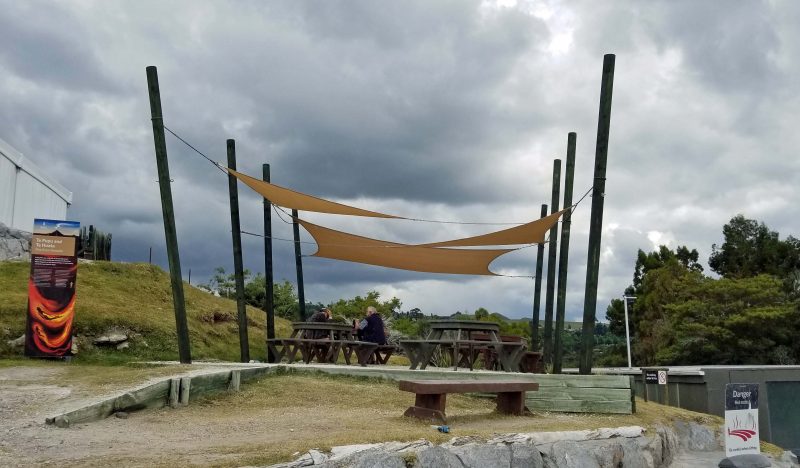
There are steam vents all around this area of NZ, including on private property. Some people fashion a lid for a steam vent in their yard and put their dinner into the vent before leaving for work. When they come home, dinner is ready–a natural slow-cooker. You can see by this picture how widespread the steam vents are–there’s steam everywhere. In fact, the entire city of Rotorua smells like sulfur, but the people living there don’t even notice it and we didn’t either after being there all day.
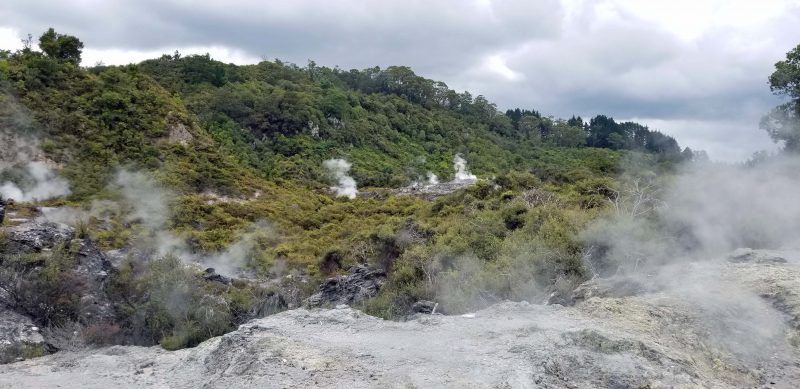
Our last stop before heading back to our ship for dinner was the kiwi bird sanctuary. Kiwis like to sleep during the day and come out at night, so the sanctuary has a dark indoor habitat for some of the birds. No photos were allowed in the darkened building and we were required to remain silent because light and noise disturb the kiwis. I settled for a picture of a stuffed kiwi bird on display.
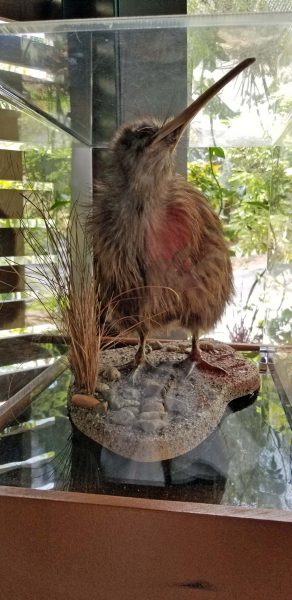
Ted and I have now seen geothermic land features in Yellowstone, Iceland and New Zealand. In our opinion, Yellowstone is the best place to see them because there’s such a wide variety of geothermal features in that park. Iceland is second, and we rank New Zealand third. All of them were worth seeing.
One thing Ted and I have noticed about combining two consecutive cruises (Bali to Sydney; Sydney to Auckland) with the same cruise line is that there’s some repetition in shipboard activities. A happy repetition is the choco-fest event. Tonight was the night to repeat that one.
For about 45 minutes, we watched the chef’s staff bring in tray after tray of chocolate goodies. Whatever they brought and placed on the table was then moved–sometimes very slightly–by the head chef so everything would be perfect. That colored stuff (blue, green, white) is sugar, boiled and combined with frosting, then formed into shapes for decoration.
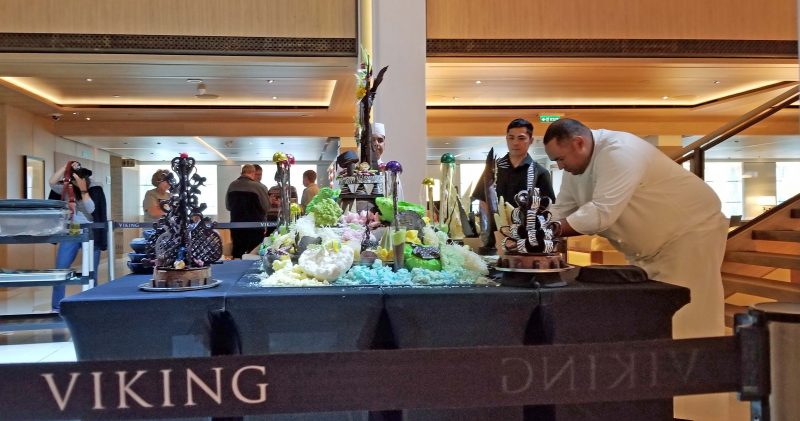
Ted and I chuckled when we saw the staff bring in a blue plastic crate that busboys use to carry dishes around, then wrap it in a tablecloth and set it on the table to use as a platform.
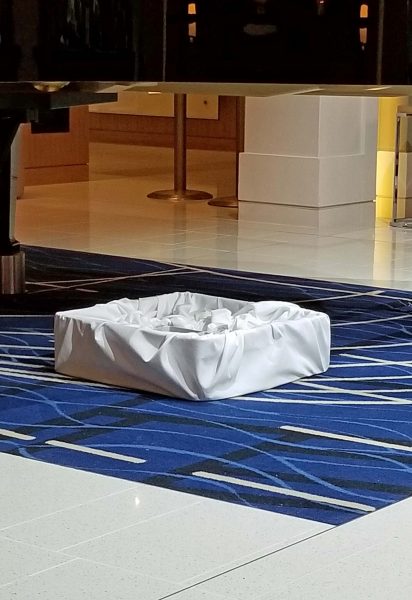
Here comes the chef’s pièce de résistance.
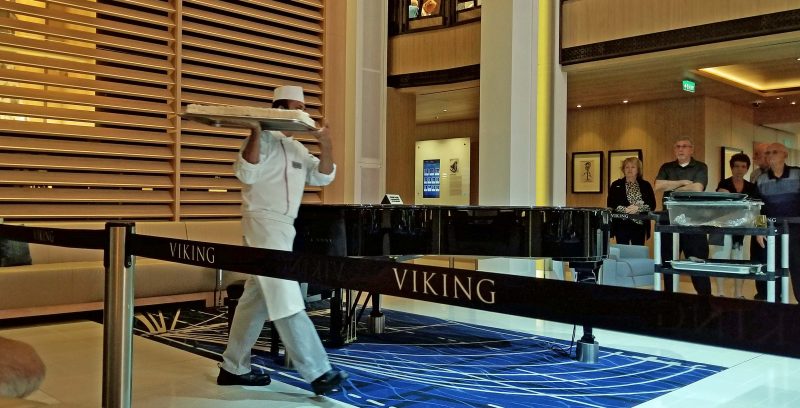
The chef helps the staff set it carefully on the table.

How do we know it’s tonight’s masterpiece? Because immediately after placing it, the chef and staff lined up to take pictures of it.
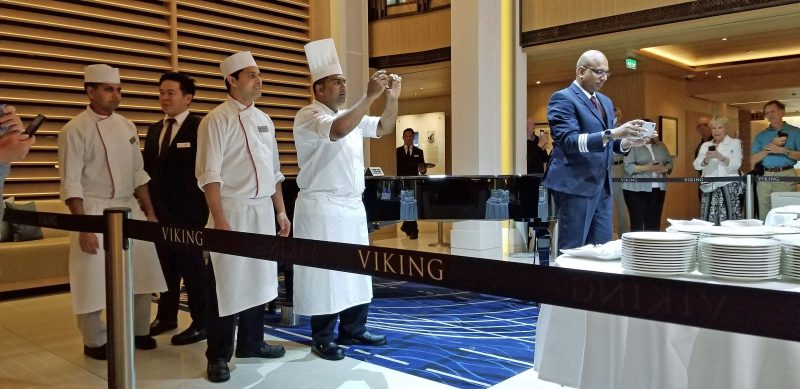
Here it is–a special cake bringing attention to the severe fires in Australia, with the Australian flag, a koala, and a kangaroo with a joey in her pouch.
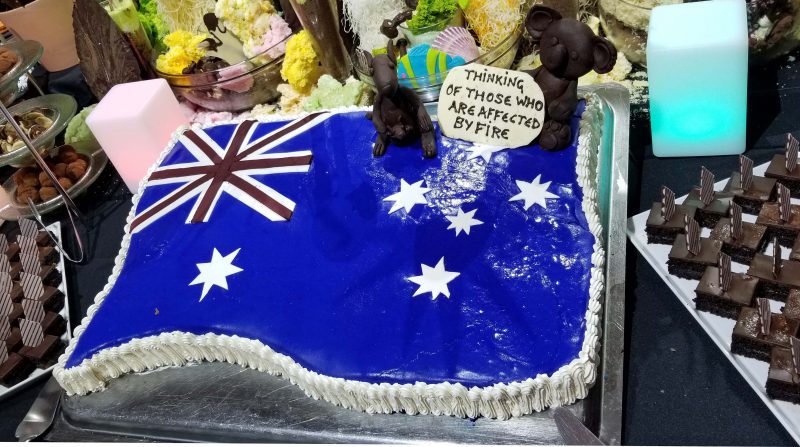
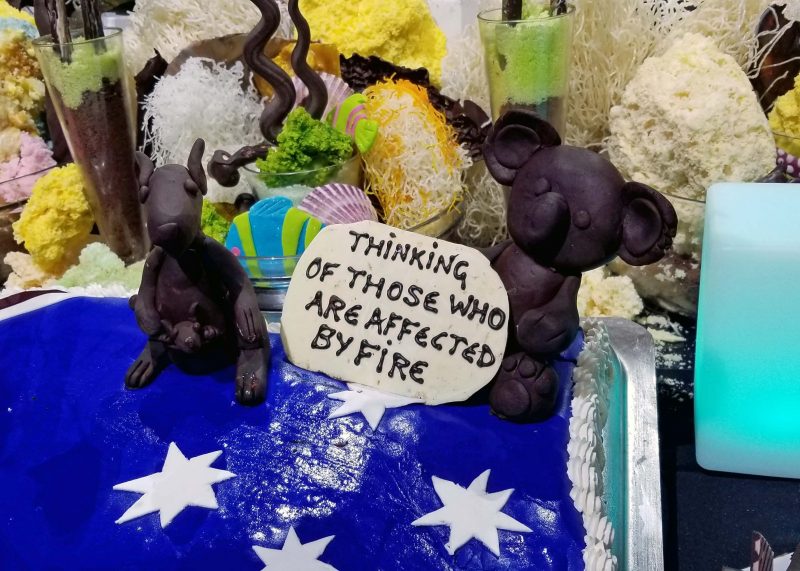
Here’s the finished table with chocolate galore. But Mr. Chef, . . . I saw that “Great Barrier Reef” piece of chocolate two weeks ago. Remember that busboy crate I mentioned above? Look at what the fondue pot is standing on.
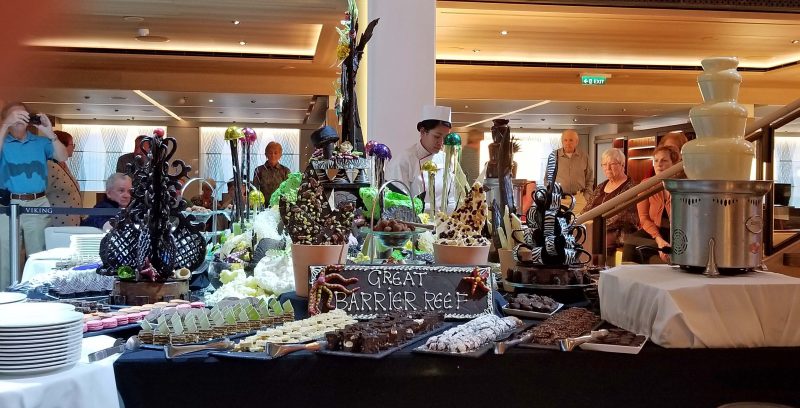
Let the gorging begin.
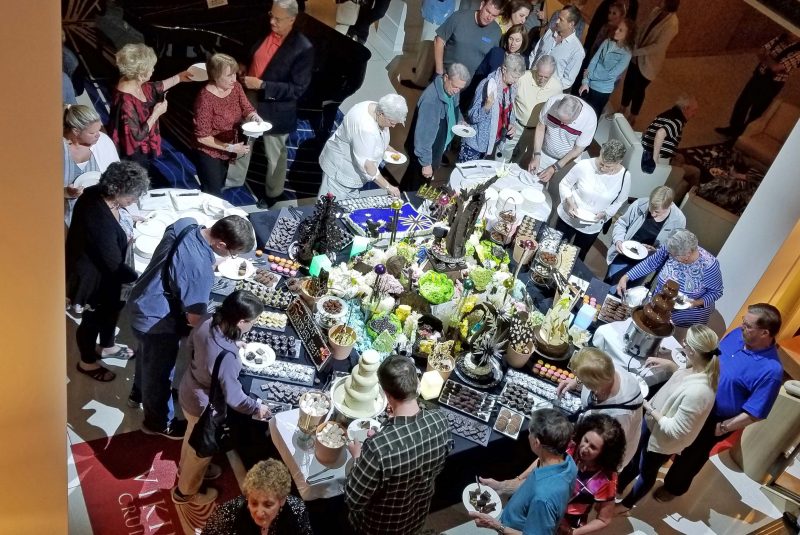
Author’s note: Comments overheard from onlookers during this process included “I think I feel a cavity coming on” and “If this were Carnival instead of Viking, everything would be gone before it was all set up.”
I saw some interesting things as we passed through Napier this morning. One was a restaurant called The Frying Dutchman. My high school was the home of the Flying Dutchmen and had a wooden shoe with wings as its logo.
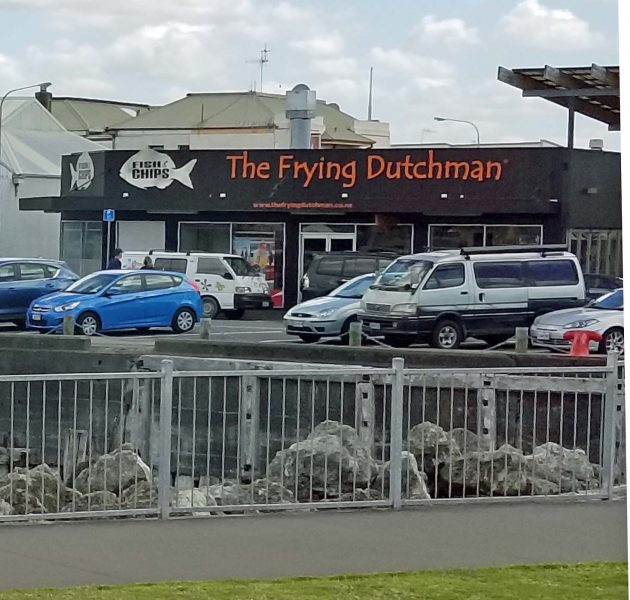
I also got a kick out of the Donut Robot. The cashier was sitting in the front behind the raised awning. According to the message on the back, he offers “hot, freshly made donuts all day long and tomorrow.” I’m not sure about the next day.
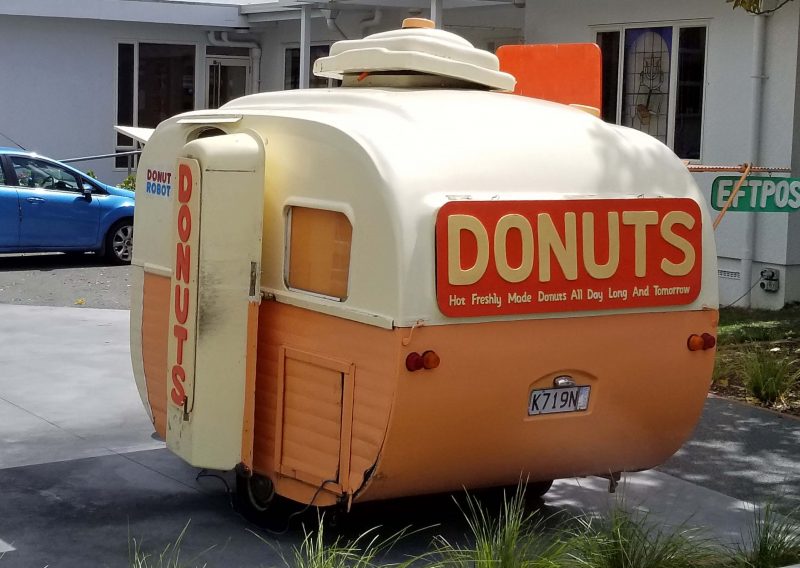
When we returned to our stateroom after our morning city tour, Ted and I heard band music. We went out onto our terrace and saw a band, a row of antique cars, and drivers dressed in vintage clothing singing along with the band. One of the city excursions today was a four-hour city tour in an antique automobile. The cost: $249 per person. After the tour, I think the drivers and the band stayed to perform as a farewell from the city to its visitors.
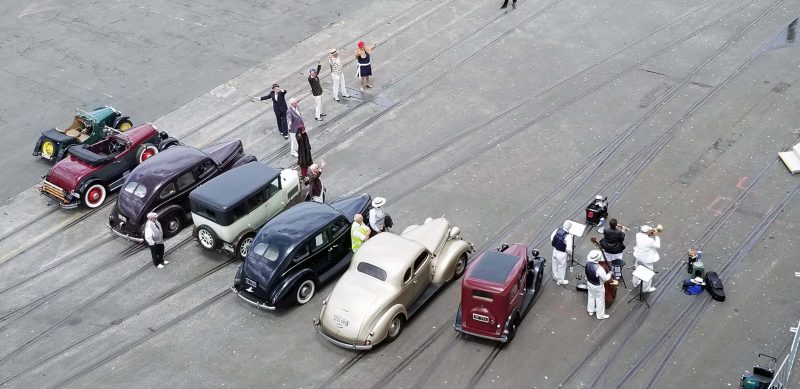
Ted and I decided to have lunch at the Pool Grill today. It’s the most casual restaurant onboard, allowing people to come in swimsuits (with a cover-up). It’s also a pretty setting and has great hamburgers.
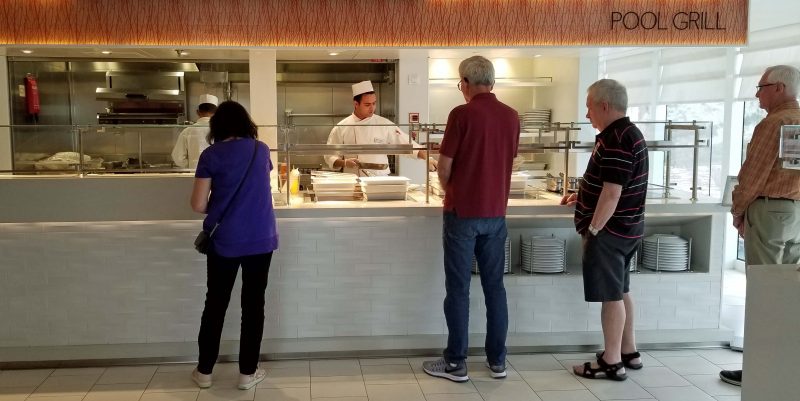
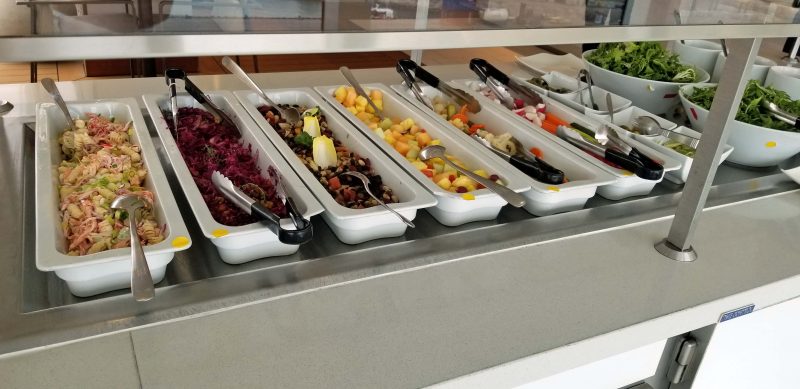
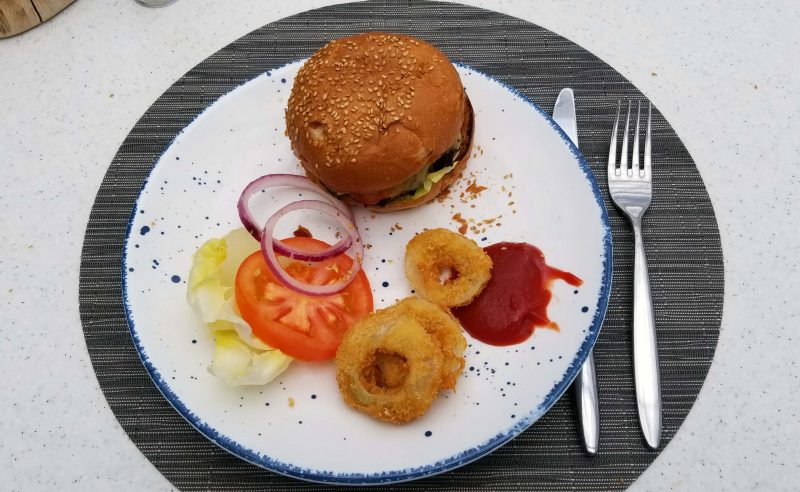
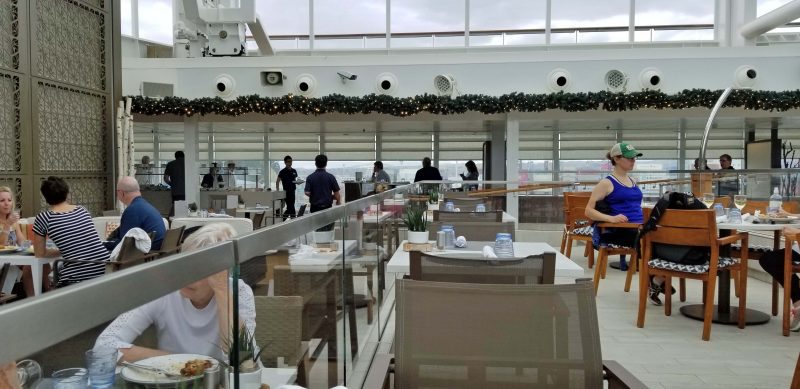
The Pool Grill seating is–where else?–poolside. In the photo below, you can see a man showering before entering the pool. He looks like it’s the best shower he’s ever had.
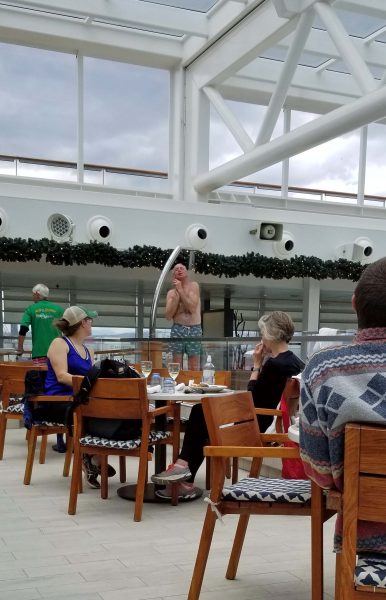
Our time onboard our ship will end in a few days so, after lunch, we made use of the ship’s free laundry (one on each deck) to freshen our clothes for our upcoming off-ship time in Auckland and Sydney. It was tricky getting to and from the laundry because the Pacific Ocean decided to get active. The swells this afternoon are higher than we had in the Tasman Sea.
As I was heading out of our stateroom with a load of laundry, I found myself doing a little quick-step run toward the door because the ship rolled in that direction. People are zigzagging down the hallways as the ship rocks back and forth. I thought the swells were big when we left the port of Napier, but they keep getting bigger. My camera captured a rainbow above a splashing wave. I took these pictures from Deck 5 and the swells always look much higher closer to eye level. I’m looking forward to the ship rocking us to sleep tonight.
